*** START OF THE PROJECT GUTENBERG EBOOK 46533 ***
|
Every attempt has been made to replicate the original as printed.
Some typographical errors have been corrected;
a list follows the text.
In certain versions of this etext, in certain browsers,
clicking on this symbol  will bring up a larger version of the image.
will bring up a larger version of the image.
Contents
Illustrations
Index:
A,
B,
C,
D,
E,
F,
G,
H,
J,
K,
L,
M,
N,
O,
P,
R,
S,
T,
U,
V,
W,
Z
(etext transcriber's note) |

{i}
The Story of Prague
{ii}
The Mediæval
Town Series
VERONA.*
By Alethea Wiel.
CHARTRES.†
By Cecil Headlam.
CAIRO.†
By Stanley Lane-Poole.
BRUGES.†
By Ernest Gilliat-Smith.
ROME.† [2nd Edition.
By Norwood Young.
FLORENCE.† [3rd Edition.
By Edmund G. Gardner.
ASSISI.* [2nd Edition.
By Lina Duff Gordon.
CONSTANTINOPLE.*
By William H. Hutton.
MOSCOW.*
By Wirt Gerrare.
ROUEN.† [2nd Edition.
By Theodore A. Cook.
NUREMBERG.* [3rd Edition.
By Cecil Headlam.
PERUGIA.* [4th Edition.
By Margaret Symonds and Lina Duff Gordon.
TOLEDO.*
By Hannah Lynch.
The volumes marked (*) are 3s. 6d. net in cloth, 4s.
6d. net in leather; those marked (†) are 4s. 6d. net
in cloth, 5s. 6d. net in leather.
{iii}
{iv}

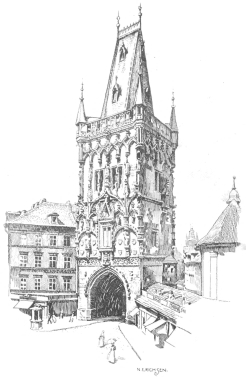
The Pulverthurm Prague
{v}
The Story of PRAGUE
by Count Lützow
Illustrated by Nelly Erichsen
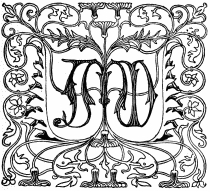
London:
J. M. Dent & Co.
Aldine House, 29 and 30 Bedford Street
Covent Garden W.C.

 1902
1902
{vi}
All rights reserved
{vii}
To
Professor MORFILL, M.A.
Corresponding Member of the Royal Scientific Society
of Bohemia, who has so largely contributed
to making Bohemia known to England
{viii}
CONTENTS{ix}
{x}
{xi}
LIST OF ILLUSTRATIONS
| | PAGE |
The Pulverthurm (photogravure) | Frontispiece |
Tomb of Ottokar I. | 6 |
The Jewish Cemetery | 9 |
The Hradcany and Ottokar Towers | 13 |
Charles IV., from Triforium of St. Vitus | 16 |
The Gothic Projection, Carolinum | 19 |
The Bridge Tower of the Malá Strana | 27 |
Statue of St. John Nepomuk on the Bridge | 30 |
Medals of Hus | 33 |
Medals of Hus | 39 |
The Bridge Tower of the Old Town | 45 |
The Hradcany | 53 |
View of Prague and Hradcany Castle | 61 |
The Town Hall and Market-Place | 71 |
South Porch of Tyn Church | 75 |
Clock Tower in Town Hall of Staré Mesto | 80 |
Chapel of Town Hall | 83 |
Wenceslas Chapel, St. Vitus’s Cathedral | 91 |
The East Gate of the Hradcany | 97 |
Rudolph II. | 101 |
Tombstone of Tycho Brahe in Tyn Church | 104 |
The Royal Officials are Thrown from the
Windows on May 23, 1618 | 111 |
Battle of the White Mountain, November 8,
1620 | 115 |
The Executions on the Market-Place of the
Old Town of Prague on the 21st of
June 1621 | 121 |
The Dungeon in the Town Hall | 125 |
Bethlehem Chapel | 127 |
The Old Synagogue | 129 |
Secret Seal of the Malá Strana | 133 |
The Oldest Great Seal of the Old Town | 139 |
Gate of the Clam-Gallas Palace | 141 |
The Hall of Vladislav in the Hradcany
Castle | 145 |
The Most Ancient Shield of the Old Town | 148 |
View of Strahov | 150 |
St. Vitus from the ‘Stag’s Ditch’ | 153 |
The Tyn Church | 157 |
The Library, Strahov | 161 |
Most Ancient Arms of the Malá Strana | 163 |
The Powder Tower | 169 |
Door of Old Synagogue | 171 |
Jewish Town Hall and Old Synagogue | 175 |
Chapel of St. Martin | 182 |
Karlov | 186 |
From the Bridge Looking Towards the Old
Town | 188 |
View of the Bridge from the Mills of the
Old Town | 191 |
The ‘Star’ Hunting Lodge | 199 |
The Oldest Great Seal of the Malá Strana,
Thirteenth Century | 200 |
View of Prague in 1606, after Sadeler’s famous
Engraving, in Three Sections
| facing 206 |
Map of Prague | facing 212 |
{xv}
INTRODUCTION
FEW cities in the world have a more striking and feverish historical
record than Prague, the ancient capital of Bohemia and of the lands of
the Bohemian crown. It is a very ancient saying at Prague that when
throwing a stone through a window you throw with it a morsel of history.
The story of Prague is to a great extent the history of Bohemia, and all
Bohemians have always shown a devoted affection for the
‘hundred-towered, golden Prague,’ as they fondly call it. As Mr. Arthur
Symons has well said, Prague is to a Bohemian ‘still the epitome of the
history of his country; he sees it, as a man sees the woman he loves,
with her first beauty, and he loves it as a man loves a woman, more for
what she has suffered.’ Foreigners, however, have not been backward in
admiring the beauties of Prague. The words of Humboldt, who declared
that Prague was the most beautiful inland town of Europe, have often
been quoted, and it is certain that a traveller who looks at the town
from the bridge, or the Strahov Monastery or the Belvedere, will share
this opinion.
Yet Prague is, I think, very little known to Englishmen, and I received
with great pleasure Mr. Dent’s suggestion that I should write a short
sketch of the history of the capital of my country. It has, indeed, to
me been a labour of love. The geographical situation of Prague is to
some extent a clue to its historical importance. Bohemia, the Slavic
land that lies furthest west, has always been the battlefield of the
Slavic and {xvi}Teutonic races, and its capital, Prague, has for more than a
thousand years been an outlying bastion of the Slav people, which,
sometimes captured, has always been recovered. Within the time of men
now living Prague had the appearance of a German city, while it has now
a thoroughly Slav character. The town has therefore an intense interest
for the student of history, and, indeed, of politics. For more than two
centuries a religious conflict, interwoven with the racial struggle in a
manner that cannot be defined in few words, attracted the attention of
Europe to Bohemia, and particularly to Prague; for the battles of the
Zizkov and the Vysehrad were fought within the precincts of the present
city. But it is not only in the annals of war that Prague plays a
pre-eminent part. The foundation of the University for a time made
Prague one of the centres of European thought. Thanks to the enthusiasm
and eloquence of Hus, the endeavour to reform the Church, which had
failed in England, was for a time successful in Bohemia. Though he was
not born at Prague, and died in a foreign country, the life of Hus
belongs to Prague. The traveller cannot pass the Bethlehem Chapel or the
Carolinum without thinking of the great reformer. Though the
iconoclastic fury of the extreme Hussites and the rage of incessant
civil warfare have deprived Prague of many of its ancient monuments, it
is by no means so devoid of architectural beauty as has been stated by
those who, perhaps, know the town only by hearsay. The three ancient
round chapels, dating from the beginning of the tenth century, still
remain as examples of the earliest ecclesiastical architecture of
Prague. The Church of St. George, on the Hradcany Hill, which is now
being carefully restored, is a very fine specimen of early romanesque
architecture. The four towers at the outskirts of the Hradcany, which
date from the thirteenth century,{xvii} are an interesting relic of the
ancient fortifications of Prague. The principal churches of the town,
St. Vitus’s Cathedral and the Tyn Church, frequently enlarged and
altered, recall the vicissitudes of Bohemian history, in which they
played such a prominent part. Ferdinand the First’s Belvedere villa is
one of the finest Renaissance buildings in Northern Europe.
I have found no lack of materials while writing this short note on the
story of Prague. I have of course mainly relied on the old chronicles,
most of which are written in the national language. These almost unknown
chroniclers are little inferior to those of Italy. Their fierce
religious and racial animosities sometimes inspire them, and even carry
away the reader, whatever his own views may be. Want of space has
unfortunately obliged me to quote but sparingly from these ancient
chronicles. Of modern historical works on Prague, Dr. Tomek’s Dejepis
Mesta Prahy (History of the town of Prague) is vastly superior to all
previous works of the present age. This book, written in the
little-known Bohemian language, deserves to rank with Gregorovius’s
Mediæval Rome as one of the greatest town-histories of the nineteenth
century. The twelve volumes of Dr. Tomek’s work that have appeared up to
now only bring the history of the city down to the year 1608. As the
smallest of these volumes is more than double the size of this little
book, it is unnecessary to say that I have not been able to avail myself
of the contents of Dr. Tomek’s book to a large extent. I have mentioned,
in an Appendix to this book, a few of the other works that I have
consulted.
After giving an account of the story of Prague, I have in Chapters IV.
and V. briefly referred to the most prominent objects of interest in the
town. With the exception of the bridge—which every traveller will
cross, however short his stay may be—the town hall {xviii}and the
neighbouring Jewish churchyard, an account of these will be found in
these two chapters. A somewhat fuller notice of the town will be found
in Chapters VI., VII. and VIII., though here, too, it has been
impossible to mention every subject of interest for the student of
history, architecture and archæology. The history of Prague is to so
great an extent that of Bohemia that I have at the end of this volume
given a list of the rulers—princes, afterwards kings—of Bohemia, which
the reader will, I think, find useful.
I have often been told by English friends that Prague is a very distant
and ‘out-of-the-way’ place. I am, I think, entitled to dispute the
correctness of this statement. Dresden, one of the towns most visited by
English travellers, is only four hours from Prague. The train leaving
Dresden at 11.18 reaches Prague at 3.11. Prague is also not distant from
the Bohemian watering-places, Karlsbad, Marienbad and Franzensbad, and
the distance would appear yet smaller were it not for the slowness of
all Austrian, even express, trains. I may add a word on the hotels of
Prague. Of the best of these hotels, three—the Hotel de Saxe, the ‘Blue
Star,’ and the ‘Black Horse’—are situated close to the State Railway
Station and the powder tower, while a fourth, the ‘Victoria,’ is in the
Jungmann Street. In all these hotels the English traveller will often
regret the absence of a reading or public sitting-room. Even when such a
room is provided, it is often closed or used for private card parties.
In late years I have during my many visits to Prague always stayed at
the Hotel de Saxe, and I can conscientiously recommend it. To those who,
for the purpose of study or for other reasons, intend making a somewhat
lengthy stay at Prague, The Pension Finger (corner of the Vaclavské
Námesti and the town park) can be recommended.
It remains to me to thank those who have kindly{xix} assisted me while I was
preparing this little book. As on previous occasions, I have again had
the privilege of frequently consulting Mr. Adolphus Patera, head
librarian of the Bohemian Museum. Dr. Matejka, guardian of the print
room of that museum, has most kindly permitted the reproduction of some
of the treasures contained in that collection. Dr. Jaromir Celakovsky,
archivist of the town of Prague, kindly granted permission that the
interesting old town seals of Prague should be reproduced here.
Monsignor Lehner kindly furnished me with some fresh information on the
subject of early Bohemian ecclesiastical architecture, on which he is so
great an authority. Dr. Zahradnik, canon and librarian of the Strahov
Monastery, has given me much valuable information concerning his ancient
monastery, and particularly concerning the library that he so ably and
skilfully directs. I have also had the privilege of receiving advice
from Professors Kalousek and Mourek.
LÜTZOW.
{xx}
Prague, November 28, 1901.{1}
The Story of Prague
CHAPTER I
Prague at the Earliest Period
THE earliest tales of the foundation of Prague are as those of most very
ancient cities—entirely mythical. Here, as elsewhere, very ancient
legends and traditions take the place of genuine history. Yet a notice
of such ancient towns that ignored these legends would be valueless. It
is almost certain that the earliest inhabited spot within the precincts
of the present city of Prague was the hill on the right bank of the
Vltava or Moldau, known as the Vysehrad (‘higher castle’ or Acropolis).
It is also probable that the ‘higher castle’ was from a very early date
the residence of a prince who ruled over part of Bohemia, and the very
ancient legend that refers to the Vysehrad as the residence of Krok or
Crocus, the earliest Sovereign of Bohemia, is no doubt founded on this
fact. Krok is said to have left no son, but three daughters, Kázi, Teta
and Libussa. Libussa, though the youngest, succeeded her father as ruler
of Bohemia. Libussa is described by the ancient chronicler, Cosmas of
Prague, as ‘a wonderful woman among women, chaste in body, righteous in
her morals, second to none as judge over the people, affable to all and
even amiable, the pride and glory of the female sex, doing wise and
manly deeds; but, as nobody is perfect, this so praiseworthy{2} woman was,
alas, a soothsayer.’ The last words, no doubt, refer to Libussa’s
prophecy of the future greatness of Prague, which will be mentioned
presently.
The great merits of Libussa do not, however, appear to have reconciled
the Bohemians to the rule of a woman. When Libussa had been sitting in
judgment on a dispute between two nobles—brothers who both claimed the
paternal inheritance—the one to whom the princess’s decision was
unfavourable insulted her by exclaiming that it was a shame for a
country to be ruled by a woman. Libussa then declared that she would no
longer rule so ferocious a people. She bade the people disperse and
reassemble on the following day, when she would accept as husband
whomsoever they might select. The Bohemians, however, declared that they
would leave the choice to her and accept as their ruler the man whom she
would choose. Libussa, who here is represented as a visionary or
soothsayer, then said, pointing to the distant hills, ‘Behind these
hills is a small river called Belina and on its bank a farm named
Stadic. Near that farm is a field and in that field your future ruler is
ploughing with two oxen marked with various spots. His name is Premysl
and his descendant will rule over you for ever. Take my horse and follow
him; he will lead you to the spot.’
Guided by Libussa’s horse, the Bohemian envoys immediately set forth and
found the peasant Premysl ploughing his field. They immediately saluted
him as their ruler. Premysl mounted the horse and, followed by the
Bohemian envoys, proceeded to the Vysehrad, where he was immediately
betrothed to Libussa. The chroniclers tell us that when he arrived at
the Vysehrad he still wore the dress of the Bohemian peasant, and that
his rough shoes were preserved in the Vysehrad castle as late as the
twelfth century. Premysl became the founder of a line that ruled in
Bohemia up to 1306;{3} and the present King of Bohemia, Francis Joseph, is
his successor in the female line.
To Libussa is ascribed the second foundation of a city on the site of
the present town of Prague. It is said to have taken place on the left
bank of the Vltava, on the Hradcany Hill. The spot then, and even far
later, was covered by a dense forest; the ancient Slavs, it may be
noted, generally chose secluded spots surrounded by forests as their
dwelling-places. The oldest account, and therefore the most valuable, is
that of the chronicler, Cosmas of Prague (about 1045 to 1125), whom I
shall again quote. He tells us that Libussa, ‘standing on a high rock on
the Vysehrad in presence of her husband Premysl, and the elders of the
people incited by the spirit of prophecy uttered this prediction: I see
a town the glory of which will reach the stars. There is a spot in the
forest, thirty stades from this village, which the River Vltava
encircles, and which to the north the stream Brusnice secures by its
deep valley; and to the south a rocky hill, which from its rocks takes
the name of Petrin,[1] towers above it.... When you have reached this
spot you will find a man in the midst of the forest who is working at a
door-sill for a house.[2] And as even mighty lords bend before a low
door, so from this event you shall call the town which you will build
“Praha.”... They proceed immediately to the ancient forest, and having
found the sign which had been given them they build on this site a town,
Prague, the mistress of all Bohemia.’
This is the most ancient record of the foundation of Prague on which all
subsequent ones are based. The older castle on the Vysehrad, separated
from the newer{4} foundation by the vast extent of land now occupied by
the Staré Mesto (old town) and the Nové Mesto (new town) continued to be
the frequent residence of the Bohemian princes.
The date of the foundation of Prague by Libussa is as uncertain as
everything concerning that semi-mythical princess. Hajek of Libocan, a
chronicler of the sixteenth century, gives the year 752 as the date of
the foundation of the castle on the Hradcany Hill. It was at first of a
very simple character, consisting probably but of wooden buildings.
During the reign of Libussa’s successors—of whom little but their names
is known[3]—we have scant information as regards the growth of Prague.
After the introduction of Christianity one of the earliest Christian
churches is stated to have been erected on the Hradcany at Prague. The
new settlement rapidly extended itself, and from an early date we read
of the ‘suburbium Pragense,’ which extended on both banks of the river
and included the present Malá Strana (small quarter) at the foot of the
Hradcany Hill, as well as that part of the Staré Mesto that is nearest
to the Vltava. Though there is but little trustworthy information
concerning this early period, it is certain that the city gradually
spread out on both banks of the river. They were from the earliest
historical period united by a bridge that stood near the site of the
present far-famed bridge.
Buildings not connected with either the Vysehrad or the Hradcany
settlements sprang up at a very early period. According to Professor
Tomek, as early as the year 993 some houses stood on the site of the
present Poric Street (close to the State Railway Station).
Immediately after the introduction of Christianity, but particularly
during the reign of the pious Wenceslas {5}(920-935), many churches were
erected at Prague, though the earliest building devoted to Christian
worship was at Levy Hradec.[4] According to some accounts a church on
the Hradcany was dedicated to the Virgin by Borivoj, the first Christian
ruler of Bohemia. It was in this church that St. Wenceslas received the
tonsure. The earliest church on the Vysehrad probably dates from nearly
the same time. Prince Wenceslas—afterwards sainted—built several
churches, and also laid the foundations of the first buildings on the
spot where St. Vitus’s Cathedral now stands. Wenceslas was induced to
build this church by the gift of an arm of St. Vitus, a precious relic
that he received from the German King, Henry I. The first church of St.
Vitus, like all the earliest religious buildings in Bohemia, was in the
Romanesque style. In 939 the remains of St. Wenceslas were conveyed here
from Stará Boleslav, where he had (in 935) been murdered by his
treacherous younger brother, Boleslav.[5]
The successor of St. Wenceslas, Boleslav I., whom Palacky calls ‘one of
the most powerful monarchs that ever occupied the Bohemian throne,’
greatly extended the frontiers of his country, a fact that necessarily
largely increased the importance of his capital; but of yet greater
importance for the development of Prague was—in accordance with the
ideas of the time—the foundation of the bishopric in 973. It took place
during the reign of Boleslav II., the son and successor of Boleslav I.
Bohemia had formerly belonged to the diocese of Regensburg or Ratisbon.
At the time of the foundation the Bohemian princes ruled not only over
Bohemia and its sister lands (Moravia and Silesia), but also over
Southern Poland, Galicia and a large{6} part of Northern Hungary. All
these countries formed parts of the new bishopric of Prague. Palacky
justly regrets that an archbishopric was not founded for so vast an
extent of land. It is only several centuries later that Prague became an
archbishopric. The first bishop, Thietmar, was, after a short time,
succeeded by Vojtech or Adalbert, a Bohemian who was afterwards sainted
and is still one of the patrons of the country. After the death of
Boleslav II., in 999, civil war broke out in Bohemia, and the
development of Prague was necessarily retarded.

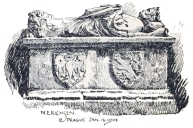
TOMB OF OTTOKAR I.
The population of Prague—originally entirely Slavic—was at an early
period increased by German immigrants. They first arrived at Prague as
permanent residents during the reign of King Vratislav (1061-1092). They
settled on the right bank of the Vltava, and, favoured by the Bohemian
Sovereigns, increased rapidly. They were granted special privileges by
Sobeslav, and these privileges were afterwards extended by King
Wenceslas I. Thus the old town in distinction from the new town,
afterwards founded by Charles IV., long had a somewhat German{7}
character, and indeed only entirely lost it during the Hussite Wars. The
old document stating that ‘no German or Jew shall be burgomaster of the
old town of Prague,’ which is still shown in the town hall, only dates
from this period.
The old town, however, always contained a strong Bohemian-Slavic
element, and the fusion of the two nationalities undoubtedly became
closer when, during the reign of King Wenceslas I., the old town
was—probably about the year 1235—enclosed with walls. These walls
starting from the Vltava, near the present bridge of Francis Joseph,
followed the line of the Elizabeth Street and the Josefské Námesti till
they reached the Prikopy or Graben. Thence they proceeded along the
present Prikopy, Ovocná ulice and Ferdinandova ulice till they rejoined
the river, near the spot where the national theatre now stands. The
Graben, now the principal thoroughfare of Prague by its name, which
signifies ditch or trench, still recalls its original destination. The
Prasná Brana (powder tower or gate) marks the spot where one of the
gates of the old town stood. According to Dr. Tomek the fortifications
consisted of a double wall and double ditch, which was filled with water
derived from the Vltava. With the exception of the Vysehrad and a few
straggling buildings near the present Poric Street, the new walls
contained all that part of Prague that was situated on the right bank of
the river.
Premysl Ottokar II., the son and successor of Wenceslas I., was one of
Bohemia’s greatest kings. Both by successful warfare and by skilful
diplomacy he so greatly enlarged his dominions, that his rule at one
time extended from the Adriatic in the South to the Baltic in the North.
Though his many campaigns left him little leisure to reside in his
capital, Ottokar enlarged both the town and the fortifications of
Prague.{8}
In 1257 he greatly added to the fortifications that no doubt already
existed on the Hradcany Hill. He caused the whole Hradcany Hill to be
surrounded by a strong wall and the various towers to be connected by
covered passages. Ten knights and 300 armed men were to keep constant
watch and ward over the fortifications. The still existent
towers—Daliborka, Mikulka, and the white and the black towers—formed
part of these fortifications. Somewhat later the King also enclosed with
walls the Malá Strana (small quarter)—that is to say, the buildings
that extended from the foot of the Hradcany to the river. Here
fortifications were necessary in three directions only, as in the
direction of the Hradcany that fortress protected the newly enclosed
settlement.
It appears probable that when the old town had been fortified a
tête-de-pont had been built on the left bank of the Vltava, which,
together with a similar building on the right bank, was to secure the
bridge of Prague. The fortified gate on the left bank was now included
in the new fortifications. It may here be remarked that when the old
town had been fortified the Jewish quarter (vicus Judæorum) had been
included in these fortifications; gates, however, separated the Jewish
quarter from the rest of the old town.
The Jewish colony of Prague is of very ancient origin. According to Mr
Foges,[6] who was himself a member of that community, Jews went there
immediately after the destruction of Jerusalem, if not even before that
event. Popular tradition, always given to exaggeration, indeed affirms
that Jews first settled at{9}

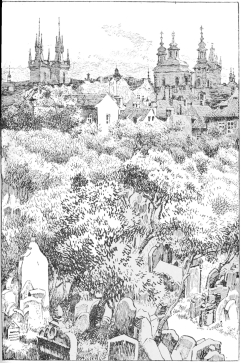
THE JEWISH CEMETERY
{10}
{11}
Prague, or rather at Buiarnum, which stood on the spot where Libussa
afterwards founded Prague, before the beginning of the Christian era,
and being therefore guiltless of all participation in the Crucifixion
they had fared better in Prague in mediæval times than in most other
cities. It is true that Jew-baiting was not unknown in Prague. Mr Foges
quotes from the original Hebrew a graphic account of the great
persecution of the Jews in 1389. Yet, on the whole, we find at Prague
fewer traces of the intense hatred of the Jews which is general
elsewhere, and individual Jews often were in favour with the rulers of
Bohemia. Thus the Rabbi Löwi Bezalel, who died in 1609, and is buried in
the old Jewish cemetery, enjoyed the favour of Rudolph II. Bezalel, who
was a student of astronomy and astrology, then intimately connected with
it, was a friend of Tycho Brahe, who attracted Rudolph’s attention to
the learned Jew. Bezalel was summoned to the royal palace, on the
Hradcany, and a very lengthy interview between him and Rudolph took
place. It is stated that Bezalel, during his whole lifetime, refused to
give any account of this mysterious interview. He was probably a
cabalist, and many quaint legends have centred round his name.
According to Dr. Tomek the period between the circumvallation of the old
town and the foundation of the new town was that in which the
preponderance of the German element at Prague attained its height. The
Sovereigns favoured the German immigrants, wishing to use them as a
counterpoise to the overwhelming power of the masterful Bohemian nobles.
The old chronicler Dalimil, when describing Ottokar II.’s departure on
his last fatal campaign against Rudolph of Hapsburg, refers to the
apathy of the Bohemians, many of whom considered themselves as neglected
in favour of the Germans, and to the{12} King’s resentment. He is made to
say: ‘When I return from the wars I will inflict much evil on the
Bohemians. I will thus stain the Petrin[7] with their blood, that no
Bohemian will any longer be seen on the bridge of Prague.’ The passage
is interesting also, as showing how early the bridge of Prague became
famous.[8]
The feelings expressed by Dalimil, who always writes as the champion of
the Bohemian aristocracy, were, however, by no means universal among the
Bohemians, many of whom were warmly attached to their Sovereign. We read
that when, on June 27th, 1278, Ottokar left Prague for the last time ‘he
took leave of all those whom he loved and who were faithful to him; the
clergy and the whole people followed him to the city-gates with prayers
and many tears.’ They seem to have foreseen the fatal defeat on the
Marchfeld where Ottokar lost his life. When the news of his death
reached Prague, lamentation was general from the royal palace to the
lowliest hovel. Though Ottokar was under sentence of excommunication,
the Bohemians, never very heedful of the Papal authority, thronged to
the altars to pray for the eternal salvation of their beloved Sovereign,
while the bells of all the churches of Prague, nearly a hundred in
number, tolled. During the short reigns of his successors, the last
Premyslide princes, Bohemia was involved in almost incessant war.
Soon after the extinction of the Premyslide dynasty{13}

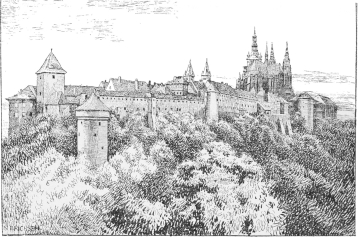
THE HRADCANY AND OTTOKAR TOWERS
{14}
{15}
(1306), John of Luxemburg, son of the German Emperor Henry VII., became
King of Bohemia (in 1310). His adventurous reign concerns the annals of
Prague but very little. A Sovereign who declared that ‘Paris was the
most chivalrous town in the world, and that he only wished to live
there,’ naturally neglected his Bohemian capital. The Bohemians
complained that his short visits to Prague were only made for the
purpose of obtaining financial aid from the Estates of Bohemia. His
incessant campaigns, that extended from Lithuania and Hungary to Italy
and France, indeed involved him in constant financial difficulties. It
is characteristic of the knight-errant King that he seriously
contemplated re-establishing at Prague the round-table of King Arthur.
He invited all the most famous knights in Europe to that city in 1319;
nobody, however, appears to have responded to his call.
After King John’s death on the battlefield of Crécy, his son Charles IV.
(or I. as King of Bohemia) became his successor. Differing in most
respects from his father, he was a devoted lover of Prague, and may
almost be considered a second founder of the city. The districts of
Prague, the Malá Strana and the Staré Mesto, that were already enclosed
by walls, had become insufficient to shelter the ever-increasing
population. Charles therefore decided on building a new city on the
right bank of the Vltava. The old chronicler, Benes of Weitmil, tells us
that ‘in the year of the Lord MCCCXLVIII., on the day of St. Marc, our
Lord Charles, King of the Romans and of Bohemia, laid the first stone,
and founded the new city of Prague, building a very strong wall with
ramparts and high towers extending from the Castle of Vysehrad to Poric.
The Vysehrad Hill also he surrounded with a wall and very strong towers,
and the whole work was carried out within{16} two years. And he also
ordered that gardens and vineyards should be planted around the city of
Prague.’ It is interesting to note in connection with this statement of
the old chronicler that Dr. Tomek also tells us that during the reign of
Charles many citizens bought land outside the town and established
vineyards there.
The new town received great privileges from Charles, and the foundation
of the University, which contributed largely to increasing the
population of the town, also had a very favourable effect on the new
community. The ‘new town,’ the limits of which were soon extended,
enjoyed the rank of a royal town, a name given to those cities only that
had been awarded special privileges by the Bohemian Kings.

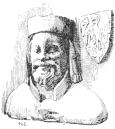 CHARLES IV., FROM TRIFORIUM
CHARLES IV., FROM TRIFORIUM
OF ST. VITUS
Charles had, while temporary ruler of Bohemia during the absence of his
father, succeeded in persuading the Papal See to raise the bishopric of
Prague to an archbishopric. It was through his influence also that his
friend Ernest of Pardubic, a member of one of the oldest noble families
of Bohemia, was chosen as first Archbishop of Prague.
It was on Ernest also that Charles conferred the dignity of being the
first Chancellor of the newly-founded University of Prague. That
foundation is, as regards the annals of the world, the most important
event in the history of Prague. That a movement in favour of Church
reform should originate here at a time when Geneva and Wittenberg were
unknown as centres of theological strife was only rendered possible{17} by
the fact that Prague had become the site of one of the then very scanty
universities.
At the meeting of the Estates at Prague in 1348 Charles made the
following statement: ‘One of our greatest endeavours is that Bohemia our
kingdom, for which we feel greater affection than for any of our other
lands, should, through our action, be adorned by a great number of
learned men; thus will the faithful inhabitants of that kingdom, who
incessantly thirst for the fruits of learning, be no longer obliged to
beg for foreign alms, rather will they find a table prepared for them in
their own kingdom; thus will the natural sagacity of their minds move
them to become cultured by the possession of knowledge.’ Charles
concluded by informing the assembly that he had resolved to found the
University of Prague.
Faithful to his predilection for France, Charles modelled his
regulations for the new University entirely on those of the University
of Paris. The students were divided into ‘nations’ according to their
nationality. In Prague we find the Bohemian, Polish, Bavarian and Saxon
‘nations’; each of these separately elected members to the general
council of the University.
The new foundation seems to have been very successful from the first.
Benes of Weitmil writes: ‘The University’ (studium) ‘became so great
that nothing equal to it existed in all Germany; and students came there
from all parts—from England, France, Lombardy, Poland, and all the
surrounding countries, sons of nobles and princes, and prelates of the
Church from all parts of the world.’
No special building seems at first to have been erected for the
University. Many professors delivered their lectures at their own
apartments, while of the five professors of the theological faculty one
lectured in St. Vitus’s Cathedral, the other four, all monks,{18} in the
monasteries to which they belonged. The lectures were at first always
delivered in Latin, and it is, therefore, equally incorrect to maintain
that the Prague University was at its beginning a genuinely German one
as to say that it had, from the origin, a really
Bohemian—national—character.
In the last years of his life Charles caused several colleges to be
built for the benefit of the students. The first of these colleges was
founded when Charles bought the ‘house of the Jew Lazarus in the old
town,’ which afforded a dwelling-place for twelve professors. Charles
also gave a library to the newly-founded college. During the reign of
his son this, the most important of these foundations, was transferred
to the building known as the ‘Carolinum,’ which henceforth became the
centre of the University.
Everything connected with the University was to Charles of the greatest
interest, and the Sovereign was often present at the ‘disputations’
which, according to the mediæval custom, took place there.
Charles was also the founder of a confraternity or guild of artists, of
which painters, sculptors, wood-carvers and goldsmiths were members, and
which, as Palacky says, took the place of a modern academy of arts.
Charles—who, as his very curious Latin memoirs prove—was a very devout
Christian, was a great church builder. He rebuilt and enlarged St.
Vitus’s Cathedral, and among his many ecclesiastical constructions the
Karlov and the Church and Monastery of Emaus may be mentioned.
The great prosperity that Bohemia and Prague in particular enjoyed
during the reign of Charles produced a tendency to luxury, and had a
somewhat harmful influence on the morality of the people and of the
wealthy clergy in particular. Thence arose a strong and general demand
for Church reform which{19}

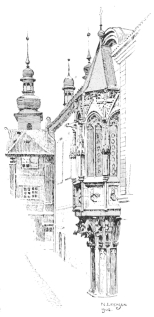 THE GOTHIC PROJECTION, CAROLINUM
THE GOTHIC PROJECTION, CAROLINUM
afterwards culminated in Hus. It would be very tempting to refer here to
the forerunners of Hus who lived during the reign of Charles, but here,
as everywhere, the need of compression confronts me. Yet a short mention
should be made of Conrad Waldhauser and Milic of Kromerize. The former,
an Austrian by birth, was called to Prague in 1358 by Charles, and
preached at several churches there, but principally at the Tyn Church,
where he became rector about the year 1360. Though he generally preached
in German, his sermons, containing eloquent denunciations of the
immorality and luxury of the times, greatly impressed the Praguers, even
the vast Tyn Church occasionally became insufficient to contain his
audience, and he sometimes preached in the streets and market-places. He
strongly inveighed against the immorality and extravagance of the
citizens of Prague, and the result of his preaching was very striking.
We read that the women of Prague discarded{20} the jewelry to which they
were accustomed, their precious veils, their dresses trimmed with gold
and pearls, and adopted simple clothing; usury ceased, and many who had
formerly committed that sin declared themselves ready to compensate
their former victims. Many citizens who had led an immoral life did
public penance, and henceforth gave a good example to others.
As was perhaps inevitable, the great success obtained by Waldhauser was
resented by other preachers at Prague. This feeling became more intense
when Waldhauser attacked the mendicant friars. In 1364 the Dominican
monks accused him of heresy, and brought two points in which, they said,
his teaching was contrary to the Church, before Archbishop Ernest.
Waldhauser lost no time in presenting his defence, and when the
Archbishop appointed day and hour, when anyone who had any grievance
against Conrad might appear before the Archiepiscopal Court, no accuser
came forth.
This success seems to have encouraged Waldhauser to continue his
denunciations of the corruption of the clergy. He was again accused,
both by the Dominican and Augustine friars. The latter especially
accused him of apostasy. Waldhauser defended himself in a Latin
Apologia, which has been preserved. Its tone allows us to infer that
his attacks against the immorality of the monks must have been very
violent. It is a proof of the liberal mind of Charles, who has by German
writers often been accused of undue subservience to the Church of Rome,
that Waldhauser none the less retained his office as rector of the Tyn
Church up to his death.
Yet greater was the fervour of Milic, who, in 1369, succeeded Waldhauser
as rector of the Tyn Church. Milic had early in life held important
offices at the Court of Charles. A canon of the Cathedral of{21} Prague, he
had also been appointed Vice-Chancellor of the Court, and had for some
time in that capacity accompanied Charles during his travels. The desire
for Church reform and a return to the primitive Church, then so
prevalent in Bohemia, induced Milic to renounce all his honours and to
seek refuge in poverty. After having acted as curate for some time in a
poor village, Milic returned to Prague, where his sermons, preached in
the Church of St. Nicholas in the Malá Strana, soon attracted general
attention. Following in the steps of Waldhauser, he eloquently denounced
the corruption of his times; but he seems to have strayed further from
the doctrine of Rome than Waldhauser had done. Incessant study of the
Apocalypse, and the horror which the evil ways of his day inspired in
him, appear to have ripened in his mind the idea that the end of the
world was approaching. He gave expression to his views not only in his
sermons, but also in a written work, entitled, Libellus de
Antechristo. The monks of Prague, his enemies, as they had been those
of Waldhauser, denounced him to the Papal See, and Milic started for
Rome, where, in the absence of Pope Urban, he was imprisoned. After the
Pontiff’s arrival an interview between him and Milic took place, when
Urban, recognising the purity of his motives, caused him to be
liberated, and allowed him to return to Prague. Through the favour of
Charles he here obtained the rectorship of the Tyn Church, as already
mentioned. Coming from a thoroughly Slavic part of Moravia, Milic was
well acquainted with the national language, and, indeed, only learnt
German late in life. His sermons, therefore, attracted yet more
attention than those of his predecessor. Milic did not limit himself to
invectives against vice, but endeavoured by his own activity to reform
the people of{22} Prague. Through his influence the ill-famed buildings
known as Benatky (Venice) were destroyed and a building erected on the
spot to which the name of ‘Jerusalem’ was given, the first instance of
the adoption of biblical names, that afterwards became so frequent in
Bohemia. The fallen women who had formerly dwelt at Benatky now lived as
penitents at ‘Jerusalem,’ and were the object of Milic’s particular
care.
At the end of his life Milic again incurred the hostility of the
ecclesiastical authorities. He repaired to the Papal Court at Avignon in
1374, but died (there) before the ecclesiastical court before which his
case was brought and had pronounced judgment. His memory was long held
in reverence by the Bohemians.[9]
The reign of Charles I. marks so important a step in the development of
Prague that it may be interesting to note here the various divisions of
the city such as they existed during his reign, and after he had so
greatly enlarged the city. Prague then consisted of three ‘royal’
cities, that is to say, communities that had received special privileges
from the Sovereign. They were the old town (Staré Mesto), new town (Nové
Mesto), both on the right bank of the Vltava, and the Malá Strana (small
quarter), on the left bank of the river. Besides these the community of
Hradcany was under the rule of the burgrave of the Prague castle, and
that of Vysehrad under that of the abbot of the monastery of that name.
All these and some minor communities enjoyed special privileges, greater
in some, smaller in other cases. Charles, however, in the last year of
his life, united for a time the two royal cities on the right bank of
the river.{23}
CHAPTER II
From the Reign of Charles IV. to the Executions at Prague in 1621
CHARLES died in 1378 and was succeeded by his son Wenceslas, who, at
least in his earlier years, certainly does not deserve the exaggerated
censure of German historians. These historical judgments are, to a great
extent, founded on the opinions unfavourable to Wenceslas that were
expressed by strongly Romanist chroniclers, who were influenced by the
favour that the King, and yet more his consort, Princess Sophia of
Bavaria, for a time showed to Hus and the movement in favour of Church
reform. Wenceslas, who was only seventeen when he ascended the throne,
maintained all the trusty councillors of his father in their official
positions, and Palacky is no doubt right in stating that, during the
first years of Wenceslas’s reign, Bohemia was as prosperous as it had
been during that of his father. It was said that such perfect security
prevailed in the country that one carrying a bag of gold on his head
could have traversed Bohemia from end to end without incurring any risk.
Unfortunately for Wenceslas the old councillors of Charles soon followed
their master to the grave, while the difficulties caused by the Papal
schism (which will be mentioned later in connection with the Church
reform movement) from the first confronted the young King. In this case,
as indeed in his foreign policy generally, Wenceslas did not follow the
example of{24} his father, who had been a firm friend of France. He
concluded an alliance with England, which was strengthened by the
marriage of Wenceslas’s sister Anne to King Richard II. of England.
Wenceslas followed his father’s example in mainly residing at Prague,
and he soon became very popular with the citizens. It was said he
visited the shops of bakers and butchers and inquired the prices of
their goods. If these proved higher than was authorised by the
regulations, Wenceslas ordered the goods to be given away to the poor
and the vendors to be severely punished. Less praiseworthy than these
mediæval methods of enforcing justice were the King’s nocturnal
excursions through the streets of Prague, on which he was accompanied by
boon companions not generally chosen from the higher ranks of the
nobility. The King thus became estranged from the proud Bohemian
aristocracy, and civil war eventually broke out. It was, as Dr Tomek has
shown, in consequence of his desire to mix more freely with the citizens
that Wenceslas abandoned the royal residence on the Hradcany and took up
his abode in a building close to the Celetná ulice and the powder tower.
The young King is said to have greatly enjoyed his comparative privacy,
and even to have arranged public festivities on the neighbouring
Staromestské Námesti.
The animosity of the Bohemian nobles against their Sovereign, as already
mentioned, eventually led to civil war. In 1393 most of the prominent
Bohemian nobles formed a confederacy against Wenceslas, which is known
in history as the ‘league of the lords.’ The King’s own cousin, Jodocuo
of Moravia, as well as Albert III., Duke of Austria, and William,
Margrave of Meissen, joined the confederacy. On Wenceslas refusing to
grant the demands of the confederates, who wished to limit his power,
and especially his right to{25} choose his councillors, he was seized by
the lords at his castle near Beroun and conveyed as a prisoner to
Prague. The citizens of Prague, however, with whom Wenceslas was still
popular, took the part of their King and besieged the castle of the
Hradcany, where he was confined. In June 1394 an army, led by Duke John
of Görlitz, a brother of Wenceslas, arrived before Prague to attempt to
liberate the imprisoned Sovereign. The citizens of the new town joyfully
received the Duke of Görlitz and joined his forces, while those of the
old town, who—intimidated by the league of lords—at first attempted
some resistance, were soon forced to capitulate. The lords, no longer
believing their prisoner safe at Prague, conveyed him first to Kruman, a
castle of the lords of Rosenberg, one of the leaders of the league, and
afterwards to Wildberg. A temporary compromise was concluded soon
afterwards, and, after granting most of the demands of the confederates,
Wenceslas regained his liberty.
Discord soon again broke out between the King and the nobles, who were
encouraged by Rupert, Elector Palatine, whom the Germans had chosen as
King after deposing Wenceslas. In 1401 an army led by the Margrave of
Meissen, an ally of the Elector Palatine, entered Bohemia, and, after
devastating a large part of the country, besieged Prague. The city that
had not seen a foreign enemy at its gates for more than a hundred years
was terrified, while the horrible cruelties committed by the Germans
excited the indignation of the people. The young preacher Hus here for
the first time gave expression to the feelings of his countrymen when,
in one of his first sermons in the Bethlehem Chapel, he declared that
the Bohemians ‘were more wretched than dogs or snakes, for a dog defends
the couch on which he lies, and, if another dog tries to drive him away,
he fights with him, and a snake does{26} the same; but us the Germans
oppress without resistance.’
Prague was, however, not captured by the Margrave of Meissen, and
another of the many temporary agreements between the King and the
Bohemian nobles, which were so frequent in the reign of Wenceslas, was
concluded.
In the following year Wenceslas again became a prisoner. By order of his
brother Sigismund, King of Hungary, whom he had foolishly invited to
Prague, Wenceslas was seized in the royal residence, near the powder
tower, and conveyed first to the Hradcany castle and afterwards to
Vienna, where Sigismund entrusted him to the custody of his ally the
Duke of Austria. In the following year, however, Wenceslas succeeded in
making his escape from Vienna. He returned to Bohemia, where he was now
joyfully received by the people, who had suffered greatly during the
time that the rapacious Sigismund had illegally ruled over Bohemia.
King Wenceslas’s nature seems to have deteriorated with increasing
years; his tendency to drink became stronger; his capacity for work
decreased; he became more and more incapable of controlling his always
violent temper. A proof of this is the King’s well-known conflict with
John of Pomuk or Nepomuk. The size of this book—perhaps fortunately for
the writer—precludes entering into controversial matters. I will
therefore only remark that recent historians have thrown some doubts on
the tale of John of Nepomuk. Palacky declared that St. John Nepomucene
belongs solely to legend, in no wise to Bohemian history. Recently even
some Roman Catholic writers have agreed with him. I will now give the
legend in its earliest form, as it appears in Hajek’s chronicle. Hajek
writes under the date of 1383 that ‘King{27}

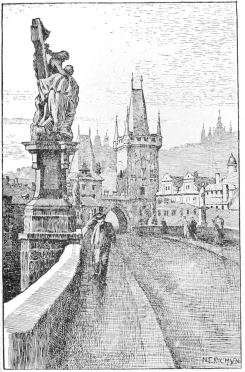
THE BRIDGE TOWER OF THE MALÁ STRANA
{28}
{29}
Wenceslas gave himself over to much disorder, frequenting various games,
plays and dances. His wife, a very noble and honourable lady, blamed
him....’
In consequence of such reproof the King was incensed against his wife,
and conceived great hatred for her, so that he sought for some cause
enabling him to deprive her of her life. The day after the feast of the
Holy Sigismund he summoned before him the priest, John of Nepomuk, a
master of the University of Prague, canon of the Prague Church, and
confessor of the Queen. He requested him to tell him what sins the Queen
had confessed to him before God. The priest answered, ‘O King, my lord,
I have assuredly not retained this in my memory, and if I had, it would
not be beseeming for me to do this, neither is it beseeming for you to
make such inquiries.’ The King was incensed, and caused him to be thrown
into a grievous subterranean dungeon; then, being unable to obtain
anything from him, he sent for the executioner, and ordered that he
should be cruelly tortured; but being unable even then to obtain any
information from him, he ordered that he should be brought at night to
the bridge of Prague, fettered, and thrown into the waters to drown.
After this had been done, on that night and on the following one many
lights could be seen over the body that was floating on the stream. The
King, hearing of this miracle, left for his Castle of Zebrák, and the
prelates of the cathedral took the body out of the water and carried it
solemnly to the Monastery of the Holy Cross on the citadel of Prague’
(i.e., the Hradcany), ‘then they buried it in St. Vitus’s Cathedral
... afterwards many and manifold wonders took place there, and therefore
many declared that he was one of God’s martyrs and a saint.’
The principal event of the later years of the reign of Wenceslas was the
Hussite movement, of which Prague{30} was the centre. As has already been
mentioned, a strong feeling hostile to the corruption of the Church of
Rome had existed during the reign of Charles. Subsequent events had not
unnaturally strengthened this feeling. Two, afterwards three, rival
candidates claimed the Pontificate, and employed the terrible threats
usual among mediæval theologians against the adherents of their rivals.
It was inevitable that the authority of the Church of Rome should suffer
from this discord, particularly in Bohemia, where Waldhauser and Milic
had left many successors. Of these, by far the greatest was Hus, whose
career is so closely connected with Prague that I shall briefly allude
to it here.

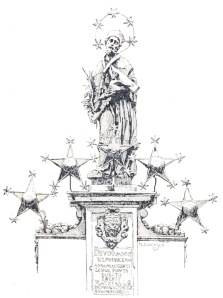 STATUE OF ST. JOHN NEPOMUK ON THE BRIDGE
STATUE OF ST. JOHN NEPOMUK ON THE BRIDGE
John Hus, or of Husinec, was born at the village of that name about the
year 1369. The 6th of July was traditionally believed to be the day of
his birth, and as it was also the day of his death, the day was always
celebrated in the Bohemian Church up to{31} the time when the battle of the
White Mountain re-established the Church of Rome in Bohemia. He arrived
at Prague at a very early age, and in September 1393 took the degree of
Bachelor of Arts at the University there. In the following year he
became a Bachelor of Divinity, and in 1396 Master of Arts. His
reputation for great learning spread very rapidly at the University. In
1401 he became Dean of the Faculty of Arts, and in the following year,
at an unusually early age, for the first time Rector of the University.
But it was only from the time that he began preaching in the Bethlehem
Chapel that his name became widely known to those also who were not
connected with the University.
The Bethlehem Chapel, situated in what is still known as the Bethlehem
Place—‘Betlemské Námesti’—was founded in 1391 by John of Milheim, one
of King Wenceslas’s courtiers, together with ‘Kriz the Shopkeeper,’ as
he is called in the contemporary records, a wealthy tradesman of Prague.
Following the example of Milic, whose foundation had been called
‘Jerusalem,’ Milheim and Kriz also gave a Biblical name to the new
chapel. Both founders were favourable to Church reform and partisans of
the national movement. Sermons were always preached in Bohemian at
Bethlehem, and the brilliant eloquence of Hus, of which we can still
judge, as some of his sermons have been preserved, attracted the general
attention of the people of Prague. It is noteworthy that during the
first years of his priesthood—he was consecrated as a priest about the
year 1400—Hus was on good terms with his ecclesiastical superiors. Even
after the first disputes concerning Wycliffe’s teaching had arisen, Hus
was, as he himself mentions, requested by the newly appointed Archbishop
of Prague ‘to bring all irregularities contrary to the rules of the{32}
Church’ to the Archbishop’s notice. It should here already be mentioned
that the teaching of Hus differed from that of Rome far less than was
the case with most Church Reformers. As Dr. Harnack has written,[10]
Hus, like Wycliffe, ‘only denied the alleged right of the clergy to
represent the Church and administer its sacraments even when they did
not fulfil God’s commandments. How—he declared—can the functions of
priests be valid if the presupposition of all they do in the Church and
for the Church, namely, obedience to the law of God, is absent. The
quintessence of that law is the Sermon of the Mount and the example of
the humble life of Jesus; yet the whole of Scripture is the law of God.’
The first disputes between Hus and his ecclesiastical superiors broke
out in 1403. On May 28th of that year a full meeting of the members of
the University, memorable as the beginning of the Hussite struggle, took
place at the Carolinum. It was finally decided that forty-five so-called
‘articles’ culled from the writings of Wycliffe, twenty-four of which
had already been condemned by the Council of Blackfriars, should be
declared heretical, and that all members of the University should be
forbidden to circulate them. Hus and his friends, who were accused of
spreading the heretical opinions of Wycliffe in Bohemia, protested
against this sentence and maintained that the ‘articles’ contained many
statements that were not to be found in Wycliffe’s writings.
Shortly after this first debate, Zbynek Zajic of Hasenburg became
Archbishop of Prague, and it seemed for a time that religious peace had
returned to the country. But in 1408 the clergy of Prague and of the
whole archbishopric of Prague brought forward a protest against Hus’s
preaching at the Bethlehem Chapel,{33}

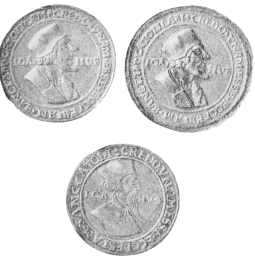
MEDALS OF HUS
{34}
{35}
stating that he had, ‘in opposition to the decisions of the Holy Church
and to the opinions of the Holy Fathers, and to the injury, shame,
detriment and scandal of the whole clergy and the people generally,’
declared heretics the priests who took payment for ecclesiastical
functions, and blamed the ecclesiastics who held numerous benefices.
Hus, indeed, defended himself eloquently, but he was none the less
deprived of the office of preacher before the Synod, which the
archbishop had conferred on him some time before.
Relations between the archbishop and Hus became yet more embittered when
the latter addressed to his ecclesiastical superior a letter of
remonstrance which Dr. Lechler, a Protestant divine, describes as
‘reaching the extreme limit of what is permissible to a priest when
writing to his ecclesiastical superiors.’ In this letter, written on
behalf of Velenovic, a priest of Prague, who was accused of favouring
Wycliffe’s views, Hus admonished the archbishop ‘to love the good, not
to be influenced by flattery, to be a friend of the humble and not to
hinder those who work steadfastly at the harvest of the Lord.’
At this period the racial and the religious struggle in Bohemia
proceeded simultaneously; those who favoured the movement for Church
reform were also warm friends of the Bohemian nationality. It was
therefore a great triumph for this party, of which Hus was now the
leader, when King Wenceslas, in January 1409, issued the ‘Decrees of
Kutna Hora,’ which secured the permanent supremacy of the Bohemian
nation at the University of Prague. The result was the departure of the
German masters and students from Prague. They left the University
probably in the number of five thousand, though some Bohemian writers
give a much higher figure. After Archbishop Zbynek had recognised
Alexander as the{36} legitimate Pope, the proceedings against Hus had a
much more rapid development. On July 15, 1410, Wycliffe’s writings were
solemnly burnt in the courtyard of the archiepiscopal palace that was
then situated in the Malá Strana, near the bridge.
The burning of Wycliffe’s works met with almost universal disapproval at
Prague. A contemporary chronicler writes: ‘Instantly a great sedition
and discord began. Some said that many other books besides those of
Wycliffe had been burnt; therefore the people began to riot, the
courtiers of the King were incensed against the canons and priests; many
opprobrious songs against the archbishop were sung in the streets.’
Hus, at a meeting of the University, energetically defended Wycliffe’s
teaching; he also, contrary to the positive orders of the archbishop,
continued his sermons in the Bethlehem Chapel. On March 15, 1411, the
sentence of excommunication which had been pronounced against Hus some
time previously was published in the churches of Prague, while the town
itself was placed under interdict. Endeavours to effect a settlement
indeed still continued.
In May 1412, however, the difficulties caused by the Papal schism
brought the reform movement in Bohemia to a crisis. King Ladislas of
Naples, who still recognised Gregory the Twelfth as Pope, had thus
incurred the enmity of John XXIII., who had succeeded Alexander V. as
Roman Pope. John, therefore, resolved to go to war with the King of
Naples, and—a proceeding which it must be added was not exceptional in
those days—to obtain the necessary funds by the granting of
indulgences. It was declared that all those who either took part in the
campaign against Naples, or assisted the enterprise by grants of money,
should receive the same remission of sins which had formerly been
promised to the Crusaders who had{37} liberated the sepulchre of Christ.
The Bohemians, who were not long after to suffer from a ‘crusade’
similar to that now proclaimed against Naples, received the news of the
Papal decision with great displeasure. When Wenceslas Tiem, Dean of
Passau, arrived at Prague, with the purpose of collecting, by the sale
of indulgences, funds for the Papal See, public excitement was naturally
yet greater. Boxes to receive the donations of the faithful were placed
before the Cathedral Church of St. Vitus, the Tyn Church, and on the
Vysehrad. These proceedings caused particular indignation at the
University, where the party favourable to Church reform now had entirely
the upper hand. Hus summoned the members of the University to a
disputatio, according to the mediæval custom. It took place in the
large hall of the Carolinum, and the subject of the disputatio was
formulated in the question ‘whether according to the law of Jesus Christ
it was permissible and befitting for the honour of God, the salvation of
the Christian people and the welfare of the kingdom, that the faithful
of Christ should approve of the Papal bulls which proclaimed a crusade
against Ladislas, King of Apulia, and his accomplices?’ Both Hus and
Jerome of Prague violently attacked the use of indulgences for the
purpose of supplying the Roman See with funds for temporal purposes. The
theological faculty soon after again condemned the forty-five ‘articles’
from Wycliffe’s writings, and added six more that were attributed to Hus
and said to contain the views on indulgences which he had expressed at
the recent disputatio. Pope John also took action against Hus, and
decreed the ‘aggravation’ of the sentence of excommunication that had
already been pronounced against him. The movement had thus taken a
distinctly revolutionary character, and Hus fled from Prague in November
1412, after having published{38} an ‘Appeal from the Sentence of the Roman
Pontiff to the Supreme Judge, Jesus Christ.’ He first retired to Kozi
Hradek, a castle belonging to one of his adherents, John of Usti.
Shortly after his departure from Prague an attempt was made there to
assuage the religious discord. A diocesan synod met there in the
archiepiscopal palace. Hus was not present, but was represented by
Magister John of Jesenic. Little is known of the deliberations of this
assembly, though the documents in which both the Hussite and the
Romanist divines formulated their views have been preserved. This
conference proved abortive, as did also a subsequent attempt of King
Wenceslas to bring the disputed questions before a committee, which was
to consist of four members and over which Albik, then Archbishop of
Prague, was to preside. When it was decided to affirm that both parties
were in accordance with the Church with regard to the doctrine of the
Sacrament of the Altar, the Romanist divines immediately protested,
declaring that they were not a ‘party,’ and demanding that the word
‘Church’ should be defined as the Holy Roman Church, of which Pope John
XXIII. is the head, and of which the cardinals are the members. The
negotiations thus failed from the first, to the great indignation of
King Wenceslas, who, indeed, exiled from Prague some of the German
Romanist divines. The racial struggle, as so frequently in Bohemia,
continued simultaneously with the religious one, and about this time,
through the influence of the King, the majority of the town council of
the old town, which had been German, became Bohemian, and, therefore,
favourable to the cause of Hus.
Hus, who appears to have several times visited Prague secretly at this
time, had meanwhile left the castle of Usti, and was, on the invitation
of Lord{39}

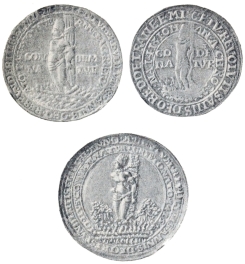
MEDALS OF HUS
{40}
{41}
Henry of Lazan, one of the King’s courtiers, residing at the castle of
Krakovec, situated considerably nearer to Prague. Contrary to the Papal
commands he frequently visited the neighbouring towns and villages,
preaching in favour of Church reform.
All attempts to settle the religious differences in Bohemia having
failed, the questions raised by Hus were finally brought before a wider
forum. On the suggestion of Sigismund, King of Hungary, and afterwards
German Emperor, Hus proceeded to the council that met at Constance in
November 1414. He had previously, according to the momentous words of
Professor Tomek, received from Sigismund a safe-conduct, according to
which he was ‘to come unmolested to Constance, there have free audience,
and return unharmed, should he not submit to the authority of the
council.’
None the less Hus was imprisoned shortly after his arrival at Constance,
and was—as will be known to most readers—burnt alive on July 6, 1415.
The death of Hus caused general indignation in Prague. Almost all the
parish priests who ventured to praise, or even to excuse the execution
of Hus, were driven from their homes. The Bohemian nobles who met at
Prague in September (1415), and who were joined by many Moravian nobles,
also expressed their indignation strongly. They addressed to the council
a letter known as the ‘Protestatio Bohemorum,’ accusing it of having
‘condemned the venerable magister (i.e., Hus) without having convicted
him of any error, merely on the strength of evil statements of
treacherous enemies and traitors, and of having deprived him of his life
in the most cruel fashion, to the eternal shame and offence of Bohemia
and Moravia.’ They further declared ‘before the council and the whole
world that Magister John{42} Hus was a man of pure life and irreproachable
fame, who taught the law of Scripture according to the doctrine of the
fathers and of the Church, who loathed all errors and heresies, who, by
word, writing and deed, admonished us and all the faithful to desire
peace and to love our neighbours, and by his own quiet and edifying life
guided us in the path of godliness.’
A few days after sending to Constance this declaration that caused great
indignation there, the knights and nobles united in a solemn covenant
for mutual defence. They pledged themselves to defend the liberty of
preaching the word of God, to obey the Pope and the bishops of Bohemia
as long as their commands were not contrary to Scripture, and meanwhile
to recognise the University of Prague as the supreme authority in all
matters of doctrine. The University thus first acquired the important
position of arbiter in matters of doctrine which it held during the
Hussite wars, and, indeed, only entirely lost after the battle of the
White Mountain. The fact that the King and Queen were known to favour
the national movement alone prevented an immediate general outbreak.
Matters became yet more serious when—following the advice of his
treacherous younger brother, Sigismund—Wenceslas endeavoured to stem
the current.
In 1419 the King issued a decree ordaining that all priests who had been
deprived of their livings because of their disapproval of communion in
the two kinds, should be reinstated. Only in three churches were the
Utraquists, as the adherents of the new doctrine were called, to
continue to hold their religious services. The Utraquists, to show their
strength, instituted processions through the streets of Prague, during
which the sacrament was carried before the faithful. One{43} of the most
zealous Utraquists was the priest, John of Zelivo, a former Præmonstrate
monk. On July 30, 1419, he headed a procession which, after violently
interrupting a religious service which was being held in the Church of
St. Stephen, according to the Roman rites, marched to the town hall of
the Nové Mesto, situated in the Karlovo Námesti. The release of some
adherents of the new faith who had been imprisoned there was demanded,
but refused by the burgomaster, who was a Romanist. The Utraquists then,
‘as an affront, called him a German and a hater of the chalice.’[11]
Meanwhile the town councillors had barricaded their hall and threw
stones on the crowd below, one of which struck the monstrance that
Zelivo was carrying. The crowd—led, it is said, by Zizka, afterwards
famous as a Hussite leader—stormed the town hall and threw the town
councillors into the market-place below, where they were killed by the
people.
This ‘defenestration,’ as it was called in Bohemia, marks the beginning
of the great religious struggle in Bohemia, as the defenestration from
the Hradcany windows in 1618 marks its end; for only two years after the
last-named event the battle of the White Mountain established religious
uniformity in Bohemia.
The defenestration was followed almost immediately by the death of
Wenceslas, who succumbed to repeated apoplectic fits on August 16, 1419.
His death was the signal of yet more serious riots, during which many
churches and monasteries were destroyed and many valuable relics of
Bohemian art perished. The Puritan character of the movement is proved
by the fact that no plundering took place and that many houses of evil
fame were destroyed. Temporary quiet was established when it became
known that Queen Sophia, who was{44} favourable to the national movement,
had assumed the Regency. Yet the interval of peace was but short. Armed
meetings of Hussites were held in all parts of Bohemia, and it became
known that such a meeting had been planned at Prague also for November
10. The Queen and her councillors therefore considered it necessary to
take precautions. The Hradcany Castle, the Strahov Monastery and the
archbishop’s palace received strong garrisons of German mercenaries. The
defence of the Vysehrad was entrusted to the former bodyguard of King
Wenceslas. This fortress was carried by assault by the Hussites on
October 25; the soldiers of Wenceslas, who probably sympathised with the
national cause, offering but very slight resistance. The Praguers,
reinforced by allies from the surrounding country, now attacked the Malá
Strana. They stormed the bridge (November 4) and occupied the buildings
immediately beyond it; and it seemed for a time possible that they
should even obtain possession of the Hradcany Castle, from which Queen
Sophia fled hastily. Nightfall for a time put a stop to the fighting,
but all foresaw that the battle would continue. As an ancient chronicler
writes: ‘This night was a dreadful and anxious one for all Prague;
during all night the large bells rang, summoning the citizens to remain
under arms for the continued battle in the Malá Strana; only long after
midnight there was quiet for a short time.’
Fighting was resumed on the following day, and the Royal troops,
commanded by Cenek of Wartenberg, who had replaced Queen Sophia as
Regent, also received reinforcements. The Royal troops destroyed the
town hall of the Malá Strana, and also burnt down the monastery of St.
Nicholas in the same part of the town, while the Praguers entirely
destroyed the archiepiscopal palace that is said to have contained{45}

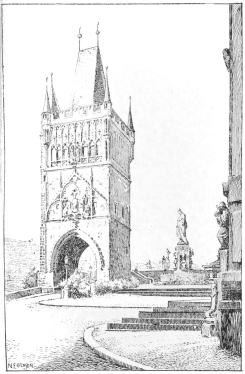
THE BRIDGE TOWER OF THE OLD TOWN
{46}
{47}
many art treasures. Zizka, the great leader of the Taborites—as the
more advanced Hussites were called, from the name of the town that was
their centre—here first showed his great military ability. The citizens
now became desirous for peace, while the Utraquist nobles who had
remained faithful to the Royal cause were yet reluctant to continue
warfare against those whose creed they shared. A truce was concluded on
November 13, according to which the Praguers were to give up the
Vysehrad to the Royal troops, while the Utraquist nobles promised to aid
their countrymen in defending the Hussite creed. Zizka and the more
advanced Church reformers, distrusting the compromise, left Prague for
the time, proceeding to Plzen, and afterwards to Tabor.
Meanwhile King Sigismund arrived in the Bohemian lands, of which he
claimed the succession as heir of his brother. He first proceeded to
Brünn (or Brno), the capital of Moravia. Many Bohemian nobles and
officials appeared at his court, and a deputation of the citizens of
Prague also appeared before him on December 29. The Praguers assured the
King of their loyalty, begging only ‘to be allowed to remain faithful to
that which they had learnt from the Holy Writ.’ Sigismund received the
envoys most ungraciously, obliged them to continue kneeling longer than
was customary, and overwhelmed them with reproaches and insults. He
finally dismissed them with the solemn command that they should, as a
proof of their obedience, cause the chains that had been placed at the
corners of the Prague streets for purpose of defence to be instantly
removed, and the fortifications which the citizens had constructed
opposite the Hradcany Hill to be destroyed. He also enjoined them to
inflict no further injury on the monks.
The magistrates of Prague did not dare to disobey{48} the Royal commands.
On January 4, 1420, the chains that had been placed in the streets were
deposited in the town hall of the Staré Mesto, and the fortifications
that had been erected on the approaches of the Hradcany were destroyed.
Many monks, priests and Germans who had left Prague during the recent
disturbances returned, believing that the hour of their triumph had
come. A contemporary chronicler[12] tells us that ‘the Germans laughed
and joyfully clapped their hands, saying, “now these heretical Hussites
and Wycliffites will perish, and there will be an end of them.” ’ The
Bohemian and Hussite citizens, on the other hand, not unnaturally looked
forward to the future with great apprehension.
Sigismund did not, as was expected, immediately proceed to Prague. He
for a time took up his residence at Breslau, the capital of Silesia,
where he collected a large armed force. Through his influence Pope
Martin V. issued a bull in which he called the whole Christian world to
arms against ‘the Wycleffites, Hussites, and other heretics, their
furtherers, harbourers and defenders.’
It is not perhaps easy for a modern reader to conceive the effect such a
declaration of war produced on the Bohemians, for a crusade had hitherto
almost always only been preached against heathens, infidels and Turks.
The whole nation rose in arms against Sigismund. The indignation was
particularly great at Prague, where the news was received that, by
orders of Sigismund, John Krasa, one of the leading citizens, had been
dragged through the streets of Breslau by horses and then burnt at the
stake. John of Zelivo, in his sermons, denounced Sigismund violently in
language drawn from the Apocalypse. The audience, inflamed by his
eloquence, swore to sacrifice life and fortune for the cause of the{49}
chalice. Those hostile to Church reform not unnaturally dreaded the
outbreak of hostilities, and we read that seven hundred families from
the old, and seven hundred families from the new town, either sought
refuge in the castles of Hradcany and Vysehrad, that were held by
Sigismund’s troops, or left Prague altogether. The citizens in no way
hindered their departure, which, indeed, in view of the coming siege,
was advantageous to the Hussite cause. Those who remained were yet more
determined to resist Sigismund to the utmost. On the suggestion of John
of Zelivo the citizens who remained in the town, the Hussite preachers,
and the members of the University, met on April 3 (1420) at the town
hall of the Staré Mesto. All present swore to defend, to the last drop
of blood, the right of receiving communion according to the Utraquist
faith, and to resist all, and particularly the so-called ‘Crusaders,’
who might endeavour to harm the Utraquists. As leaders in the defence of
the menaced capital they elected eight captains—four from the old and
four from the new—to whom the keys of the town gates and those of the
town hall were entrusted. The assembly addressed a manifesto to all the
towns of Bohemia, begging them to send envoys to Prague to concert on
the common defence. This manifesto attacked the Church of Rome in the
most violent manner. It was stated that the Roman Church ‘was not their
mother, but their stepmother; that she had poured out her poison like
the most furious serpent, and had raised up the cross, the emblem of
love and peace, for the purpose of inciting to hatred and murder; that
she had, by false promises of absolution, incited the Germans, born
enemies of Bohemia and of the Slav race, to begin the war of
extermination which they had always contemplated.’
Even the Regent, Cenek of Wartenberg, for a time{50} sided with his
countrymen. Together with other great noblemen he summoned ‘all
Bohemians and Moravians who were zealous for the Word of God and the
welfare of the Bohemian nation to join him in opposing the Hungarian and
Roman King Sigismund.’ Continuation of warfare was thus a certainty, and
the Hussites unfortunately again began to destroy the churches and
monasteries belonging to adherents of Rome.
Cenek of Wartenberg and the other Bohemian nobles were naturally
indignant at the conduct of their new allies. They therefore lent a
willing ear to the envoys of Sigismund. Wartenberg, abandoning the
national cause, concluded a private treaty with the King, that at first
remained secret. On the condition that he, his family, and the tenants
on his estates, should be allowed to worship according to the Utraquist
creed, he consented to admit the Royal troops into the castle on the
Hradcany. The citizens, exasperated by Wartenberg’s treachery,
endeavoured to recover possession of the castle, but their desperate
attack was repulsed by the Royal troops. Simultaneously, fighting also
began in the new town, the Royal troops that held the Vysehrad making a
successful sortie and defeating the citizens of the new town.
The Praguers now wished to negotiate with the King, while the Royal
troops had also suffered severe losses. An armistice of six days was
concluded, and the citizens sent another deputation to the King.
Sigismund, who was then at Kutna Hora, received the envoys even more
ungraciously than before. As the Praguers afterwards wrote to the
Venetians: ‘The King became harder than steel; as one stung by fury, he
began to agitate his limbs as a madman.’ He declared that it was his
duty to destroy all heresy by fire and sword, even should he have to
extirpate the{51} whole population of Bohemia and colonise the country with
foreign immigrants.
On the return of the envoys another meeting of the citizens took place
in the town hall of the Staré Mesto, where great enthusiasm prevailed.
It was again decided that all should risk their lives and fortunes for
the cause of religious freedom, and fight to the last. An Utraquist
nobleman, Hynek Krusina of Lichtenberg, was chosen as
commander-in-chief. A message was also sent to Zizka and the other
Taborite leaders, stating that ‘if they wished verily to obey God’s law
they should march to their aid without delay, and with as many men as
they could muster.’ After some skirmishing with the Royal troops, Zizka
and his men arrived at Prague (May 20, 1420), where they were joyfully
received by the citizens. From other parts of Bohemia also many
nationalists hurried to the defence of the menaced capital.
Hearing that the Praguers had received reinforcements, Sigismund did not
march straight on Prague, but proceeded to Melnik, where he halted for
some time. By his orders and those of the Papal Legate, Ferdinand,
Bishop of Lucca, horrible cruelties were committed against the
population of the neighbouring country, and particularly the citizens of
Slané and Litomerice.[13] In a period of intense religious passion such
cruelties inevitably led to reprisals. We read that the Hussites who
were besieging the Hradcany burnt alive nine Romanist monks in view of
the Royal garrison.
Sigismund, whose army had been reinforced by numerous ‘Crusaders,’ now
decided to march on Prague. Almost all countries of Europe contributed
to this vast army. According to a contemporary{52} writer there were
numbered among the Crusaders ‘Hungarians, Croatians, Dalmatians,
Bulgarians, Sicilians, Wallachians, Cumanians, Jazyges, Ruthenians,
Racians, Slovacks, Carniolians, Styrians, Austrians, Bavarians, Francs,
Swabians, Switzers, Frenchmen, Arragonians or Spaniards, Englishmen, men
of Brabant, Dutchmen, Westphalians, men of Saxony, Thuringia, the
Voigtland, Meissen, Lusatia, and the march of Brandenburg, Silesians,
Poles, Moravians and “renégate” Bohemians.’ A letter written by the
Praguers merely states that innumerable men from more than thirty
kingdoms and provinces arrived before their city, while Monstrelet, a
contemporary, writes that ‘Il arriva tant de gens qu à peine se
pouvaient ils nombrer.’ Most of the princes who ruled these countless
countries had accompanied their troops. We read that all the German
Electors, except the Elector of Saxony, Albert Duke of Austria,
forty-three men of princely rank, Brunorius della Scala of Verona, the
Patriarch of Aquileja, many counts of the empire, knights and nobles,
were with the crusading army.
Sigismund and his forces first entered the Vysehrad fortress, and then,
crossing the river, provisioned the Hradcany Castle, the siege of which
the Hussites were obliged to abandon. The vast army—according to the
chroniclers it consisted of 100,000 or 150,000 men, but the latter
figure is probably nearer to truth—now encircled Prague in every
direction. The German soldiers, who were encamped on the left bank of
the Vltava, opposite the Staré Mesto, insulted their enemies by
incessant cries of ‘Ha, ha! Hus! Hus! Ketzer![14] Ketzer!’
The Praguers and their scanty allies meanwhile fearlessly and
confidently prepared to encounter the world in arms against them. With
them, as afterwards{53}

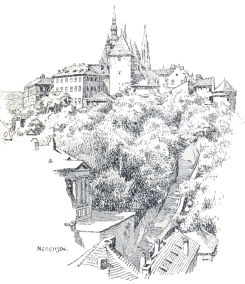
THE HRADCANY
with the Puritans, absolute confidence in Scripture rendered despondency
impossible; for, to borrow the words of Mr. John Morley, ‘No criticism
had then impaired the position of the Bible as the direct Word of God, a
single book one and whole, one page as inspired as another.’ A thorough
knowledge of the Old Testament is evident in all the contemporary
records of those stirring times. No man or woman{54} of Prague doubted that
the Lord, who had once struck down the forces of Sennacherib, would now
strike down those of Sigismund.
The 14th of July was fixed by Sigismund for the general attack. It was
decided that the Royal forces that were quartered in the Hradcany Castle
should attack the adjoining Malá Strana and the bridge tower on the left
bank of the Vltava, while the forces on the Vysehrad would endeavour to
storm the new town, which was at the foot of that fortress. A third army
was to attack the old town from the so-called Spitalské Pole (hospital
field), which was situated on the spot where the suburb of Karlin, or
Karolinenthal, now stands. An attack was also to be made on the hill
then known as the Vitkov, but which has, after the victorious Taborite
leader, since that day been called the Zizkov, or Zizka’s Hill. This
hill was the key of the position of the defenders, who depended on its
possession for maintaining their communications with the country. The
Zizkov was held by Zizka and his Taborites, who had thrown up slight
fortifications. The Germans attacked the hill with a strong force, and,
in spite of the heroism of Zizka, who fought in the front rank, for a
time drove the Bohemians back. One of the small earthworks was held for
a long time by only twenty-six men, two women and one girl, against
several hundred Germans. When the Taborites were for a time forced to
retreat, one of these women refused to leave her post, saying that a
true Christian must never give way to Antichrist. She was immediately
cut down by the Germans. This incident is very characteristic of the
indomitable religious enthusiasm that for a time rendered the Bohemians
invincible. The clanging of all the church bells hastily summoned the
citizens, who, led by a priest carrying the monstrance, hurried to the
aid of their allies.{55} The Germans were completely routed; many were
killed during their flight from the hill—then much steeper than at the
present day—and many perished in the Vltava. As soon as victory seemed
certain, the Taborites and Praguers knelt down on the battlefield and
intoned the ‘Te Deum Laudamus,’ while the whole town was filled with
unspeakable joy.
The other attacks on the city were also unsuccessful. Sigismund had
remained in the rear with part of his army, and returned to his camp as
soon as he saw the defeat of his troops. According to the Austrian
chronicler, Ebendorf of Haselbach, the King ‘smiled—it is said—over
the fate of the brave Christians who had succumbed to the heretics, who
had triumphed over them.’
On Monday, July 15—the battle had been fought on a Sunday—solemn
processions through the streets of Prague, led by the Hussite clergy,
took place in celebration of the great victory. Zizka, however, who
believed a new attack probable, hastily collected a large crowd of men
and women, who, under his direction, strengthened and enlarged the
fortifications on the Vitkov, the scene of the victory of the day
before.
The supposition of the Taborite leader, however, proved erroneous, for
the victory on Zizka’s Hill practically ended the siege of Prague. It is
as impossible to explain this as it is to account for the fact that the
by no means decisive defeat of Marathon should have induced the Persians
to abandon for a time their intention of conquering Greece. It is
certain that dissensions broke out in the vast camps of the Crusaders.
The foreign allies of Sigismund distrusted all Bohemians, even those who
were on the side of the King, while the latter, who had, as Palacky
writes, learnt that ‘even the largest force is insufficient to subdue a
strong and resolute people,’ now felt more disposed to listen to the{56}
words of those Bohemian nobles who, indeed, sided with their Sovereign,
but did not share the German desire to extirpate the whole Bohemian
nation. These men suggested negotiations between the King and his
Hussite subjects. Such negotiations were facilitated by the fact that
the united Hussites had, meanwhile, drawn up a summary of their demands,
which is known as ‘The Articles of Prague.’[15] It will here be
sufficient to state that the Bohemians demanded freedom of preaching,
the use of the chalice at communion, obligatory poverty of the clergy
and severe regulations against mortal sins. It was decided that a
conference should take place in the open air among the ruins of the Malá
Strana, at which the magisters of the University, with the chiefs of the
Praguers and Taborites, were to meet some German nobles, envoys of King
Sigismund, and the Patriarch of Aquilya, and Simon, Bishop of Trace, who
acted as representatives of the Papal See. The meeting led to no result,
as the representatives of the Roman Church declared that no decision of
the Church could be contested or discussed. The magisters of the Prague
University expressed surprise that the Papal envoys attributed greater
authority to the ‘fallible Church than to the infallible words of
Christ.’
The failure of these negotiations no doubt confirmed Sigismund in his
resolution of leaving the neighbourhood of Prague. The dissensions in
his army became more and more envenomed; serious epidemics broke out
among the troops; a great fire destroyed large parts of the encampments.
Before abandoning the siege, however, Sigismund caused himself to be
crowned King of Bohemia in St. Vitus’s Cathedral.
The writers hostile to Sigismund lay stress on the{57} absence of many
nobles whose Court dignities rendered their presence at coronations
necessary. They also mention that no representatives of the Bohemian
cities, none in particular of Prague, ‘the mother of all Bohemian
cities,’ assisted at the ceremony.
Two days afterwards Sigismund broke up his camp and retired to Kutna
Hora, thus giving the signal of departure to the Crusaders, who
hurriedly returned to their countries. Royal troops, however, continued
to hold the castles of Vysehrad and Hradcany.
The citizens now immediately began the siege of the Vysehrad. After a
time the defenders, who were suffering from hunger, were compelled to
conclude a truce for three days, according to which they would
capitulate if they had received no aid by the morning of November 1.
Sigismund meanwhile had returned to the neighbourhood of Prague with an
army consisting mainly of Moravians, and containing many Utraquist
nobles from that country. On the other hand many of the Bohemian nobles,
such as Hynek Krusina of Lichtenberg, who was first in command, Victor
of Podebrad (father of the future King), and many others openly joined
the national cause.
The Vysehrad Castle was now surrounded in every direction. Zavis
Bradaty, with the citizens of Zatec and Loun, and a large force of armed
peasants, were encamped between the Karlov[16] and the Botic stream.
Next to them were the troops of the Utraquist nobles and of the
Orebite[17] community, while the citizens of Prague held the post of
honour nearest to the village of Pankrac, whence the attack of the
relieving army was expected. At the last moment forty Taborite{58}
horsemen, led by Nicholas of Hus,[18] joined the Praguers.
The King arrived at the village of Pankrac on October 31, and sent a
message to the commander of his troops on the Hradcany telling him that
he would attack the citizens on the following morning, and ordering him
also to attack the bridge from the Malá Strana. ‘But’—as a contemporary
chronicler writes—‘God, who is ever an enemy of the haughty and a
friend of the humble, caused this message to fall into the hands of the
Praguers.’ The citizens and their allies therefore spent the whole night
in preparing for battle. The former trenches had, of course, been
constructed for besieging the Vysehrad; but the Praguers, who held the
most important position, hastily threw up earthworks on a spot where the
fish ponds, still frequent in that neighbourhood, rendered the attack
more difficult.
In the morning (November 1) Sigismund rode to the summit of a little
hill beyond the village of Pankrac, and in view of the Vysehrad, and
waved his sword as a signal to the garrison to attack the rear of the
enemy’s army. ‘But, as according to God’s will,’ the chronicler writes,
‘the hour had already passed, the garrison did not stir.’ A few German
soldiers who formed part of the garrison, indeed attempted to come to
Sigismund’s aid, but were held back by their Bohemian comrades. Seeing
that no sortie from the Vysehrad was intended, several of the Moravian
nobles rode up to the King and advised him not to attack the Praguers,
otherwise both he and his people would suffer much evil. The King
answered, ‘I must war with these peasants to-day.’ Then Henry of
Plumlov, Captain of Moravia, said, ‘Be certain that this day{59} will have
an evil end; I dread the fighting-clubs[19] of the peasants.’ The King
answered, ‘I know that you Moravians are cowards and faithless to me.’
Then Lord Henry and the other Moravian lords mounted their horses and
cried, ‘We will obey your order and we shall be there, where you will
not be.’ The nobles attacked the strong position of the Praguers with
great vigour, and for a moment the citizens wavered. Then Krusina
hurried to the spot where they stood, and exclaimed with a loud voice,
‘Dear brethren! turn back again and be to-day brave knights in Christ’s
battle, for it is God’s, not our fight, that we are fighting to-day. You
will see for sure that God will deliver all His and our enemies into our
hands.’ Hardly had he ceased speaking when the cry, ‘The enemy is
flying,’ was heard. The citizens speedily rallied, and, assuming the
offensive, drove the Moravian nobles back into the marshy ground that
extended from the Vysehrad to the village of Pankrac. A great massacre
of the nobles, whose heavy armour impeded their movements, took place,
and flight soon became general. Sigismund himself, who, regardless of
the taunts of the Moravian nobles had again remained with the rear of
his army, did not halt till he had reached the town of Cesky Brod. A
very large number of Moravian nobles fell in this battle, and many also
died of their wounds at the village of Pankrac, after receiving
communion in the two kinds, as the pious chronicler states. It is
touching to note that the Praguers sorrowed over the death of the
Moravian nobles, who, though they had fought against the city, yet
belonged to the same race as the citizens. The citadel of Vysehrad
surrendered on the day of the battle, and on June 7, 1421, the garrison
of the Hradcany—which had unsuccessfully{60} attempted a diversion during
the battle of the Vysehrad—also capitulated.
One of the most important results of the battles of the Zizkov and of
the Vysehrad was the temporary hegemony over Bohemia, or at least the
greatest part of the country, which the city of Prague obtained. The
‘mother and head of the Bohemian cities,’ which had gloriously and
successfully defended the religious and political liberty of the
country, not unfairly claimed the leadership. The once powerful Bohemian
nobility had been weakened by dissension. Some of its members still,
though reluctantly, remained faithful to Sigismund. Others, perhaps also
reluctantly, recognised the city of Prague as their over-lord, though
they never—as was the case in some Italian cities—became merged in the
mass of the citizens. The Taborites, who had taken but little part in
the ‘crowning mercy’ of the Vysehrad, had not yet attained the height of
their power.
The strong attitude assumed by the predominant city appears very clearly
in the manifesto[20] which the Praguers, in union with some of their
allies among the nobles, issued a few days after the victory of the
Vysehrad. This document is a stirring appeal to the national feeling,
and such an appeal has rarely remained unheeded in Bohemia.
After violent denunciations of Sigismund, who, it was stated, had
preferred to the Bohemians ‘the Germans and Hungarians, the cruellest
enemies of our nation,’ and who was ready to sacrifice a kingdom, were
there but no Bohemians in Bohemia, the citizens declared that they would
consider all who favoured such a King as men who desired the ruin of the
country. They would, therefore, consider such men as open enemies of God
and of the nation.
It is interesting to give a brief outline of the{61}

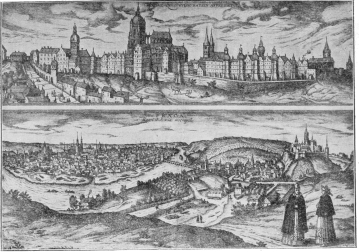
VIEW OF PRAGUE AND HRADCANY CASTLE
{62}
{63}
constitution of Prague at the moment of her greatest power. This
constitution may be defined as that of a theocratic republic, though
attempts to obtain a new Sovereign in succession to Sigismund always
continued. The principal legislative authority was at this period
concentrated in the ‘great assembly’ (Veliká Obec), of which almost all
citizens formed part, and which met in the open air in the
market-places. The executive power was in the hands of the burgomaster
and of the town councillors, who were elected by the great assembly.
Though the separation between the old town and the new town continued,
it seems at this period to have been an almost nominal one.
Less easy to define, but perhaps yet greater, was the influence of the
preachers, mainly founded on the almost exclusive interest in
theological controversy that was then general in Bohemia. John of
Zelivo, who has already been mentioned, for a time acquired boundless
popularity among the citizens. His influence largely contributed to
securing to Prague the hegemony over Bohemia, and after his downfall and
death, to which I shall presently refer, Prague soon lost its
predominant position.
Warfare with Sigismund continued in spite of his great defeat, and the
citizens of Prague played a prominent part in it. Their party, to
accentuate the hegemony of the city, is generally called ‘the Praguers’
by the old chroniclers, in distinction both from the Romanists and the
Taborites. The scene of the subsequent Hussite warfare was, however,
generally distant from Prague, and therefore requires no notice here. It
is only occasionally that Prague again becomes the centre of events.
Such was the case when, on April 21, 1421, ‘to the surprise and horror
of all Christendom,’ the Archbishop of Prague, Conrad of Vechta,
declared that he{64} accepted ‘The Articles of Prague,’ thus joining the
national Church. The news was joyfully received by the citizens of
Prague. The Te Deum Laudamus was sung and the bells of all the
churches were rung. All swore to obey the archbishop and to defend him.
Only a few of the preachers who were favourable to Tabor looked with
displeasure on the ‘healing of the anti-Christian monster.’ On the other
hand, Conrad was not unnaturally overwhelmed with abuse by the
Romanists. Dr. Tomek writes: ‘Archbishop Conrad was neither better nor
worse than the majority of the Bohemian ecclesiastics of high rank at
that period.’ To the student of the times a certain amount of scepticism
may, in an exalted Bohemian ecclesiastic of the period, appear, though
unpardonable, hardly inexplicable. Shortly afterwards, in accordance
with a decision of a meeting of the Estates at Caslav, a synod of the
Bohemian clergy assembled at the Carolinum in Prague.
Archbishop Conrad was indeed not present, but he had delegated as his
representatives several Hussite clergymen, of whom Magisters Pribram and
Jacobellus were the most eminent. The synod resulted in a failure,
mainly in consequence of the obstinacy of the delegates of Tabor.
Internal discord broke out in Prague not long after the failure of the
synod. Under the leadership of John of Zelivo, the democratic party in
the city acquired ever-increasing strength, and opposed the provisional
government of comparatively moderate views, which had been established
at the assembly of Caslav. The more moderate party firmly believed in
the possibility of securing an agreement with Rome, if the Bohemians but
limited their demands to ‘The Articles of Prague,’ and eschewed
ultra-revolutionary tendencies both in Church and State. That{65} the views
of the moderate Hussites were to a certain extent justified is proved by
the fact that a settlement on the lines they contemplated was eventually
obtained at the Council of Basel. But compromises are as distasteful to
religious as to political fanatics, and Zelivo’s influence rendered all
attempts at conciliation illusory. Zelivo’s undefined power became more
and more pronounced, and it is undoubtedly through his influence—though
evidence is not quite conclusive—that an Utraquist noble of moderate
views, John of Sadlo,[21] who had come to Prague to justify himself
against probably untrue accusations, was, when he appeared in the town
hall, immediately arrested and decapitated without trial or judgment.
Reaction against the ultra-democratic, or rather anarchist, party soon
increased among the citizens, and the influence of their aristocratic
allies was also used to the detriment of Zelivo. An eye-witness of his
fall and death has left us a detailed account of the events. John was
enticed to the town hall of the Staré Mesto, under the pretext of
seeking his advice concerning a new campaign against Sigismund. He was
at first kindly received, but the magistrates suddenly called in their
officials, who seized Zelivo. He attempted to remonstrate, but the
burgomaster of the old town said, ‘It cannot be otherwise, priest John!’
Zelivo was allowed time for confession, and then decapitated. Rioting
almost immediately ensued, particularly after a priest had shown John’s
head to the people. Many houses in the old town, particularly in the
Jewish quarter, were pillaged. The people insisted on the election of
new town councillors, and{66} several men, who were principally
instrumental in plotting Zelivo’s death, were decapitated. His death
none the less greatly diminished the power of the democratic party,
particularly in the old town, as no demagogue of equal ability succeeded
Zelivo.
Order was to a certain extent re-established in Prague during the short
rule of Prince Sigismund Korybut of Lithuania, a nephew of the King of
Poland, whom the Utraquist nobles wished to substitute to Sigismund of
Hungary as their ruler. Korybut arrived at Prague in May 1422, and
remained there to the end of that year. He unsuccessfully attempted the
siege of the Karlstyn that was still held by the Royal troops. This
failure, as well as the influence of the King of Poland, induced Korybut
to leave Prague, though, as events proved, only temporarily.
Shortly afterwards dissensions, ending in civil war, arose between the
Praguers and the Taborites. The internal dissensions were not, however,
of long duration, as the news of a new ‘crusade’ reunited all Bohemia,
and the Treaty of Konopist (1423) for a time restored internal
tranquillity. Unfortunately the truce lasted but for a short time. The
new crusade proved a yet greater failure than those that had preceded
it. The Germans and other crusaders speedily recrossed the frontier
without even having encountered the Hussites on the field of battle, and
we find the Praguers and Taborites again at war in 1424. Through the
intervention of Korybut, who had meanwhile returned to Prague, another
conference took place on the so-called Spitalské Pole (hospital field).
Mainly through the eloquence of a young preacher at the Tyn Church,
Rokycan, afterwards famous as Utraquist Archbishop of Prague, an
agreement was obtained. It is a curious proof of the mutual distrust
that prevailed that an agreement had{67} been previously made, according to
which the party that violated the truce should be fined a considerable
sum, and that a large heap of stones should be placed in the Spitalské
Pole for the purpose of stoning immediately all disturbers of the peace.
After the meetings at Konopist and on the Spitalské Pole, many others
took place, in all of which the minutiæ of theology were discussed with
that intense interest in religious controversy that was characteristic
of the Bohemians of that time; of such meetings we may mention that held
in the Hradcany in 1424, and the somewhat later one at the Carolinum.
Religious dissensions also caused the downfall of Korybut in 1427. The
clergy of Prague were then divided into two parties: the more moderate
one led by Magister Pribram, which Korybut favoured, and the advanced
one, which was more in sympathy with the Taborites, and which had as
leaders Rokycan, Jacobellus, and Peter Payne, who, in consequence of his
English origin, was known as ‘Magister Englis.’ He played a considerable
part in the contest, as a contemporary song tells us that—
‘The devil sent us Englis;
He walks stealthily through Prague,
Spreading doctrines from England
That are not wholesome for the Bohemians.’[22]
In consequence of Korybut’s support of the moderate party the advanced
Hussites resolved to depose him. On April 17, 1427, he was surprised,
captured without bloodshed, and conveyed to the Castle of Waldstein,
near Boleslav. In September some of the nobles of his party attempted to
obtain possession of Prague with the aid of Korybut’s partisans in the
city. They succeeded in entering the town, and penetrated as far{68} as the
Staromestské Námesti. Desperate fighting ensued, but the advanced
Hussites were finally victorious, and almost all the invaders were
killed or made prisoners. Shortly afterwards Korybut was released and
allowed to return to his own country.
It is only quite at the end of the Hussite Wars that the capital again
becomes the scene of strife. After the great defeat of the troops of the
last crusade at Tauss (or Domazlice), the Church of Rome had for a time
abandoned the idea of subduing Bohemia by force of arms. A Council
assembled at Basel, and after prolonged negotiations the Bohemians
consented to be represented there. Their envoys, among whom were
Rokycan, afterwards Archbishop of Prague; Prokop the Great, leader of
the Taborites; Nicholas of Pelhrimov, surnamed Biskupec; Peter Payne,
the ‘English Hussite,’ and many others arrived at Basel on January 4,
1433. The negotiations began there, and afterwards continued at Prague,
where the Council sent envoys, and where the Estates met in the
Carolinum on June 12. Though these negotiations with the Council as yet
proved unsuccessful, the delegates of the Council, before leaving Prague
in January 1434, urgently exhorted the Utraquist nobles to take a more
active part in the politics of their country, and to use their influence
in favour of an agreement with Rome.
These words made a great impression on the Bohemian nobility, which
viewed with great displeasure the almost complete extinction of its
formerly overwhelming power. The struggle in Bohemia now became rather
one between aristocracy and democracy than between contending religious
parties. In direct connection with this new phase of the Bohemian
struggle are the troubles{69} that broke out at Prague. Ever since 1429
great antagonism, founded partly on local, partly on political
differences, existed between the old and the new town. The former
gradually became an ally of the Utraquist, and even of the Romanist
nobles, while the men of the new town drew nearer and nearer to the
Taborites. In 1434 Ales of Riesenburg was elected Regent of Bohemia, and
a league ‘for the restoration of peace and order in the country’ was
formed. It was joined by almost the entire nobility of Bohemia and by
the citizens of Plzen, Melnik, and the Staré Mesto of Prague. The
citizens of the Nové Mesto refused to join the confederacy; guided by
the Taborite general, Prokop the Great, they began to prepare for war,
and barricaded their streets that were nearest to the old town. Called
in by the citizens of the old town, the nobles marched to their aid.
Unable to arrive there directly, they crossed the Vltava to the Malá
Strana, that was then under the rule of the old town. Joining the
citizens here they together attacked the new town, which was subdued
after some fighting. The men of the new town, who defended their town
hall, resisted for some time, but capitulated after receiving permission
to leave the city. A large part of the new town was pillaged by the army
of the nobles, and their allies, the victorious citizens of the Staré
Mesto, henceforth claimed supremacy over the new town.
Prokop hurriedly left Prague and wrote to Prokupek, the commander of the
Taborite forces before Plzen, that ‘by God’s permission the false barons
with the citizens of the old town have attacked our dear brethren, the
citizens of the new town; they killed some and conquered the town.’ A
few months later the great battle of Lipan resulted in the victory of
the aristocratic party, and the ‘fall of{70} Tabor,’ to use the words of
the great Bohemian historian Palacky.
The defeat of the democratic party paved the way to the recognition of
Sigismund as King. After prolonged negotiations at the Council of Basel
and meetings of the Estates at Brno and Jihlava,[23] the Bohemians
recognised Sigismund as their King, while he promised to obtain for them
certain religious concessions, of which the permission to receive
communion in the two kinds was the most important. A document known as
the ‘Compacts’ enumerated these concessions.
On August 23, 1436, Sigismund arrived at the gates of Prague, where he
was met by the magistrates of the three cities.[24] Amidst great
rejoicings of the people, he proceeded to the Tyn Church, where Mass was
celebrated by Archbishop Rokycan according to the Utraquist rites.
On the following Sunday, August 26, the magistrates of the three towns,
in the market-place of the old town, appeared before Sigismund, who was
sitting on a throne in his imperial robes, but wearing the Bohemian
crown. They brought to him the keys of the town gates, which Sigismund
immediately returned to them in proof of his entire reliance on their
fidelity. He also confirmed all the ancient privileges of Prague, and
again granted the men of the Nové Mesto independence from the old town.
The short period during which Sigismund was destined to reign over
Bohemia was yet sufficiently prolonged to witness the destruction of the
short-lived friendship between the King and his Bohemian subjects.
Sigismund, who was during his whole life a fervent adherent of the
Church of Rome, had accepted the Compacts as reluctantly as they had
been granted{71}

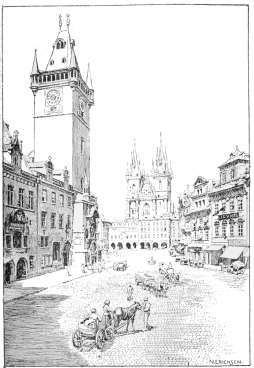
THE TOWN HALL AND MARKET-PLACE
{72}
{73}
by the Church of Rome. He had also promised to use his influence with
the Papal See to obtain the recognition of Rokycan as Archbishop of
Prague. The Estates had elected him to that office at a meeting which
they held in September 1435, but Rome now, and indeed always, refused to
recognise him as Archbishop of Prague. The attitude of Sigismund in this
matter was undoubtedly propitious. As Dr Tomek writes: ‘Publicly
Sigismund wrote to the Council recommending it to confirm Rokycan’s
nomination as Archbishop; secretly he advised the contrary.’ Bishop
Philibert of Contances, who had taken part in the previous negotiations
between the Council of Basel and the Bohemians, had accompanied
Sigismund to Prague. Though without any recognised position in the
country, Philibert endeavoured to exercise archiepiscopal functions at
Prague, thus encroaching on the rights of Rokycan. Discord between the
two ecclesiastics very soon began, and Philibert, who had assisted at a
religious service held by Rokycan in the Tyn Church, noted with great
displeasure that the sermon was preached in Bohemian, and that several
hymns were also sung in that language.
While Sigismund in these disputes favoured the Roman Church, to the
great displeasure of the Bohemians, other causes also contributed to his
increasing unpopularity. Sigismund had awarded all the State offices
either to Romanists or to such Utraquists as were nearest to Rome, thus
excluding the enormous majority of the Bohemians. The King’s cruelty to
the Taborite lord, John Rohác of Duba, was also viewed with great
displeasure by the people. Rohác had remained in arms even after the
general pacification. His castle, to which he had given the biblical
name of Zion, long resisted the Royal arms. He was finally obliged to
capitulate, and was by{74} Sigismund’s orders executed on the Staromestské
Námesti at Prague. This caused renewed warfare, as John Kolda, lord of
Zampach, who with Rohác was one of the few nobles who was to the last
faithful to Tabor, rose in arms against Sigismund.
Though there was thus no real concord, the short reign of Sigismund was
marked by a ceremony that formally concluded the Hussite Wars. Papal
legates brought the sanction of the Compacts to Prague. On April 13,
1437, a decree was read out in Corpus Christi Chapel, in the presence of
Sigismund, his Consort and the Papal legates, stating ‘that no one
should revile the Bohemians and Moravians for receiving communion in the
two kinds, or for availing themselves of the other right granted by the
Compacts, but that they should be considered true and faithful sons of
the Church.’ Tablets containing this statement were placed in the Corpus
Christi Chapel.[25]
This ceremony hardly even for a time interrupted the religious struggle.
The animosity of the Papal legate and the more veiled hostility of
Sigismund induced Rokycan, who had been deprived of his living at the
Tyn Church, to leave Prague and seek refuge at the castle of one of the
Utraquist nobles. Partly in consequence of incessant political and
ecclesiastical troubles, Sigismund’s already weak health now became
seriously impaired. He resolved to return to Hungary, but died on the
journey at Znaym (December 9, 1437).
Though most of Sigismund’s undertakings proved failures, he was
successful in his principal dynastic ambition, which was to secure the
succession to the Bohemian throne—Sigismund had no male heirs—to his
son-in-law Albert, Archduke of Austria. The{75}

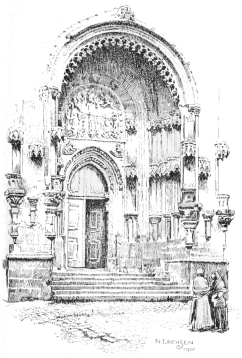
SOUTH PORCH OF TYN CHURCH
{76}
{77}
Bohemian Estates, though somewhat reluctantly, elected Albert as their
Sovereign, and he was crowned King of Bohemia at Prague on July 29,
1438.
During his short reign Albert obtained but little popularity in Bohemia.
A thorough German and a fervent Roman Catholic, his views, both as
regards racial and religious matters, were in opposition to those of the
majority of his new subjects. Though he had governed Moravia as
representative of his father-in-law, Sigismund, for a considerable
period, he had always declined to learn the Bohemian language, a point
on which the Bohemians have, perhaps not unnaturally, been very
susceptible at all times. Albert, who was also King of Hungary, was soon
obliged to return to that country. Sultan Murad the Second had invaded
Servia and the adjoining districts of Southern Hungary. During the
campaign against the Turks Albert was seized with sickness, and died
(October 27, 1439) after having only reigned two years over Bohemia.
A very tumultuous, almost anarchical, period in Bohemia followed the
death of Albert. The national or Utraquist party, headed by Ptacek, and
afterwards by George of Podebrad, was in constant conflict with the
Austrian or Romanist nobles, whose leader was Ulrich of Rosenberg. On
February 22, 1440, Albert’s widow gave birth to a son, known in history
as Ladislas Posthumus; but as the question whether the Bohemian crown
was hereditary or elective then was still in dispute, this did not
contribute as largely to the stability of the common-wealth as might
otherwise have been the case. Religious strife also continued. In 1448 a
new Papal envoy, Cardinal John of Carvajal, arrived at Prague, and was
at first joyfully received by the people. Public opinion, however, soon
changed. Carvajal declared that the Pope would never recognise Rokycan
as archbishop,{78} and expressed great disapproval when informed that in a
convent he visited communion was administered in the two kinds. His
conduct generally did not tend to give the Puritan Praguers a favourable
opinion of the dignitaries of the Roman Church. When negotiating with
George of Podebrad, the head of the national party, who referred to the
Compacts, the cardinal denied all knowledge of them. Podebrad therefore
sent him the original of that valuable document. Shortly afterwards,
Carvajal, frightened by the hostility of the citizens who threatened him
with the fate of Hus, precipitately left Prague. It was immediately
discovered that the Compacts had disappeared. Rokycan and Magister
Pribram appealed to the magistrates, and the cardinal was pursued by
armed forces. When arrested he was unable to deny the theft, but he
begged to be allowed, to avoid public disgrace, only to open his luggage
on his arrival at Benesov. This was granted to him, and he was escorted
to that town. Here the Compacts were found hidden away among his
luggage, and were brought back to Prague.
The mission of the cardinal thus proved an entire failure, and, indeed,
only envenomed the religious struggle. Civil war was inevitable; it was
only doubtful which party would begin hostilities.
It is probable that George of Podebrad and the other national leaders
had arrived at the conclusion that the differences between their party
and the Austrian one could only be settled by the force of arms, ever
since the failure of the negotiations which had taken place at the great
meetings of the Estates at Prague in 1446. Podebrad appears to have had
evidence proving that the attempts at a reconciliation which the
Bohemians had made through frequent embassies to Rome had been
frustrated by the secret machinations of Rosenberg, the leader of the
Austrian{79} and Romanist party. Still no warlike steps were taken till
after the failure of Carvajal’s mission to Prague. But immediately
afterwards Podebrad assembled an army of about 9000 men near Kutna Hora
and marched on Prague.
Municipal authority in the city was then in the hands of those
Utraquists whose views were nearest to those of Rome, but the large
majority of the citizens of Prague favoured the national party. To
pacify the people the magistrates had, immediately after Carvajal’s
departure, assembled the masters and priests at the Carolinum, and
enjoined on all present not to speak in a derogatory manner of the
Utraquist communion and the Articles of Prague. This decision was made
known to the citizens from the town hall, but it did not lessen the
distrust of the nationalists. After a vain attempt at negotiations, and
after having declared feud to the town, Podebrad obtained possession of
the Vysehrad by surprise and almost without loss of life (September 3).
Continuing their march before daybreak, Podebrad’s troops then took
possession of the adjoining Nové Mesto, and afterwards of the old town.
Here also Podebrad’s men met with little opposition. Their war cry,
‘Kunstat Hr,’[26] terrified their enemies, while it rejoiced the large
majority of the citizens who sympathised with Podebrad. The march of the
national army from the new town to the town hall of the old city, where
Podebrad and his principal generals took up their residence, became a
triumphal procession. The town-captain, Hanus of Kolowrat, and several
of the town councillors succeeded in making their escapes, but the
burgrave, Menhard of Hradec, was captured and imprisoned by order of
Podebrad.
The capture of Prague by Podebrad caused great{80} internal changes in the
capital. Rokycan returned to Prague, and was reinstated in all his
former dignities. On the other hand, the Romanist canons of St. Vitus’s
Cathedral mostly fled to Plzen. Podebrad’s rule did not however remain
uncontested. The lords and cities that were opposed to him formed a
league against him, which, from the town where his opponents met, was
called ‘the confederacy of Strakonic.’ A record of the desultory warfare
that ensued, in which Podebrad and the national party were generally
victorious, is beyond the purpose of this little book. Podebrad
continued to rule the country, and up to the time that Ladislas was able
to exercise, at least nominally, the royal power, he governed Prague
under the title of ‘Gubernator et rector civitatum Pragensium,’ the same
designation that Korybut had formerly assumed.

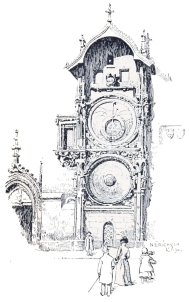 CLOCK TOWER IN TOWN HALL OF STARÉ MESTO
CLOCK TOWER IN TOWN HALL OF STARÉ MESTO
{81}
In 1452 the Estates of Bohemia met at Prague and recognised Ladislas as
their King, and in the following year he was, on October 28, crowned as
King of Bohemia in St. Vitus’s Cathedral. The ceremony was performed by
the Bishop of Olmütz, as King Ladislas, then only fourteen years old,
yet refused to be crowned by Rokycan, the Utraquist Archbishop of
Prague. In consequence of the youth of the King, Podebrad continued to
rule Bohemia, not without much difficulty, as the young King’s open
sympathy with Rome and marked hostility to Rokycan embittered the
enormous Utraquist majority of the Bohemian population.
Ladislas, who had proceeded to Hungary in 1456, returned in the
following year to Prague. Shortly after his return the young King, who
was on the point of being betrothed to Magdalen, daughter of Charles
VII., King of France, was attacked by a mysterious illness that was
similar to the Asiatic plague, if not identical with it. That terrible
illness had, since the Turkish invasion, spread widely in Hungary, from
which country Ladislas had just returned. The King summoned Podebrad to
his bedside, took leave of him in touching words, and then died on the
third day of his illness (November 23, 1457).
The body of Ladislas was conveyed to St. Vitus’s Cathedral on November
25. The Romanist chronicler, Eschenloer, who was then at Prague, writes:
‘The sorrow and wailing of the people was very great. Rokycan walked
nearest to the bier with his sacrilegious clergy, carrying the sacrament
and lighted candles. Then the good’ (i.e., Romanist) ‘clergy in small
number followed.’
The premature death of Ladislas again brought the difficult question of
the succession to the throne before the nobles and citizens of Bohemia.
Foreign candidates, such as William, Duke of Saxony, Charles{82} VII. of
France, who endeavoured to obtain the crown for his son Charles, and
Casimir, King of Poland, were represented by envoys when the Estates met
in the town hall of the Staré Mesto on March 1.
The Utraquist members of the assembly had, indeed, from the first
decided to choose one of their number, Podebrad, whom they considered
most worthy of the crown, but the votes of the Romanist envoys were
uncertain. Prolonged debates took place, which on the following day were
continued ‘with great seriousness and conscientiousness.’ Finally the
high burgrave, Sternberg, declared for Podebrad, and kneeling before his
old friend, exclaimed: ‘Long live George, our gracious King and Lord.’
All the other nobles and knights followed his example, and the unanimous
election[27] was enthusiastically received by the crowd that had
assembled outside the town hall. George was then conducted to the
neighbouring Tyn Church, where he was received by Archbishop Rokycan.
Though George had been chosen unanimously, difficulties arose almost
immediately with regard to his coronation, a ceremony to which the
Bohemians have always attached the utmost importance. Finally, through
the intervention of King Matthias Corvinus of Hungary, two Hungarian
bishops undertook to crown the King, and the ceremony was performed with
much splendour in St. Vitus’s Cathedral on May 7, 1458. The chroniclers
state that when the crown was placed on the King’s head one of the
largest jewels fell to the ground. This was afterwards interpreted as
signifying that Breslau, which as capital of Silesia was one of the
greatest towns in the lands of the Bohemian crown, would never be in
Podebrad’s power. During his{83}

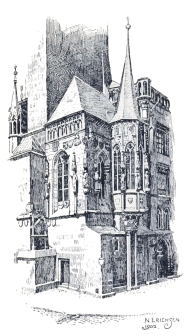
CHAPEL OF TOWN HALL
{84}
{85}
eventful reign (1458-1471) King George was engaged in constant warfare
with the rebellious Catholic nobles and with King Matthias of Hungary.
That prince had indeed been an ally of George at the beginning of his
reign, but his views changed when it became certain that an agreement
between the Papal See and Podebrad was impossible. The King of Hungary
now declared war against Bohemia, and attempted to supplant George as
ruler of that country.
In 1452 the King assembled the Estates at Prague; the Bohemian envoys,
who had just returned from Rome, the Papal legate and the Romanist
bishops of Breslau and Olmütz were also present. The King presided,
sitting under a baldachin with his consort, Queen Johanna, at his right
and his sons at his left. Podebrad spoke strongly of the treachery of
the Roman Court, and ended by declaring ‘that the Pope should know that
he would not sell his faith for a kingdom, that he, his wife and his
children were ready to risk their kingdom and their lives for the
blessed blood’ (i.e., communion in the two kinds). This speech greatly
affected all present, few of whom could refrain from tears.
The campaigns that occupied the last years of Podebrad hardly belong to
a history of Prague.
On February 22, 1471, Archbishop Rokycan died, only a few weeks before
his old ally King George, who died of dropsy on March 22 of the same
year.
It had, no doubt, originally been a favourite design of Podebrad to
found a national dynasty in Bohemia, but the necessities of his frequent
wars had obliged him to favour the succession of Prince Vladislav of
Poland, thus securing the valuable help of Poland for his country. It
had indeed been tacitly settled during George’s lifetime, but the
Estates maintained their traditional right of choosing their King, and
met for{86} that purpose at Kutna Hora. Besides Vladislav, several other
candidates strove to obtain the Bohemian crown. The most important were
Albert, Duke of Saxony, and King Matthias of Hungary. The whole
influence of Rome was used in favour of the last-named candidate. The
letter which the Papal legate, Rudolph, Bishop of Breslau, addressed to
the Bohemians, and Praguers in particular, is interesting as formulating
the argument against Hussitism, founded on the decline of Prague, that
has been, before and since that time, constantly repeated. After stating
that Christ on leaving the world had appointed St. Peter his
representative, and that the Roman bishops, whom all faithful Christians
should obey, were his successors, the legate admonishes the Praguers to
remember the former glory of their city, which, while it was faithful to
Rome, had surpassed all other towns, even Nuremberg, Cöln and Vienna, in
wealth, power and wisdom; even Florence, Venice and Rome had scarcely
equalled her.[28] The citizens should therefore abandon their Hussite
errors and recognise Matthias as their King. This appeal does not appear
to have impressed the Praguers or the other Bohemians much, for
Vladislav was elected King with but little opposition. He arrived at
Prague on August 19, 1471, and was met outside the town by the clergy
and the people, who conducted him to the Royal residence. He was there
presented with a Bible by the magisters of the University, ‘that reading
it he{87} might learn to rule both himself and his people according to the
will of God.’
Vladislav, as Palacky has noted, was the first Bohemian Sovereign who
was almost constantly absent from the country, while his consort, Anna
de Foix, was the only Queen of Bohemia who never set her foot on the
national soil. Vladislav, as was inevitable in consequence of his
education, favoured the Romanists as far as it was in his power to do
so. Through his influence the principal municipal offices at Prague were
entrusted to men who, though nominally Utraquists, favoured the cause of
Rome in every way. During the absence of the King riots broke out at
Prague in 1483. The more ardent Hussite preachers violently attacked the
government both of the King and of the town magistrates. The magistrates
of Prague therefore resolved to seize these preachers, and it was
rumoured that they had, in union with the magistrates of the Malá Strana
and some Romanist lords, resolved a general massacre of the Utraquists
in the city. One of the magistrates of the old town, Tomasek, surnamed
‘of the Golden Star,’ was reported to have told a neighbour, a fervent
Hussite, that on the Sunday before St. Wenceslas (September 28) ‘they
would give the Utraquists bloody cakes to eat.’ The menace was of course
understood. Both parties began arming, and on September 24 civic warfare
began. The great bells of the Tyn Church were rung, and the people
stormed the neighbouring town hall. The burgomaster was, according to
what may almost be called a national custom, thrown from the windows of
the town hall, and several of the councillors were wounded or
imprisoned. Far more sanguinary were the events in the new town. Here,
also, the town hall was stormed, many of the town councillors were
killed, and a general massacre of Romanists, particularly priests and
monks, ensued.{88} Finally, in the new and in the old town, as well as in
the Malá Strana—where the revolution appears to have been far less
violent—new magistrates were elected, and the magistrates of the three
towns concluded an alliance for mutual defence. King Vladislav, who had
approved of the plans of the former magistrates—it is impossible to
state to what extent—was powerless.
The citizens of Prague, indeed, for a time obtained almost complete
autonomy, which they preserved up to the reign of Ferdinand I., and to a
certain extent up to 1547.
Vladislav died in Hungary in 1516, and was succeeded by his son Louis,
who had already been crowned as King of Bohemia when a child of three
years. Louis, like his father, was King of Hungary also, and spent a
great part of his life in that country.
As his representative in Bohemia, he appointed Leo of Rozmital, but
afterwards replaced him by Duke Charles of Münsterberg, a grandson of
King George, who assumed the title of Regent. Though the latter
attempted somewhat to curb the turbulent citizens, yet Prague enjoyed
almost complete independence, and feuds not dissimilar from those of
ancient Italian cities broke out. Personal ambitions and animosities
masqueraded in the garb of religious differences. We possess a precious
contemporary account of these struggles in the chronicles of Bartos,
surnamed ‘The Writer.’ Two demagogues, Pasek and Hlavsa,[29] contended
for the supremacy over the citizens of Prague; both belonged to the
Utraquist Church, but while the views of Hlavsa, who was largely
influenced by Gallus Cahera, rector of the Tyn{89} Church and a personal
friend of Luther, were more advanced, Pasek belonged to that shade of
Utraquism that was nearest to Rome. Bartos has eloquently described the
conflicts that arose. I can here only allude briefly to the coup
d’état of 1524, by which the reactionary party for a time obtained the
upper hand. On August 9 a crowd of Pasek’s partisans invaded the town
hall of the Staré Mesto and arrested all councillors who were of the
Lutheran creed. Pasek henceforth ruled over Prague as a dictator, and
issued severe decrees against all who ‘favoured foreign heresies.’
King Louis, who was then residing in Hungary, received the news of the
success of the reactionary party with great joy, but the ever-increasing
danger from Turkey did not admit of his interfering actively in the
affairs of Bohemia.
Two years later King Louis perished at the Battle of Mohác, in Hungary,
and the Bohemian throne was again vacant.
The death of King Louis found the lands of the Bohemian crown in a state
of almost complete anarchy, as both Vladislav and Louis had given their
attention mainly to the other countries over which they ruled. Yet the
question as to the hereditary character of the throne still being
undecided, as soon as the news of the death of the King reached Prague,
September 9, 1526, it was rumoured that many princes, undeterred by the
precarious condition of the country, aspired to the Bohemian throne.
These were, besides Archduke Ferdinand of Austria, brother-in-law of the
late King, two Bavarian and two Saxon princes, Sigismund, King of
Poland, and two great Bohemian nobles, Leo of Rozmital and Charles of
Münsterberg. The Estates met at Prague on October 8, and the
deliberations were somewhat prolonged. It was finally decided that each
Estate should choose four electors from their number.{90} The twelve
electors met on October 23 in the Wenceslas Chapel of St. Vitus’s
Cathedral. When they had finished their deliberations, they stated that
they had chosen a King, but that the choice would only be made public on
the following day. On October 24 Leo of Rozmital announced to the
Estates assembled in the Hradcany Castle that Archduke Ferdinand of
Austria had been elected King. All present then sang the national song
‘Svaty Václave.’ On February 24 of the following year Ferdinand was
crowned in St. Vitus’s Cathedral. The following days were spent in great
rejoicings, tournaments and balls in the Hradcany Castle. It was noted
that—the Queen only excepted—the new King danced with no lady but the
wife of Leo of Rozmital, whose exertions had largely aided him in
obtaining the Bohemian crown.
The life of Ferdinand, who was also King of Hungary, frequently ruler of
Germany, and Roman Emperor during the last years of his life, has only
occasional connection with Prague. The fact that he caused the beautiful
Renaissance building known as the Belvedere to be erected at Prague
proves, however, that he was not devoid of interest in his Bohemian
capital. Ferdinand strenuously endeavoured to strengthen the Royal power
in Bohemia. He rescinded the decree of the demagogue Pasek, which had
united the old and the new town in one community; and Pasek, though he
vainly attempted to curry favour with the King, was struck off the list
of the magistrates.
Gallus Cahera, preacher of the Tyn Church, who had now joined the
reactionary party, was exiled from all the Habsburg dominions, and in
1530 Pasek himself was for a short time expelled from Prague. On the
other hand, Hlavsa and some of his Lutheran partisans, who had been
exiled by Pasek, were permitted to return to the Bohemian capital.{91}

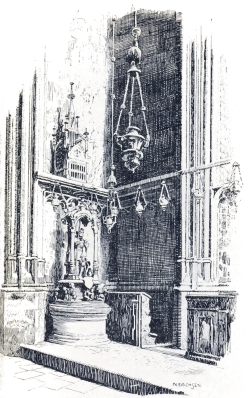
WENCESLAS CHAPEL, ST. VITUS’S CATHEDRAL
{92}
{93}
Though Ferdinand, as these facts prove, showed more moderation—at least
at the beginning of his reign—than the Bohemians had expected, he was
yet unable to establish religious tranquillity in the country. He was
more successful in his endeavours to strengthen the Royal prerogative
and limit the power of the Estates. That power was to a great extent
founded on their right of electing the Sovereign. It was, therefore, a
great success for the Royalist cause when the King, skilfully using the
circumstance that a great fire in Prague (1541) destroyed all the
ancient State documents, succeeded in persuading the Estates to
recognise a new charter, which declared that Ferdinand had been accepted
as King in consequence of the hereditary rights of his wife, Queen Anna,
who was a sister of King Louis. It must, however, be mentioned that this
curtailing of the privileges of the Bohemian Estates contributed to the
revolutionary movement of 1547.
In that year troubles broke out in Bohemia in connection with the war
that Charles V. and his brother Ferdinand were waging against the
leaders of the German Protestants, John Frederick, Elector of Saxony,
and Philip, Landgrave of Hessé. Ferdinand claimed military aid from his
Bohemian subjects, which the then almost entirely Protestant population
of the country was not unnaturally unwilling to grant. Sixt of
Ottersdorf, who, as clerk, and afterwards chancellor of the old town,
played a considerable part in these events, has left us an interesting
account of these troubles.[30] In 1546 Ferdinand assembled the Estates
and urged them to equip an armed force against the Turks. They
consented, but when it appeared that their levies were to attack, not
the Turks, but Saxony, the largest part of the Bohemian army refused to
cross{94} the Saxon frontier. On January 1, 1547, Sixt of Ottersdorf
presented to King Ferdinand—who, during the then customary interruption
of hostilities in winter, had returned to Prague—the usual new-year
gifts on the part of the citizens, ‘expressing in a Latin speech hopes
that the coming year would end all disturbances and wars in the
Christian world; for they were caused only by some unquiet men.’ In
reply to this ambiguous speech the King stated that he accepted their
gifts and good wishes, and that he hoped that with the aid of the
Praguers and his other subjects he would shortly be able to restore
peace to the empire. On the following day the King ordered the citizens
of the old and new towns to equip 300 armed men each. This, as the
contemporary writers state, caused great displeasure, as the citizens
had no doubt that they were ordered to arm against the men of their own
faith.
A few days later he decreed a general arming of the people, reminding
the Bohemians of an ancient decree, according to which those who did not
give their aid when Bohemia was in danger should lose their lives and
their estates. He therefore summoned all to join him in arms at
Litomerice, but a few Romanist lords alone obeyed the Royal command. The
feeling was general that the Diet’s sanction was necessary for such a
general armament. The Praguers took the lead in the opposition to
Ferdinand, and the movement in their city had a strongly democratic
character.[31] Mistrusting the energy of their magistrates, the
citizens, both of the old and of the new town, at a general meeting on
January 23, 1547, resolved that in future all matters of great
importance should be decided at general meetings of the{95} citizens, who
were to be called together by the town bells. They further declared that
a general arming of the people, without the consent of the Diet, was
contrary to the law of the land. Many Bohemian towns, such as Kolin,
Kourim, Caslav, Cesky Brod, made common cause with Prague, which they
recognised as the ‘head of the Estate of the citizens.’ Many knights and
nobles, particularly those who belonged to the ‘unity’ of the Bohemian
brethren, were in sympathy with the towns, and, indeed, agreed to their
suggestion that a meeting of the Estates should take place. This was
distinctly unconstitutional, as the King alone had the right of
summoning the Estates. On February 13 a private meeting of the nobles
took place at the house of Lord Bohus Kostka, in the Celetná Ulice. All
present agreed to act in accord with the citizens, and after a prolonged
conference ‘proceeded to the Staromestské Námesti singing “True
Christians, let us strongly hope”; they then lifted their hats, berets
and caps when passing the Tyn Church, and retired to their abodes.’
A more formal meeting of the Estates took place in the following month.
King Ferdinand had, indeed, written from Dresden to the high officials
of Prague, ordering them to do everything in their power to prevent this
meeting of the Estates, who had not been summoned by their King. They,
none the less, met on March 18 at the Carolinum, where 800 nobles,
knights and representatives of the Bohemian towns (except Plzen and
Budejovice) were present. They formed a confederacy and formulated their
demands in forty-five articles, which mainly tended to curtailing the
Royal prerogative, securing religious freedom, and affirming the
elective character of the Bohemian throne. It was resolved to bring
these demands before King Ferdinand by a deputation chosen from among
the{96} members of the Diet, and the Estates also entered into negotiations
with the Protestant princes of Germany, and resolved to equip an army.
Shortly afterwards the news of the great Protestant defeat at Mühlberg
(April 24, 1547) reached Prague. The citizens at first discredited the
truth of the reports, but when the evil news was confirmed they, as well
as the other Bohemians, found themselves obliged to confront the
difficult position to which a policy, which was at once venturesome and
timid, had led them; for they had acted in a manner that would
necessarily irritate their Sovereign, while they had done little or
nothing to aid the Protestant cause. It was finally decided to disband
their army—this was one of Ferdinand’s principal demands—to
congratulate Ferdinand on his victory, to alter the instructions that
had been given to the envoys who were to bring their claims before the
King, while still maintaining the grievances of the Bohemians. The
envoys—among them was Sixt, the historian—joined the King, with whom
was his brother, Charles V., in the camp before Wittenberg, which they
were then besieging. They were received both by the Emperor and by
Ferdinand, who told them that they would later signify their pleasure
with regard to Bohemia. The Estates should meanwhile renounce all
alliances that were hostile to their King.
Ferdinand had already decided to avail himself of the momentary position
for the purpose of strengthening the Royal power. Acute politician as he
was, he clearly saw that nothing would so greatly further his purpose as
causing dissension among the Bohemian Estates. He resolved to deal more
severely with the towns than with the knights and nobles. He marched to
Litomerice with a large force, and here issued a proclamation, stating
that he would receive graciously{97}

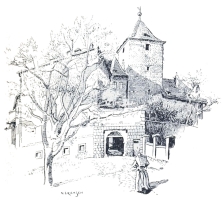
THE EAST GATE OF THE HRADCANY
all knights and nobles, who had been merely misled by others; of the
townsmen no mention was made. On July 2 Ferdinand arrived at Prague, and
first occupied the Hradcany Castle without resistance. His army,
consisting principally of Spaniards and Walloons, then surrounded the
old and new towns, committing great depredations in the outskirts of
Prague. Some fighting took place, and the lower order of the Praguers
began to arm, and decided to defend the bridge. The counsels of the
wealthier and wiser citizens, who knew that resistance was hopeless,
however, soon prevailed, and the cities surrendered. Ferdinand summoned
the more important citizens to appear before him at the Hradcany Castle.
On July 8 he received the deputies, about 600 in number, in the{98} hall of
Vladislav. With the King were the great dignitaries of Bohemia and
Moravia, the Bishops of Olmütz and Breslau, and Prince Augustus, brother
of Maurice of Saxony.
It is a proof of the importance of the town of Prague that it was
customary that the Bohemian King should give his hand to the magistrates
of the city when they appeared before him. On this occasion, however,
Ferdinand omitted to do this, and, indeed, turned his back on the
citizens as a mark of displeasure. Some time elapsed before he ordered a
paper that contained the grievances against the citizens of Prague, who
were accused of being the principal instigators of the recent
disturbances, to be read to the deputies. The townsmen attempted no
defence, and, in their name, Sixt of Ottersdorf declared that the
citizens surrendered unconditionally to their Sovereign. The King
ordered Ludanic, Captain of Moravia, to inform the citizens that he
would shortly convey his decision to them. He had meanwhile ordered
Jacob Fikar, burgomaster of the old town, and one of the town
councillors, who had both not appeared before him, to be arrested. Then
only were the citizens informed of the conditions under which they would
be pardoned. They were to abandon all confederacies, even those between
the Prague cities, to surrender all papers dealing with their
negotiations with the Elector of Saxony, to submit for revision all the
papers containing the ancient privileges of the Prague cities, to give
up all arms, and to return to the Crown all landed estates that belonged
to it, but had been temporarily granted to the citizens. The last
paragraph, in a somewhat veiled manner, stipulated the confiscation of
considerable estates that had long belonged to the Prague cities. The
citizens were, however, obliged to accept all the King’s demands.{99}
The King then convoked the Estates for August 22, but he resolved that,
as a deterrent example, the execution of the four most prominent
national leaders should immediately precede this meeting of the Diet,
which has ever since been known as the Krvavy Snem (i.e., bloody
Diet). On August 20 two knights and two citizens, one of whom was Fikar,
were decapitated on the market-place before the Hradcany Castle. Other
less severe punishments were inflicted on some of the members of the
nationalist leaders, particularly on those who were members of the
community of the Bohemian Brethren, who were suspected of having
strongly favoured an alliance with the German Protestants. The head of
that community, John Augusta, was arrested at Litomysl, imprisoned in
the ‘White Tower’ on the Hradcany, and cruelly tortured there.
The ‘bloody Diet’ accepted all the King’s proposals, though they largely
limited its powers, and comparative quiet continued in Prague during the
remaining years of Ferdinand’s rule.
Ferdinand died in 1564, and the news of his death reached Prague on July
28. His eldest son, Maximilian, who had already been crowned King of
Bohemia, succeeded his father without any opposition. His well-known
inclination to Protestantism rendered the Utraquist majority of the
Estates favourable to him, while the Romanists were traditionally
partisans of the House of Habsburg.
Little need in this sketch of the story of Prague be said of the twelve
years (1564-1576) during which Maximilian reigned over Bohemia. He
visited Prague and held Diets there in 1567, 1571 and 1575. On these
occasions the proceedings were similar and, it may be added, monotonous.
Maximilian invariably demanded grants of money to enable him to carry
on{100} war against the Turks, and the Estates, with equal regularity,
claimed that further concessions should be made to the Utraquists, or
rather Protestants as they should now be called. At the Diet of 1575 the
Lutherans and Bohemian brethren jointly drew up a profession of faith
which is known as the ‘Confessio Bohemica.’ The King did not indeed
recognise it, but he granted the Protestants, now the great majority of
the population, independence from the old Utraquist consistory. They
were allowed to choose fifteen ‘defenders,’ five from each Estate, to
whom the government of the Protestant Church was to be entrusted. No
doubt, largely in consequence of this concession, the Estates accepted
Maximilian’s eldest son, Rudolph, as heir to the throne, and consented
to his coronation during the lifetime of his father. Some objections
were raised with regard to Rudolph’s ignorance of the Bohemian language,
and it was stipulated that he should, in the absence of his father,
reside in Prague, that he might thoroughly learn the language and the
laws of the country over which he was once to rule.
The Estates deputed seven nobles and seven knights, who proceeded to the
Karlstyn on September 20, for the purpose of fetching the Royal insignia
of Bohemia that were preserved there. On their return the coronation
took place, with the same ceremonial as that of Maximilian, who had also
been crowned during the lifetime of his father. According to the custom
Rudolph was crowned in St. Vitus’s Cathedral. He first proceeded to the
Chapel of St. Wenceslas, where the Romanist Archbishop and his clergy
received him. He then entered the main church, and the burgrave, William
of Rosenberg, then asked the assembled Estates whether they consented to
the coronation of Rudolph as King. They all, with loud voices,{101}

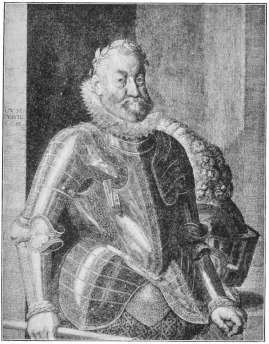
RUDOLPH II.
{102}
{103}
expressed their consent. Rudolph was then crowned by the Romanist
Archbishop, with the assistance of William of Rosenberg.
The accession of Rudolph to the Bohemian throne followed very closely on
his coronation. Maximilian died in 1576, and his son immediately
proceeded to Prague, where he resided almost continually during his
reign. His life is therefore in closer connection with Prague than that
of almost any other Bohemian ruler, Charles IV. only excepted.
Rudolph’s character was a very singular one, and it is certain that he
occasionally suffered from melancholia. With a thorough knowledge and a
great love of art, he combined an intense dislike of the affairs of the
State. No king did more for the embellishment of Prague. According to a
contemporary epigram, Prague, that had been of wood at the time of
Libussa, afterwards became marble, but golden under Rudolph. Rudolph was
a great collector of paintings, sculpture, and even mere ‘curiosities.’
His agents travelled all over Europe; thus Albrecht Dürer’s ‘Madonna,’
one of the few picture’s from Rudolph’s collection that is still at
Prague, was purchased at Venice and carried ‘by four stout men’ across
the Alps to Prague.
Among the artists who, on Rudolph’s invitation, visited Prague, was the
engraver Sadeler, a native of the Netherlands. His engravings of
Prague—three of which are reproduced in this volume—are among the most
interesting ancient records of the city.
More questionable was Rudolph’s taste for chemistry and astronomy, or
rather for alchemy and astrology. The astronomers Keppler, Tycho Brahe,
and his assistant Tennagel, who afterwards fell in disgrace, were
Rudolph’s guests on the Hradcany. His taste for alchemy attracted many
to Prague who were supposed{104} to be adepts in that science. It must,
however, be stated in defence of Rudolph that alchemy was by no means,
in his day, an utterly discredited science. Even a century later Spinoza
considered it as worthy of consideration. Rudolph by no means hesitated
to punish those alchemists whom he considered as impostors. It is
interesting to note that among these alchemists there were two English
adventurers—Dr. John Dee and Edward Kelley.[32]

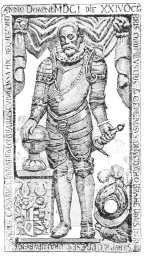 TOMBSTONE OF TYCHO BRAHE IN TYN CHURCH
TOMBSTONE OF TYCHO BRAHE IN TYN CHURCH
The earlier years of Rudolph’s reign were a period of peace and
prosperity in Bohemia. His latter years were embittered by the treachery
and perfidy of his ambitious younger brother Matthias. The real cause of
the conflict was that Rudolph, who had no legitimate offspring, refused
to make any arrangements as to the succession{105} to the thrones of Bohemia
and Hungary. It was as a mere pretext that Matthias brought forward the
grievance that Rudolph had refused to sanction a treaty with Turkey that
he had concluded in his brother’s name. Matthias occupied Moravia, and
took possession of that country almost without resistance. He then
entered Bohemia and advanced as far as Caslav. Rudolph, though
reluctantly, summoned the Bohemian Estates to Prague on May 8, 1608.
Though the usual ecclesiastical grievances were brought forward, it soon
became evident that the Bohemians did not wish to abandon Rudolph in
favour of his brother. The latter had meanwhile advanced as far as
Liben,[33] where peace negotiations took place. A treaty was finally
signed there by which Rudolph ceded Upper and Lower Austria and Moravia
to his brother, but retained Bohemia for his lifetime. In the evening
Matthias gave a large banquet in his camp; there were two tables, at
each of which a hundred guests were seated. Many healths were drank, and
a somewhat scandalous contemporary writer tells us that many of
Rudolph’s envoys ‘only returned to Prague about midnight, and very
intoxicated.’
Even the cession of almost all his possessions did not ensure Rudolph’s
tranquillity during the remaining years of his life. Many nobles who had
sided with him against his brother now again brought their demand of
religious freedom before him. The leader of the Protestants was now
Wenceslas of Budova, whose pious and somewhat Puritan character renders
him one of the most interesting figures of the last years of Bohemian
independence. When Rudolph had prorogued the Diet of 1609 the Estates
continued their meetings in the{106} town hall of the Nové Mesto. Budova,
who presided, always began the deliberations by calling on all present
to pray. All then knelt down and sang a hymn.
For a moment civil war seemed inevitable. Rudolph’s attitude, indeed,
had at first been conciliatory. He has been credited by various
historians with a religious fanaticism that was absolutely alien to his
nature. Yet the Spanish ambassador, Zuniga, and Archduke Leopold, a
kinsman of Rudolph’s and a brother of Archduke Ferdinand, afterwards
King of Bohemia, succeeded in persuading the apathetic Sovereign to send
a message to the Estates, in which he promised the Protestants the same
amount of toleration which they had enjoyed under Ferdinand I.; he thus
withdrew even the concessions that had been made to the Protestants by
the more liberal-minded Maximilian. The Protestant Estates considered
this message as a declaration of war; they decided to arm, and chose
thirty ‘directors’—ten from each order—who established themselves at
the town hall of the Staré Mesto, forming, as the historian Gindely
says, a provisional government. Rudolph, however, finally gave way, and
on July 9, 1609, signed the famed ‘Letter of Majesty.’ He recognised the
‘Confessio Bohemica,’[34] granted the Protestants the administration of
the University, and empowered them to elect thirty ‘defenders’ from
their number who were to act as guardians of the rights of the
Protestants.
There is no doubt that Rudolph granted these extensive concessions
reluctantly, and that he sought an opportunity for retracting them. He
entered into negotiations with Archduke Leopold, who was then Bishop of
Passau. Under the pretence of interfering in the religious troubles that
had broken out in Germany,{107} Leopold collected a considerable armed
force, which in 1611 invaded Bohemia. Leopold, no doubt, wished to free
Rudolph from the control of the Protestants, and probably hoped to
obtain the Bohemian crown as a reward, to the exclusion of Matthias and
of his own brother Ferdinand. The men of Passau soon occupied a large
part of Southern Bohemia, marched rapidly on Prague, and encamped on the
White Mountain, immediately outside the city walls. After scaling the
walls of the Malá Strana they attacked the neighbouring Hradcany Castle,
where Leopold was then residing as a guest of Rudolph. Desperate
fighting in the Malá Strana took place between the men of Passau and a
small force that the Bohemian Estates had hurriedly raised, and which
was commanded by Count Thurn. The invaders succeeded in driving the
Bohemians from the Malá Strana, but their attempt to obtain possession
of the bridge, and thus to secure access to the old town, failed.
Leopold, who thought victory certain, now assumed the command of his
troops, and summoned the old and new towns to surrender. This was
declined, and as the army of the Estates received constant
reinforcements, Leopold and his troops were obliged to leave Prague
secretly on the night of March 11. Matthias had meanwhile arrived at
Prague, and Rudolph was forced to abdicate in his favour. He did not
long survive his deposition, but died on January 10, 1612.
During the brief reign of Matthias (1611-1619) the religious troubles in
Bohemia continued and reached their climax in the famous defenestration
of Prague. Matthias, like his brother, was childless, and the question
of the succession to the Bohemian throne was therefore urgent. The
Estates met at Prague in 1617, and through the influence of the
Government{108} officials, Archduke Ferdinand of Styria was accepted as heir
to the throne. Only one of the officials, Count Thurn, burgrave of the
Karlstyn, opposed the acceptation, and was therefore deprived of his
office. The decision which assured the Bohemian crown to Ferdinand, a
determined persecutor of the Protestants, necessarily hastened the
progress of events. The Protestants knew that war to the knife awaited
them; the only question was when hostilities should begin. The
initiative finally, however, came from the Catholics. In direct
violation of the agreements of 1609[35] the Romanist Archbishop of
Prague caused the Protestant church at Hrob (or Klostergrab) to be
destroyed, while the abbot of Broumov (Braunau) ordered the Protestant
church in the town of that name, which was under his jurisdiction, to be
closed.
The Protestant ‘defenders’ took immediate action. They summoned their
Protestant Estates to a consultation, which began on March 6, 1618, in
the Carolinum. Though King Matthias had forbidden the meeting, a large
number of nobles and knights and a few townsmen were present.
Count Thurn now became the leader of the Protestant Estates, and there
is little doubt that he from the first considered war inevitable. He
spoke eloquently of the grievances of the Protestants, alluding
particularly to the recent occurrences at Hrob and Broumov, and
suggested that a remonstrance should be addressed to the Government
officials at Prague. The Protestants agreed to this, and also resolved,
should this step prove ineffective, to address their complaints directly
to King Matthias,{109} who then resided in Vienna. As an answer could not be
immediately expected, it was decided that the Protestants should meet
again on May 21. Before that date, however, the leaders of the movement
issued a manifesto, that was read in all the Utraquist and Protestant
churches of Prague, in which, though the Sovereign was not attacked, the
Royal councillors, particularly the chief judge Slavata, and Martinic,
the new burgrave of the Karlstyn, who had replaced Thurn, were directly
accused of using their influence over the Sovereign in a manner hostile
to the Bohemian people. On May 21, the Estates, as had been agreed, met
again at the Carolinum. They were immediately summoned to the Hradcany
Palace, where a Royal message prohibiting their meetings was read to
them. They none the less met again on the 22nd, when Thurn suggested
that the Estates should, on the following day, proceed to the Hradcany
in a body and in full armour. He threw out dark hints that a small
deputation would not be safe in the vast precincts of the Hradcany; if
the gates were closed after their arrival, they would be separated from
the town, and a general massacre of the envoys might ensue. A more
secret meeting took place late in the evening, at the Smiricky
Palace.[36] Besides Thurn, a few other leaders, Colonna of Fels, Budova,
Ruppa, two nobles of the Kinsky and two of the Rican family were
present. Ulrich of Kinsky proposed that the Royal councillors should be
poniarded in the council chamber, but Thurn’s suggestion that they
should be thrown from the windows of the{110} Hradcany Palace prevailed.
This was, in Bohemia, the traditional death penalty for traitors. As the
Estates afterwards quaintly stated, ‘they followed the example of that
which was done to Jezebel, the tormentor of the Israelite people, and
also that of the Romans and other famed nations, who were in the habit
of throwing from rocks and other elevated places those who disturbed the
peace of the common-wealth.’
Early on the morning of the memorable 23rd of May the representatives of
Protestantism in Bohemia proceeded to the Hradcany; all were in full
armour, and most of them were followed by one or more retainers. They
first proceeded to the hall, where the Estates usually met. The address
to the King which the defenders had prepared was here read to them. All
then entered the hall of the Royal councillors, where a very stormy
discussion arose. Count Slik, Thurn, Kinsky and others violently accused
Martinic and Slavata, the two principal councillors, of being traitors.
Slik particularly accused Martinic of having deprived ‘that noble
Bohemian hero, Count Thurn,’ of his office of burgrave of the Karlstyn.
He added that, ‘as long as old men, honest and wise, had governed
Bohemia the country had prospered, but since they (i.e., Martinic and
Slavata), worthless disciples of the Jesuits, had pushed themselves
forward, the ruin of the country had began.’
What now happened can be best given in the words of the contemporary
historian, Skála ze Zhore:—‘No mercy was granted them, and first the
Lord of Smecno (i.e., Martinic) was dragged to the window near which
the secretaries generally worked; for Kinsky was quicker and had more
aid than Count Thurn, who had seized Slavata. Then they were{111}

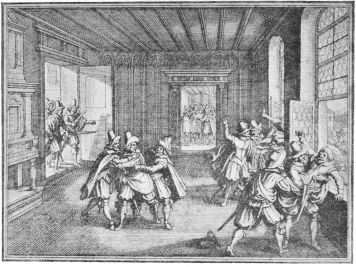
THE ROYAL OFFICIALS ARE THROWN FROM THE WINDOWS ON MAY
23, 1618
{112}
{113}
both thrown, dressed in their cloaks and with their rapiers and
decorations, just as they had been found in the councillors’ office, one
after the other, head foremost out of the western window into a moat
beneath the palace, which by a wall was separated from the other deeper
moat. They loudly screamed, “Ach, ach, Ouvé!” and attempted to hold on
to the window-frame, but were at last obliged to let go, as they were
struck on their hands.’ It remains to add that neither of the nobles nor
Fabricius, their secretary, who was also thrown from the window,
perished; a circumstance that the Catholics afterwards attributed to a
miracle.
Immediately after the defenestration the Estates elected thirty
‘directors’—chosen in equal number from the three Estates—who were to
constitute a provisional Government. Ruppa, one of the most gifted of
the Bohemian nobles, became head of this Government, while Thurn assumed
command of the army which the Estates hurriedly raised. On March 20,
1619, Matthias died, and though the Estates had recognised Ferdinand as
his successor, the throne became practically vacant; for it was very
unlikely that the Protestants who had risen in arms against Matthias
would now accept a far more intransigent Romanist as their ruler.
On July 8 a general Diet, that is to say one consisting of deputies of
Moravia and Silesia as well as Bohemia, met at Prague. On August 3 this
assembly pronounced the deposition of Ferdinand as King of the Bohemian
lands, and on the 26th the crown was offered to Frederick, Count
Palatine. There were other candidates, but an eloquent speech of Ruppa
decided in Frederick’s favour. He assured the Bohemians that they would
obtain powerful allies if they elected Frederick, and specially referred
to{114}
Inscription on Picture.
The Bohemian leaders—Anhalt the Elder, Hohenlohe, Thurn the Elder and
the Younger, Anhalt the Younger, John of Bubna, Henry Slik (of the
Moravian allies), Stubenvoll (of the German allies), the Duke of Weimar.
The Imperialist leaders—Maximilian of Bavaria, Buguoy, Tieffenbach (of
the German league), Tilly, Pappenheim, Des Fours, Caralli and others.

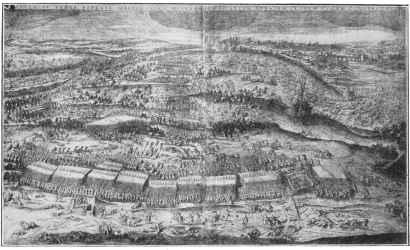 BATTLE OF THE WHITE MOUNTAIN, NOVEMBER 8, 1620
BATTLE OF THE WHITE MOUNTAIN, NOVEMBER 8, 1620
{115}
{116}
{117}
James I. of England, the father-in-law of their new Sovereign.
After some hesitation, Frederick accepted the crown and proceeded to
Bohemia accompanied by his consort. They arrived at the ‘Star’ Palace,
immediately outside Prague, early in the morning of October 31, and on
the same day made their solemn entry into the town. Many Bohemian nobles
who had awaited their new Sovereign at the ‘Star’ joined the procession
to the Hradcany Castle. At the Strahov gate they were met by the guilds
of Prague carrying their banners, and by numerous peasants ‘all clad in
the old Bohemian dress and bearing arms that had been used during the
Hussite Wars.’ On November 4 Frederick was crowned King of Bohemia in
St. Vitus’s Cathedral, and the coronation of Queen Elizabeth took place
there three days later.
The winning manners of Frederick at first obtained for him considerable
popularity, and when Queen Elizabeth gave birth to a son—Prince
Rupert—on December 26 the citizens of Prague greatly rejoiced.
Difficulties, however, soon arose. The King was ignorant of the national
language, and seems to have made no attempt to acquire it. When
Frederick’s Calvinist divines persuaded him to have the altars and
paintings removed from St. Vitus’s Cathedral, Lutherans, Utraquists and
Romanists were equally indignant.
Queen Elizabeth never secured even that limited amount of popularity
that her consort obtained. She was accompanied principally by English
ladies, and was believed to have spoken to them in an unfavourable
manner of her new country. She had hardly any intercourse with the
Bohemian ladies, few of whom knew French, and none English. They
strongly disapproved of their new Queen, who, they said, ‘had no settled
hours either for her meals or for her prayers,’{118} and even of the low
dresses which she and her English ladies wore.
Frederick remained at Prague up to September 28, 1620, and then only
joined his army in Southern Bohemia that was opposing the advance of the
Austrians. He found his soldiers already entirely disorganised, and was
forced to retreat on Prague. His forces reached the White Mountain,
immediately outside the town, on the evening of November 7. The enemies,
who were in close pursuit, attacked the Bohemians on the following day.
Frederick had meanwhile returned to Prague to join his consort. Neither
this proof of conjugal affection, nor the fact that an immediate attack
of the Catholic forces may not have appeared probable, can in any way
excuse what was practically desertion.
It is certain that the Catholic commanders were not at first unanimous
as to the policy of attacking the Bohemians at a moment when the
Catholic army was exhausted by prolonged marches. Buguoy I., who
commanded the Austrian forces, advised delay, but the opinion of the
Duke of Bavaria and Tilly, who insisted on an immediate attack,
prevailed. The numerous Jesuits and other friars who accompanied the
army also declared that no delay should be granted to the heretics. It
was also taken into consideration that Christian of Anhalt,
Commander-in-Chief of the Protestant forces, was hastily throwing up
earthworks on the plateau of the White Mountain, and endeavouring to
re-establish discipline among his troops, which had been demoralised by
their continuous retreat. A deferred attack might therefore be more
hazardous than an immediate one.
Even before the council of war had decided on an immediate attack, a
small Bavarian force—not yet{119} supported by the mass of the Catholic
army—attacked the right flank of the Bohemians. The younger Count Slik,
who commanded some of the Moravian troops, hurriedly rode up to
Christian of Anhalt, begging his permission to attack the Bavarians on
their march. ‘It was a weighty and fateful moment in the history of the
Bohemian people.’[37] Anhalt at first favoured the suggestion, but on
the advice of Hohenlohe, who was second in command, he finally refused
his consent. The whole Catholic army soon united, and advanced on the
whole line. Though the younger Count Thurn’s infantry successfully beat
back an attack of the Austrian infantry, and the son of Christian of
Anhalt made a successful cavalry charge, the Catholics were soon
victorious, and the earthworks were, after a short defence, carried by
the troops of Austria, Bavaria and Spain. Of the Protestant forces the
Hungarian horsemen, whom Gabriel Bethlen, Prince of Transsylvania, had
sent to Bohemia, first took to flight. They attempted to cross the
Vltava by a ford near the present suburb of Smichov, and many perished
in the river. Flight soon became general, and the conduct of the
Bohemians and their allies was most unworthy of the ancient glory of the
country. There were some exceptions to the well-nigh general cowardice.
A small Moravian force under Count Slik retreated to the wall of the
‘Star’ Park, where they defended themselves with desperate courage.[38]
When almost all had been killed, those who remained surrendered. The
battle, and with it the fate of Bohemia, was then decided. As proof of
the heroism of the Moravians, contemporary writers tell us that along
the ‘Star’ walls[39] the dead at some places lay ten or twelve high.{120}
Inscription above Central Picture.
‘True representation of the executions at Prague. How by the most
gracious order and command of his Roman Imperial Majesty the former
Bohemian Directors, Counts, Lords, Knights and men of the Estate of the
citizens were, on Saturday, the 9th of June of this year 1621, condemned
in the royal castle of the Hradcany, and then, on Monday, June 21,
punished and executed on the market-place of the old town.’
Inscription under Central Picture.
‘This design shows clearly how the 24 men were decapitated one after the
other, and how three others were then hanged.’
Inscription under Upper Engraving Right Side.
‘Here you see the twelve heads exposed on the bridge tower of Prague.’
Inscription under Lower Engraving Right Side.
‘How three men are whipped with rods, while the tongue of one is nailed to the
gallows.’

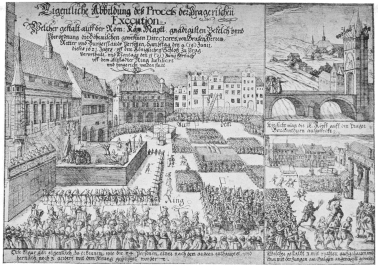 THE EXECUTIONS ON THE MARKET-PLACE OF THE OLD TOWN OF
PRAGUE ON THE 21ST OF JUNE 1621
THE EXECUTIONS ON THE MARKET-PLACE OF THE OLD TOWN OF
PRAGUE ON THE 21ST OF JUNE 1621
{121}
{122}
{123}
The news that the battle had begun reached Frederick in the banqueting
hall of the Hradcany Castle, where he was entertaining the English
ambassadors, whom his father-in-law James I. had sent to Prague. He
mounted his horse and rode to the Strahov gate, only arriving there in
time to witness the rout and flight of his army. The sight of the
battlefield and even, as an eye-witness tells us, the terrible wailing
of the women,[40] greatly impressed Frederick, and he hurriedly returned
to the Hradcany. From here he proceeded with Queen Elizabeth to the old
town, and the defeated army also crossed to the right bank of the river.
A council of war was held late in the evening, at which most of
Frederick’s generals spoke in favour of instant retreat. The King
himself made some pretence of resolution. But when, on the following
morning, Elizabeth left Prague, the King—a modern Antony, without
Antony’s bravery—‘hastily mounted his horse, thus giving the signal for
a general flight.’
The battle of the White Mountain is one of the greatest landmarks in the
history of Bohemia, and of Prague in particular. I will not here refer
to the complete change in the condition of Bohemia which it caused, the
complete suppression of Protestantism, the complete annihilation of the
ancient constitution of the land, the almost complete, though but
temporary, extinction of the national language.
But before ending my account of Prague as the capital of an independent
country, I must briefly refer to the executions on June 21, 1621.
Immediately after the suppression of the national movement it appeared
probable{124} that the Austrian policy would be a lenient one. But sterner
councils soon prevailed at Vienna. In February Slik, Budova, Divis
Cernin, Kaplir, as well as Jessenius, the rector of the University, and
some of the leading townsmen, were arrested. There was no pretence of
conducting the trial according to the ancient legal institutions of the
country, which granted great privileges to nobles. A special tribunal
was constituted, and its members were instructed to judge with the
greatest severity.
The judges arrived from Vienna on March 13, 1621, and the court sat for
the first time at the Hradcany Castle on the 15th of that month. The
judges did not fail to act according to their instructions. Their
decision, which Ferdinand confirmed on May 23, the anniversary of the
defenestration, pronounced the confiscation of the estates of all the
accused. There were twenty-seven death sentences; of the condemned men
twenty-four were to be decapitated, three hanged. In some cases torture
was added to the death penalty. Thus Divis Cernin, captain of the
Hradcany Castle, who had opened the gates of that castle to the
Protestants, Count Slik, Bohuslav Michalovic and others were to have a
hand cut off before execution, while the tongue of Jessenius, rector of
the Prague University, whom the Bohemians had employed in their
negotiations with Transsylvania, and whose eloquence the Imperialists
dreaded, was to be cut out. Not many of these additional punishments
were, however, actually carried out.
Besides these death sentences many Bohemians were condemned to prison
for lengthy periods, while others were expelled from Prague, and it was
ordered that they should be whipped with rods till they reached the city
gates.{125}

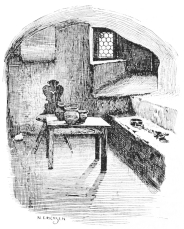
THE DUNGEON IN THE TOWN HALL
On June 19 the prisoners were informed of their fate, and on the
following day their wives and children, as well as three Lutheran
clergymen, were admitted to visit them. It is on the narrative of these
clergymen that the great historian Skála has based his account of the
last movements of the prisoners and their execution.[41] The day fixed
for the executions was June 21, and on the previous day all prisoners
who were not already confined in the dungeons of the{126} town hall of Staré
Mesto were conveyed there, as the executions were to take place in the
immediately adjacent market-place. They met their fate with great
fortitude, and spent their time mainly in singing hymns. They conversed
freely with the Lutheran clergymen. Budova said, ‘I am weary of my days.
May God deign to receive my soul, that I may not behold the disaster
that, as I know, has overcome my country.’ Count Slik said, ‘I am before
the tribunal of the world, and expect immediate death. But those who
have judged me will have to appear before the awful tribunal of Him who
will judge more justly.’
Early on the morning of June 21 a cannon-shot was fired as a signal that
the executioners were to begin. One by one the prisoners were conducted
to the market-place, ‘that mournful stage and slaughter-house of
Antichrist,’ as Skála calls it. Each man when proceeding to his death
took leave of his comrades in a pleasant manner, as if he were going to
a banquet or some pastime. ‘I go before you,’ he said, ‘that I may first
see the glory of God, the glory of our beloved Redeemer; but I await you
directly after me; in this hour grief already vanishes, and a new
heartfelt and eternal happiness begins.’ Full preparations had been made
by the Imperial authorities to prevent disturbances. The whole
market-place was lined with troops, and orders had been given that the
drums should beat during the whole time that the executions lasted. A
tribune had been erected, from which the Austrian authorities watched
the executions. Slik was first led forth, and after him twenty-three
others were decapitated. The tongue of Jessenius was cut out before his
execution, and a hand of Michalovic was cut off. Three citizens of
Prague then suffered death on the gallows. To{127} further accentuate the
reign of terror that had begun, the heads of twelve of the nobles who
had been decapitated were exposed on the towers of the bridge of Prague,
six on the bridge tower of the Malá Strana, six on that of the old town.

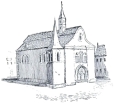
BETHLEHEM CHAPEL
{128}
CHAPTER III
Prague in Modern Times
AFTER the battle of the White Mountain, the interest of the story of
Prague declines for a time. A period of strenuous reaction in Church and
State, during which the Government endeavours to efface the memorials of
past national glory, cannot be picturesque. As it was necessary to
replace by new architectural monuments the ancient buildings that
recalled events that it was now thought desirable to forget, Prague was
in the seventeenth and eighteenth century covered with buildings in the
rococo and ‘Jesuite’ styles, which often unfavourably impress the
passing traveller who is unable to discern that they are by no means
connected with the period of Bohemia’s greatness.
During the Thirty Years’ War Prague several times again plays a
considerable part. After Gustavus Adolphus’s great victory at
Breitenfeld in 1831, his Saxon allies occupied Prague in November of
that year. They were accompanied by many Bohemian exiles, who caused the
heads of the twelve patriots that were still exposed on the bridge
towers to be removed and buried with great solemnity in the Tyn Church.
Preparations were even made to re-establish Protestantism, but in May of
the following year Wallenstein’s army stormed the Malá Strana and the
Hradcany Castle, and the Saxons shortly afterwards entirely evacuated
Bohemia, though not before amassing{129}

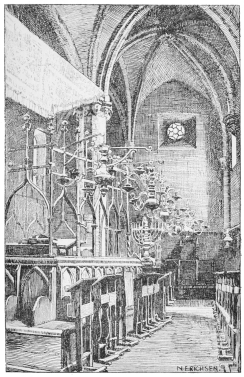
THE OLD SYNAGOGUE
{130}
{131}
a large amount of plunder. Many of the treasures of Rudolph’s
collections in the Hradcany Castle thus found their way to Dresden.
In 1648 Prague was the scene of the last struggles of the war that had
begun there thirty years before. A Swedish force, under General
Königsmark, entered Bohemia in that year and advanced rapidly on Prague.
Negotiations for peace had begun in the previous year, and it has been
often wondered why this last Swedish incursion took place. Bohemian
writers have surmised that the desire for plunder, and particularly the
attraction of Rudolph’s far-famed collections, were partly the motive.
The Swedes obtained possession of the part of Prague that lies on the
left bank of the river through the treachery of Otowalsky, an Imperial
officer who had been dismissed from the service. He informed the Swedes
that the walls of the Malá Strana were under repair, and that there was
therefore a temporary gap in them. In the night of July 26 the Swedish
troops entered the town by this gap, opened the Strahov gate and seized
the Malá Strana and the Hradcany. The Swedes were, however, unable to
obtain possession of the part of the town on the right bank of the
Vltava, even after a second Swedish army had joined them in October. The
citizens, now mostly Catholics, headed by Jesuit monks, bravely defended
the bridge of Prague, and the Jewish colony, always a considerable one
at Prague, also bravely took part in the defence.
On November 3, the news of the conclusion of the Treaty of Westphalia
reached Prague and put a stop to hostilities.
There is little to note of Prague in the following years; it was not the
scene of warlike events, and the former municipal struggles ceased under
a severely absolutist Government.
Prague is now an Austrian provincial town, though{132} Bohemia has always
officially been described as a kingdom, not as a province.
It was only during the Austrian War of Succession (1741-1748) that the
annals of Prague again became of some interest. The male line of the
house of Habsburg became extinct after the death of Charles VI., and a
European coalition was formed for the purpose of excluding his daughter
Maria Theresa from the throne. The Elector of Bavaria, who claimed the
Bohemian crown, entered the country with an army of Frenchmen and
Bavarians, while a Saxon army also invaded Bohemia. These armies met
before Prague, and carried the town by assault on November 26, 1741. The
Elector of Bavaria immediately assumed the title of King of Bohemia, and
was crowned in St. Vitus’s Cathedral by the Archbishop of Prague.
More than 400 knights and nobles did homage to the new King, and a
German writer has noted, somewhat maliciously, that among them were
representatives of many of the old Bohemian families, such as Cernin,
Kolowrat, Kinsky, Lützow, Lazansky, Waldstein and many others.
The Elector left Bohemia immediately after his coronation, but a French
army under Marshal Belleisle remained at Prague. The town was now
besieged by the Austrian forces, and the French, after a brave defence,
succeeded in evacuating the town and retreating safely to Eger, where
they joined another French army that had been sent to their relief.
Prague was now occupied by the troops of Maria Theresa, who was crowned
there in 1743.
An event of great importance in the municipal annals of Prague took
place during the reign of Maria Theresa. The communities of the old
town, the new town and the ‘small quarter’ were united into one
municipal{133} corporation. This change had not, of course, the importance
which it would have had in earlier and freer days; for the burgomaster
was then a Government official, appointed by the authorities of Vienna.
It is only since 1848 that the citizens of Prague have recovered the
right of electing the head of their community.
The first years of the reign of Maria Theresa were very stormy ones for
Prague.

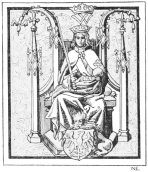 SECRET SEAL OF THE MALÁ STRANA
SECRET SEAL OF THE MALÁ STRANA
In 1744 Frederick the Great entered Bohemia, and stormed Prague on
September 12, after a terrible bombardment, during which 150 houses in
the new town and a large part of the city walls were destroyed.
Frederick did not remain long at Prague; the arrival of a large Austrian
army under Charles of Lorraine obliged him to retire into Silesia.
Prague was not destined long to enjoy the blessings of peace. In 1757,
the second year of the Seven Years’ War, Frederick the Great arrived
before Prague with a large army on May 2 and encamped on the White
Mountain. He crossed the Vltava on the 5th to unite his army with the
Prussian forces on the right bank of the river, and on the{134} following
day a great battle took place between the Prussians and Austrians
between the village of Sterbohol, four and a half miles from Prague, and
the city itself. Carlyle has given us a very spirited, though somewhat
inaccurate, description of this great battle, which he calls ‘the famed
Battle of Prag; which sounded through all the world—and used to deafen
us in drawing-rooms within man’s memory.’ The battle ended with a
complete defeat of the Imperialists, and the Austrian army had—as
Carlyle words it—‘to roll pell-mell into Prague and hastily close the
door behind it.’ The town was again so fiercely bombarded that whole
streets were in ruins, and St. Vitus’s Cathedral and other historical
buildings greatly suffered. The Austrian victory at Kolin obliged the
Prussians to raise the siege of Prague.
The battle of 1757 is the last warlike event with which Prague is
connected, if we except the civil tumult in 1848. The town played no
part in the later events of the Seven Years’ War, nor in the long
struggle between Austria and France that, with short intervals, lasted
from 1792 to 1815.
In the peaceful years that followed the Congress of Vienna (1815) the
Bohemian nation strove—as far as the jealousy of a strictly absolutist
Government permitted—to recover some of its ancient rights and
privileges, and particularly to revive the national language. Prague was
the centre of this movement, particularly after the foundation of the
Bohemian Museum.
A visitor to Prague who enters at all into communications with the
inhabitants will hear so much of this movement that I do not think I
should here pass it over altogether in silence. The Bohemian language
that, during the period of independence, had gradually{135} taken the place
of Latin as the recognised language of the state, declined after the
battle of the White Mountain. During the reign of Maria Theresa, and to
a far greater extent during that of the Emperor Joseph II., the Austrian
authorities used even more energy in their endeavours to substitute
German in Bohemia for the native language than had been done immediately
after the great defeat. Among other measures tending to this purpose, it
was decreed that German should exclusively be used in the Bohemian
schools. The stern determination—enemies, no doubt, would call it
obstinacy—of the Bohemian nation defeated these attempts, though the
native language was for a time almost relegated to the villages and
outlying districts of Bohemia. The renascence of the national language
in Bohemia, in the early years of the nineteenth century, is almost
unique. It was, however, based on a great historic past, and thus
differs greatly from the recent attempts to revive the Irish and Welsh
languages, though the comparison has often been made. It is not my
purpose to analyse here the tangled and involved causes which resulted
in the great fact that a buried nationality burst its grave-clothes and
reappeared radiant in the world. It may, however, be briefly noted that
the Bohemian national movement was undoubtedly an offspring of the
Romantic movement, the influence of which was felt all over Europe at
the beginning of the last century. The revival of the Bohemian language
is due to a small group of learned men, of whom Jungmann, Kolar, Safarik
and Palacky were the most prominent. These men, few in number, showed
that enthusiasm touching, though it may appear absurd to some, which
champions of apparently hopeless causes often display. Many anecdotes to
this purpose are still circulated in Prague. Thus it was said that a few
of the ‘patriots,’ as the adherents of{136} the national cause were called,
feasted almost to excess as a token of joy when they noticed on the
Graben ‘two well-dressed men who were talking Bohemian.’ On the other
hand, they were deeply depressed when two young girls of the citizen
class, who had been talking Bohemian, suddenly dropped into German on
their approach, saying, ‘Take care they hear us talking Bohemian; they
will take us for peasants.’
As was natural in the case of so musical a nation as Bohemia, the
patriotic movement found expression in music also. Early in the
nineteenth century ‘Slavic balls’ were instituted at Prague. At these
balls the hall was entirely decorated in the Bohemian national colours
(red and white), and conversation in Bohemian was alone allowed. It was
the intention of the originators of these gatherings to send out the
invitations in the Bohemian language, but the Austrian police officials,
with the inquisitiveness characteristic of the Metternich period soon
became acquainted with this intention, and raised objections. It was
finally decided that the invitations should be both in German and in
Bohemian. The old national songs were again sung as far as the police
authorities permitted. New songs, celebrating the glory of Bohemia, also
were composed. Such were the one beginning with the words ‘Já jsem Cech
a kdo je vic?’ i.e., ‘I am a Bohemian, and who is more?’ that was
composed by Rubes. Yet better known is the famed ‘Kde je domov muy?’
(Where is my country?) which the traveller will constantly hear at
Prague, as the present Government, wiser than its predecessor, raises no
objection to its being sung. The song has indeed become the national air
of Bohemia. It was composed by Joseph Tyl (1808-1856), one of the best
modern Bohemian dramatists, and by him introduced{137} into one of his
plays. When Mr. Kohl visited Prague in 1841 the song, which he curiously
enough believed to be of ancient origin, was already sung everywhere in
the city. He translated some lines of the song, and though his
translation by no means does justice to the beauty of the original, I
will transcribe it here, as giving the traveller some idea of the
contents of a song to which he will hear constant allusions—
‘Where is my house? where is my home?
Streams among the meadows creeping,
Brooks from rock to rock are leaping,
Everywhere bloom spring and flowers
Within this paradise of ours;
There, ’tis there, the beauteous land!
Bohemia, my fatherland!
Where is my house? where is my home?
Knowst thou the country loved of God,
Where noble souls in well-shaped forms reside,
Where the free glance crushes the foeman’s pride?
There wilt thou find of Cechs, the honoured race,
Among the Cechs be aye my dwelling-place.’
The patriots themselves do not at first appear to have felt certain of
the victory of the cause. Thus we are told that when Jungmann received
the visit of two other patriots in his modest lodgings in the street
which now bears his name, he said, in a fit of depression, ‘It needs
only that the ceiling of this room should fall in, and there would be an
end of Bohemian literature.’ He was, of course, alluding to the small
number of the ‘patriots.’
In 1848 disturbances broke out at Prague. A Slavic Congress, comprising
representatives of all branches of that race, met there under the
presidency of Palacky, the great Bohemian statesman and historian, whose
name has already been mentioned. Its deliberations were soon interrupted
by the turbulence{138} of the extreme nationalists. Stormy public meetings
were held, and on June 12 Mass was read on the Václavské Námesti in the
presence of a large crowd. Students returning from the service in the
Celetná Ulice came into conflict with the soldiers, who fired on the
people. Immediately numerous barricades were thrown up, and
street-fighting continued up to the 17th, when the city surrendered
unconditionally to Prince Windischgrätz, the Austrian commander.
Absolutist and military government now again prevailed at Prague.
Since the year 1860 attempts were again made to establish representative
institutions in Austria. The Bohemian diet again assembled, though no
longer in the Hradcany Castle, but in a palace at the foot of that hill
near the Malostranské Námesti.
In 1866, during the Austro-Prussian war, Prague was occupied by the
Prussians without resistance on July 8. They remained there for some
time, and here too (at the ‘Blue Star’ Hotel) the treaty that concluded
the war was signed on August 23.
In the year 1871 it seemed probable that the Bohemians would obtain the
restitution of their ancient constitution, of course modified to suit
modern ideas, and Prague began to prepare for the coronation of the
Sovereign. Unfortunately the negotiations between Count Hohenwart, then
head of the Austrian Government, and the Bohemian leader, Prince George
Lobkovic—whose great talents are far too little known beyond the
Bohemian borders—failed at the last moment. Count Hohenwart’s cabinet
was succeeded by ministers whose tendencies were German, and it is only
since 1879 that concessions have been made to the Bohemians.
Since that time the Bohemian cause has made vast progress. The
foundation of the Bohemian University,{139} and of a Bohemian academy, which
was richly endowed by the patriotic architect Hlarka, have greatly
contributed to restore to Prague its former Bohemian character.

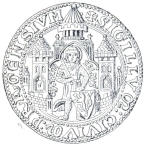
THE OLDEST GREAT SEAL OF THE OLD TOWN
{140}
CHAPTER IV
Palaces
PRAGUE, the winter residence of the wealthy and powerful Bohemian
nobility, is a city of palaces, but it will here be sufficient to
mention those only that have considerable historical or artistic
interest.
As has already been mentioned, many of the palaces of Prague were built
in the last years of the Thirty Years’ War, or in the immediately
subsequent period. Such are the Nostic Palace in the Graben or Prikapy,
the great Waldstein Palace, the palace of Count Clam-Gallas, which will
be mentioned presently, the Cernin Palace on the Hradcany, now converted
into barracks, and many others.
Of the palaces that are situated on the right bank of the Vltava, the
most interesting is the Kinsky Palace, which was built in the eighteenth
century according to the plans of the architect Luragho. It contains an
extensive library, particularly rich in works concerning the French
revolutionary period—of these there are 17,470—a valuable collection
of engravings, and the archives of the family of the Princes Kinsky. The
celebrated Bohemian poet, Celakovsky, for some time held the post of
librarian here.
The only other palace on the right bank of the Vltava which I shall
mention is that of the Count Clam-Gallas, a handsome building that also
dates from the eighteenth century. It originally belonged to Count
Gallas, a descendant of one of Wallenstein’s generals. By one of
history’s little ironies the palace{141} was, in 1866, for a time the
residence of the Prussian prince Charles, while the Count Clam-Gallas,
to whom the palace then belonged, was one of the Austrian leaders in the
disastrous campaign of that year.

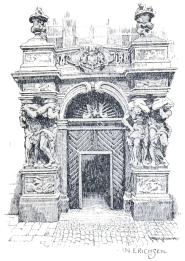
GATE OF THE CLAM-GALLAS PALACE
Far more numerous are the palaces on the left bank of the Vltava in the
Malá Strana and Hradcany districts, which constitutes what may be called
the Faubourg St. Germain of Prague. In some of the short and narrow
streets in this part of the town there were{142}—as in mediæval
Italy—sometimes several palaces of one family from which the street
took its name. We still meet with names such as the Thun Street and the
Waldstein Street.
But of all these palaces the one that deserves fullest notice is the
Royal castle on the Hradcany. According to the chronicler Cosmos, there
was, in the eleventh century, already a castle (in Bohemian, ‘hrad’) on
the spot where the present palace stands. This earliest building was
soon destroyed, and that which succeeded it was burnt down in 1303.
When Charles IV. first arrived at Prague he found the Royal castle, as
he himself noted, ‘deserted, ruined, almost levelled to the ground.’ He
was indeed at first obliged to accept the hospitality of a citizen of
the old town. Charles, who delighted in building, and particularly in
adorning his favourite city, Prague, immediately decided to rebuild the
castle. He is said to have resolved to imitate the Louvres Palace, as he
had seen it in Paris. In consequence of the many civil wars, hardly any
traces of Charles’s castle, of which the old writers have given a most
striking description, can now be found. Charles strongly fortified his
castle in the direction of the Malá Strana. The steep access to the
Hradcany in that direction is a remnant of these fortifications. During
the Hussite Wars the castle was used as a fortress, and it suffered
greatly during those wars. The castle was greatly injured during the two
sieges (1420 and 1421), when Sigismund’s troops were here besieged by
the Praguers, but its fate was far worse after Sigismund’s troops had
been forced to capitulate. The citizens rushed into the castle resolved
to entirely demolish the stronghold of the hated King Sigismund. The
town magistrates and the nobles, allied with the Praguers, succeeded
indeed in averting the complete destruction of the{143} time-honoured
castle, but it was greatly damaged. After the end of the Hussite War,
Sigismund, during his short reign, undertook some repairs, but the
castle remained uninhabited.
The Bohemian Kings, since the time of Wenceslas, resided in the old town
on the right bank of the Vltava. This continued up to the reign of
Vladislav II. That King, who resided in the buildings known as the
Kraluv Dvur, near the powder tower, intimidated by the menaces of his
turbulent neighbours, the citizens of the old town, resolved to transfer
his residence to the left bank of the Vltava. He crossed the river in a
boat at night-time, and sought refuge behind the strong walls of the
dilapidated Hradcany, and began to build there a new Royal residence.
Some of the oldest parts of the existent building date from his time.
Large additions were made by Ferdinand I., Matthias and Rudolph.
Rudolph, like Charles IV., chose Prague as his permanent residence, and
he is the last King of Bohemia who lived continuously in his capital.
His artistic and scientific tastes, to which reference has already been
made, caused him to feel a great desire for solitude. He generally lived
in the north wing of the castle, where he established an observatory and
vast laboratories for chemical research. On the other hand, he appears
to have neglected the portion of the castle that had been built by
Vladislav II. He even allowed the far-famed hall of Vladislav to be
turned into a ‘bazaar where various tradesmen exhibited their wares and
met to discuss their business.’ Sadeler’s engraving—reproduced in this
volume—gives a good idea of the appearance of Vladislav’s hall at this
period.
Rudolph accumulated in the Hradcany Castle vast collections, which have
long since been dispersed. Though they were plundered by the Saxons in
1632,{144} and again by the Swedes in 1648, many works of art seem still to
have remained, for a sale was held as late as in 1782, when Joseph II.
intended to turn the Hradcany Castle into barracks.
Since Rudolph’s time the rulers of Bohemia have but rarely inhabited the
Hradcany for any considerable time, though Maria Theresa caused it to be
largely rebuilt after the buildings had suffered very much from the
Prussian bombardment. Her son Joseph II., as already mentioned, proposed
turning the vast agglomeration of buildings on the Hradcany hill into
barracks, but the plan was never carried out. From his abdication in
1848 to the year of his death, the Emperor Ferdinand inhabited the
Hradcany Palace, and the gifted Crown Prince Rudolph resided here for
some time. More recently the reigning Emperor has, in 1891 and 1901,
received the nobility of Bohemia in the Hradcany Castle.
The vast and imposing Hradcany Palace has the greatest historical
interest, and well deserves the attention of the visitor. We enter the
first of the three courtyards from the Hradcany Square, famous as the
site of the executions that preceded the meeting of the ‘bloody diet.’
The first courtyard is divided by a railing from the square, and is
entered by a gateway embellished by four colossal mythological statues
by Platzer. The buildings surrounding this first court are modernised
dwelling-rooms, sometimes inhabited by members of the Imperial family.
Passing through a portal, built by King Matthias in 1614, we enter the
second court. It is considerably larger than the first one. Immediately
opposite the portal is the Chapel of the Holy Cross, which dates from
the seventeenth century, but has been frequently altered. It was
thoroughly restored and modernised (1852-1858) during the time that the
late Emperor Ferdinand resided in the castle. In the north wing of this
court{145}

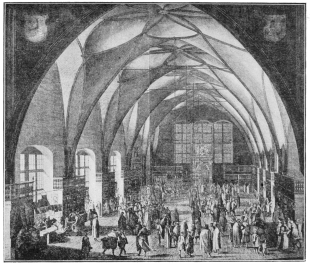
THE HALL OF VLADISLAV IN THE HRADCANY CASTLE
{146}
{147}
are the so-called German and Spanish halls. They were built during the
reign of the Emperor Ferdinand I. The former for a time contained the
famed collections of Rudolph; the latter has, since the time of the
Empress Maria Theresa, occasionally been used for court functions. Balls
were given here during the stay of the Crown Prince Rudolph, and the
reigning Emperor has several times here received the representatives of
Bohemia.
We now enter the third court, where we see, to our left, St. Vitus’s
Cathedral, while to the right is the most interesting part of the
palace—that which dates from the time of King Vladislav. It was built
between 1484 and 1502 by the celebrated architect Benes, of Loun, in
what is known in Bohemia as the Vladislav style, a transition between
Gothic and the style of the Renaissance. Benes was, with Matthew Reysek,
the originator of this style of architecture, to which many of the most
interesting buildings in Prague belong. Here is the ‘hall of Vladislav,’
where the Bohemian nobles did homage to their Sovereign after his
coronation, and where the coronation banquet was held. When finished—in
1502—the hall of Vladislav excited general admiration. A contemporary
chronicler writes that ‘there was no building like it in all Europe,
none that was longer, higher and broader, and yet had no pillars.’
Historically very interesting is the chamber where the Bohemian Estates
met up to 1848. It clearly indicates their relative position. While the
nobles and the clergy (who only after the Battle of the White Mountain
became one of the Estates) occupied benches to the left and right of the
throne, the few town representatives were placed on an isolated platform
surrounded by a wooden railing. In this part of the Hradcany, also, is
the old council chamber, the scene of the famous defenestration of
1618.{148}
Of the other palaces in this part of Prague, the Waldstein Palace—in
the square of that name—first deserves notice. The building dates from
the time of the great Wallenstein, who began its construction shortly
after the Battle of the White Mountain. To make room for the foundations
of the vast edifice 23[42] houses were demolished. The building was
finished in 1630, and, after the death of the Duke of Friedland, it was
given by the Emperor to his chamberlain, Maximilian of Waldstein. It has
ever since continued in the possession of that branch of the Waldstein
family. It has a very fine Renaissance hall, a chapel with paintings
attributed to divers Italian painters, and extensive gardens that are
the finest at Prague.
In the Thun Street is the palace of Count Oswald Thun, which contains
some good pictures and some very fine porcelain. In the steep Ostruhova
Ulice are the palaces of Count Francis Thun, the Morzin Palace, which
has a very fine façade, and many others. On the Hradcany Place, opposite
the Royal residence, is the vast Schwarzenberg—formerly
Rosenberg—Palace. The Fürstenberg and Lobkovic Palaces also deserve
mention.


THE MOST ANCIENT SHIELD
OF THE OLD TOWN
{149}
CHAPTER V
Churches and Monasteries
THE churches of Prague are, and always have been, very numerous. We read
that at the funeral of King Ottokar, in 1278, the bells of nearly a
hundred churches pealed. The oldest ecclesiastical buildings in Prague
were small round chapels of a Romanesque character, three of which are
still in existence, though they were formerly far more numerous. Many
churches were destroyed during the Hussite Wars, and many were restored,
in deplorably bad taste, during the Catholic re-action that followed the
Battle of the White Mountain. I shall in this chapter refer only to the
most important churches and monasteries, though I may allude to a few
others when writing of walks in and near Prague.
The Cathedral Church of St. Vitus, near the Royal castle of the
Hradcany, deserves first mention. It has already been noted that the
gift of a relic of St. Vitus induced Prince Wenceslas to erect a church
in honour of that saint. This small church, built in the Romanesque
style,[43] was not finished when Wenceslas was cruelly murdered by his
treacherous younger brother Boleslav. When Wenceslas’s body was
transported here the church became known as the Church of St. Vitus and
St. Wenceslas, and after the second{150} Bishop of Prague, the martyred
Adalbert, had been also buried here, it was for a time known as ‘the
Church of St. Vitus, St. Wenceslas and St. Adalbert.’[44]

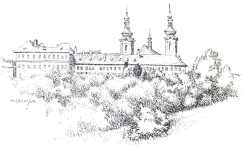
VIEW OF STRAHOV
This first church, which was probably of very modest dimensions, soon
became too small for the pious visitors who wished to venerate there the
relics of Wenceslas and the martyred Bishop of Prague. The church which,
to use the words of Monsignore Lehner, had become ‘the metropolitan
church of the whole Bohemian empire’—then extending further than at
almost any other period—remained insufficient even when a smaller
church or chapel adjoining it had been erected. Prince Spytihnev II.,
therefore, resolved to build a larger church on the Hradcany Hill, and,
space being very restricted, he demolished the old building of Wenceslas
to make room for the new church, which, like the previous one, was in
the{151} Romanesque style. The new church was destroyed during the frequent
civic tumults of Prague. Shortly after the foundation of the
Archbishopric of Prague and during the reign of King John, it was
decided to build a new cathedral on the Hradcany Hill. Charles, through
whose influence the impecunious King John had given his consent to the
building, took the greatest interest in it, both during the lifetime of
his father and after he had succeeded him as King. As architect he chose
Matthew of Arras, whom he had met during one of his visits to Avignon.
After some years, the building was continued by Peter Parler and his son
John. The records of the cathedral tell us that in 1418 Master Peter,
generally known as Petrlik, was architect. The great buildings erected
in the Gothic style, which by this time was generally adopted in
Bohemia, progressed very slowly. The Hussite troubles caused a complete
interruption of the work. During the reign of Vladislav II. attempts
were made to continue the building, and it is probably rightly
conjectured that the King entrusted this task also to his favourite
architect, Benes of Loun. The Thirty Years’ War again stopped all
endeavours to finish the building of the cathedral, and in the following
century the bombardment by Frederick the Great greatly damaged the
cathedral.
Within recent years patriotic efforts have been made to finish at last
this building, of which every Bohemian, independently of his religious
views and his political opinions, is necessarily proud. A society was
formed for this purpose in 1859, and the restoration and rebuilding has,
it must be admitted, very slowly proceeded ever since that date. The
work was at first entrusted to the architect, Joseph Mocker, who had
very successfully restored the bridge towers and the powder-tower at
Prague. Since his death (in 1899) the work has{152} been entrusted to Mr.
Charles Hilbert. I shall now briefly refer to the cathedral as it now
is, and I may mention, as it is impossible to give here a full account
of the treasures which it contains, that an excellent guide book,
published in German as well as in the language of the country, can be
obtained in the church.
Entering the church, we first see at our left the famous Wenceslas
chapel, the most magnificent of all. We enter it through bronze gates,
on which is a brass ring, to which the saint is said to have clung when
murderously attacked by his brother. The walls of the chapel are inlaid
with Bohemian precious stones; above are curious frescoes of the time of
Charles IV. The chapel also contains a candelabrum with a statue of the
saint, said to be the work of Peter Fischer; a painting of the school of
Lucas Cranach, representing the murder of Wenceslas; and the armour and
helmet of the saint. From this chapel a secret passage leads to the room
where the Bohemian crown jewels are preserved. We next come to the
Martinic chapel, that of St. Simon and Juda, and then that of the
Waldstein family; opposite the last-named chapel is a wood-carving
representing the devastation of the church by Frederick of the
Palatinate, which has already been mentioned in these pages.
Between the Waldstein and the Vlasim chapels is the Royal oratory or
pew, which is connected by a covered passage with the Hradcany Castle.
The oratory was built during the reign of Vladislav II. by Benes of
Loun.
Opposite the Vlasim chapel—built by Ocko of Vlasim, Archbishop of
Prague, who died in 1380—is the shrine of St. John Nepomuk, which
greatly attracts the attention of the visitors to the cathedral, though
it has more barbaric splendour than artistic value. In{153}

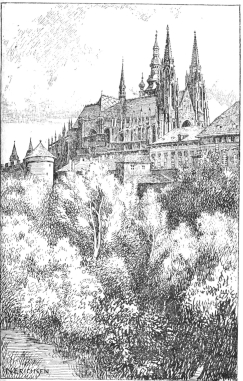
ST. VITUS FROM THE ‘STAG’S DITCH’
{154}
{155}
the nave of the church is the monument to the Bohemian kings, erected
under Rudolph’s reign by Colin of Malines.
Charles IV. and his four wives, Ladislas, Posthumus, George of Podebrad,
Ferdinand I., Maximilian, as well as Rudolph himself, are buried here.
Next to St. Vitus in importance is the Tyn Church in the market-place of
the old town. It has great historical interest as having been the
stronghold of the Hussite movement during its whole duration, as has
been already mentioned. Waldhauser and Milic, the precursors of Hus,
preached here, and here, also, Archbishop Rokycan delivered his fiery
sermons.
Of the many later preachers at this church, Gallus Cahera deserves
notice. A personal friend of Luther, he strove to transform the ancient
Utraquism of Bohemia into the Lutheranism that was then just beginning
to dawn on the world.
George of Podebrad proceeded to this church with the Bohemian nobles
immediately after they had elected him as their King, and was joyfully
received by Rokycan and the Utraquist clergy.
The Tyn Church was of very modest origin. It was originally a chapel
attached to the building known as the ‘Tyn,’ which German merchants who
traded with Bohemia erected to exhibit their wares.
The present building, begun in the fourteenth century, was finished in
the fifteenth, during the reign of King George. It has suffered less
from barbarous ‘restorers’ than most of the Prague churches. The fine
façade built by Podebrad remains, but the statue of that King, which
represented him as pointing upward with his sword to a chalice, of which
he was so valiant a defender, was removed by the Jesuits in 1623 as
being an ‘Utraquist emblem.’ They, at the same time, caused the two
great bells of the Tyn Church that{156} had been known as ‘Hus’ and
‘Hieronymus’ to be removed and recast; but when they had been refounded
and the Jesuits had again placed them in their former position, it was
found, to the great delight of those who still secretly sympathised with
the ancient faith, that the sound was unaltered.[45]
The interior of the church contains some paintings by Skreta, a
handsome—though renovated—pulpit from which Rokycan is said to have
preached, and the tomb of Tycho Brahe.
One of the finest churches in Prague is that of St. Nicholas, on the
Malostranské Námesti, built in the seventeenth century in the style of
the Italian Renaissance.
Of the many monasteries of Prague, I shall first mention the
premonstratension Monastery of Mount Sion or Strahov. It is situated at
the extremity of the Malá Strana, and the name of Strahov is derived
from the Bohemian word ‘straz,’ guard, as a guard was formerly
established here to secure the safety of travellers arriving at Prague
by the Strahov gate.
The monastery was founded in 1142 by Bishop Zdik of Olmütz, during the
reign of King Vladislav I. The first building was of very modest
dimensions, and both the monastery and the church that belongs to it
were rebuilt several times before the present structure was erected by
Italian architects at the end of the seventeenth century. Considerable
changes have also recently been made in the monastery. The church
belonging to the monastery contains the tomb of Pappenheim, the great
general of the Thirty Years’ War, and other monuments. A very handsome
railing divides the choir from the rest of the church.
In the small picture gallery is the much-repainted{157}

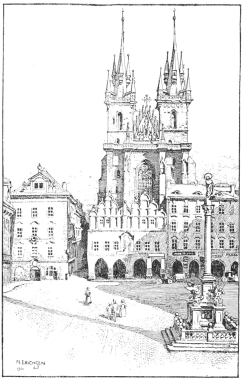
THE TYN CHURCH
{158}
{159}
Madonna by Albrecht Dürer, that once belonged to Rudolph, and a good
Tiepolo. But the most interesting part of the building is the library.
It occupies several halls, in one of which are the very handsome
bookshelves that were brought here from the suppressed Monastery of
Klosterbruck. In one hall we see over the doors small shelves with wire
grating, in which the books condemned by the Index, but which the monks
read by special permission, were formerly contained. The library is very
rich in Oriental MSS., incunables and early printed Bibles; among these
is the priceless Utraquist Bohemian Bible, printed at Venice, the first
edition of the celebrated Bible of Kralice, and a rare copy of the
Biblia Pollyglotta Briani Waltoni in Latin, Hebrew, Samaritan, Greek,
Chaldæan, Syrian, Arabic, Æthiopian and Persian. Though printed in
London in 1657, it is dedicated to King Charles II. The view from the
gardens of the Strahov Monastery is one of the finest in Prague.
On the left bank of the river also is the Capuchin Monastery on the
Loretto Place and the church dedicated to St. Mary, which adjoins it.
The buildings occupy the spot where the town residences of several
Protestant nobles stood who were exiled after the Battle of the White
Mountain. Princess Catherine of Lobkovic purchased the ground in 1625
and built here a chapel in imitation of the Santo Casa, and a
treasury[46] which is the most valuable in Bohemia, and is far more
interesting than the better known treasury of St. Vitus’s Cathedral. It
consists mainly of donations of the seventeenth century, and most of the
contents are in the rococo style.
‘The treasury was first founded by Catherine of Lobkovic, and was
enriched by gifts of members of{160} almost all the great Bohemian families.
A crucifix, the gift of Cardinal Harrach, and a monstrance—said to
contain 6580 diamonds—a foundation of Countess Kolovrat, are amongst
the most interesting objects. The treasury contains also a very fine
picture of the Madonna and Child, attributed in the catalogue to
Albrecht Dürer, and said to have formed part of Rudolph collection.[47]
It is more probably a work of Adrian of Utrecht.’
The monastery was founded somewhat later, and the Church of St. Mary was
built in 1661, and greatly enlarged by Countess Margaret of Waldstein in
1718.
On the right bank of the Vltava in the Vysehrad Street is the Emaus
Monastery and Church of the Benedictines. It was founded in 1347 by
Charles IV. to take the place of the ancient Slavic monastery of St.
Prokop on the Sazava,[48] where the Greek or Slavic ritual, which in
Bohemia is more ancient than that of Rome, had been used. Charles had
obtained the consent of Pope Clement VI. for his new foundation
principally by stating that there were in Bohemia many dissidents and
unbelieving men who, when the Gospel was expounded and preached to them
in Latin, did not heed it, but who might be guided to the Christian
faith by men of their own race. This foundation, as Palacky tells us,
was, next to the University, the one that interested King Charles most.
On his summons many Slavic monks from Croatia, Dalmatia and Bosnia
assembled in the new monastery. Charles obtained for them the right of
using the Slavonic language for their ecclesiastical functions, and
employing the Cyrillic alphabet. The monastery possessed a valuable
collection of MSS.{161}

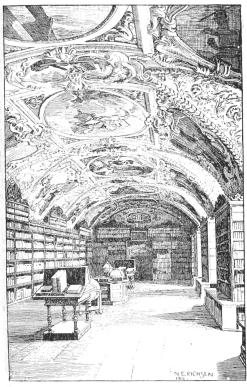
THE LIBRARY, STRAHOV
{162}
{163}
that has been long dispersed. Its greatest treasure was an ancient
Slavic MS. containing the evangel, which had once belonged to St.
Prokop, the first abbot of the Sazava Monastery, and was traditionally
reported to have been written by him. This valuable MS. was brought to
France and—by one of history’s little ironies—became the texte du
sacre used at the coronations of the Kings of France.[49]
During the Hussite Wars the church and monastery were in the hands of
the Utraquists, but it was restored to the Roman Catholics towards the
end of the sixteenth century. We read that in 1592 riots near this
church occurred, because the abbot had allowed his labourers to work on
the 6th of July, which was then still a day sacred to the memory of John
Hus.
The monastery still shows some traces of its antiquity. It contains two
pictures that date from the time of Charles, and a Royal chapel, divided
by a railing from the rest of the church. Over the entrance of the
chapel is a portrait of Ferdinand III., who presented the monastery to
the Benedictines of Mont Serrat. In the cloisters are some frescoes that
also date from the time of Charles IV. Emaus was purchased in 1880 by
German Benedictines, who have restored it with much care and good taste.


MOST ANCIENT ARMS OF
THE MALÁ STRANA
{164}
CHAPTER VI
The Bohemian Museum
THE Bohemian Museum (Museum Kralovstvi Ceskéhö) has a great and twofold
interest, both as containing most valuable relics of the past of Bohemia
and as constituting the most important monument of the ‘Resurrection’ of
Bohemia in the nineteenth century. I have already briefly referred to
that movement, of which the Bohemian Museum is, with the National
Theatre, the most prominent architectural expression. The society of the
Bohemian Museum was founded on April 15, 1818, mainly through the
exertions of Counts Kolowrat, Sternberg and Klebelsberg. Almost the
whole Bohemian nobility favoured the new enterprise, and among its
earliest patrons were members of the Auersberg, Kinsky, Schwarzenberg,
Thun, Trautmannsdorf, Waldstein, Wratislaw families. I shall not, I
hope, be accused of undue pride if I mention that I find the names of
Counts Rudolph and Jerome Lützow in one of the earliest lists of
members. It is of more general interest to note that the list of members
for the year 1824 contains as ‘Ehrermietglied’ the name of ‘Von Göthe,
Sachsen-Weimar-Eisenachser, Staatsminister and Geheimer Rath.’ This fact
is noteworthy as proving how entirely the great mind of Göthe was exempt
from the narrow-minded racial prejudice, which generally renders the
Germans hostile to the development of the Bohemian people.{165}
The collections of the museum were first housed in a modest building on
the Hradcany, and then transferred to a larger building in the Prikopy
or Graben. This also became insufficient, and the Bohemian Diet resolved
in 1884 to erect the present building at the upper end of the Václavske
Námesti—on the spot where the horse gate (Konska brána) of the new town
stood. It was completed in 1891, and the museum was opened by the
Archduke Charles Louis on the 18th of May of that year. The exterior of
the building is decorated with statues. Entering the building, we first
reach the fine vestibule, which is decorated with great splendour. The
ground floor, besides this large hall, contains (at the left angle) the
archives, the rich library—the use of which is liberally granted to
foreign visitors—the valuable print-room, and several halls used by
patriotic associations. Ascending the fine marble staircase, we first
reach the so-called ‘Pantheon,’ a large, handsome hall in which the
meetings of the society of the museum and of the Bohemian Academy are
held.
Walking through the rooms according to their numbering, we find in Hall
I. a very interesting collection of MSS. and early printed works from
the library and archives that are exhibited here. Here are the MSS. of
many ancient Bohemian books that have been recently reprinted, among
them the famed MS. of Kralové Dvur, the genuineness of which has raised
so great a controversy in Bohemia. It has been placed next to an
undoubtedly genuine early Bohemian MS., and to those that are not
experts in palæography the two appear absolutely identical. The
collection of early printed works is also very interesting; among them
is the first book printed in Bohemian, the Kronyka Trojanská, printed
at Plzen in 1468. On the walls hang ancient engravings, mostly by
Sadeler,{166} representing views of Prague in the seventeenth century; two
of these are reproduced in this volume. It would be interesting to deal
more fully with this hall that contains an epitome of the history and
literature of Bohemia, but want of space renders this impossible. I may
add that an excellent catalogue is sold in the museum. Hall II. contains
a valuable collection of coins, medals and seals. The collection of
Bohemian coins is complete. After Hall III., used for offices, we arrive
at Halls IV., V. and VI., which contain prehistoric remains discovered
in various parts of Bohemia. Hall VII. requires little notice, but Hall
VIII. is one of the most interesting. It contains a noteworthy
collection of arms and armoury. Here are several specimens of the famed
“cep” or battle-club of the Hussites, very curious painted Hussite
shields, some of which bear the arms of Prague, the sword with which the
Bohemian leaders were decapitated on the memorable 21st of June 1621,
and the sword of Gustavus Adolphus. Here, too, the tablets commemorating
the Compacts are preserved. The other halls on this and on the second
floor contain most valuable mineralogical, zoological and botanical
collections, which, being almost entirely confined to Bohemia, are most
instructive to those who wish to study these features of the country. On
the second floor there is also a very curious collection of figures
representing the—now partly extinct—national costumes of the various
parts of Bohemia.{167}
CHAPTER VII
Walks in Prague
ALMOST all the best hotels of Prague are situated near the State Railway
Station, in the Hybernská Ulice and the adjoining angle of the Graben.
This will therefore be the usual starting-place for those who have
sufficient time to walk leisurely through the streets of Prague. As the
former divisions of the town have great historical importance, I shall
refer separately—firstly to the old town, then to the new town and
Vysehrad, lastly to the Malá Strana and Hradcany. For the last-named
walk the traveller will start from the bridge. Immediately opposite the
Hybernská Ulice is the powder tower. The original building on this spot,
as already mentioned, formed part of the ancient fortifications of the
old town, which King Wenceslas I. erected in the thirteenth century. The
present building was built in 1475 by King Vladislav II. It is in what
is known in Bohemia as the Vladislav style, and is the work of Matthew
Reysek, one of the originators of that style of architecture. The
building was used as a powder magazine during the reign of Leopold I.,
and then acquired the designation that it still bears. The powder tower
was skilfully restored in 1883 by the talented architect Joseph Mocker.
Walking down the Celetná Ulice we pass on our right the spot where a
Royal residence, known as the King’s Court, Kraluv Dvur, which was
inhabited by several Bohemian Kings, once stood. We soon reach the
market-place of the old town. Both the Celetná{168} Ulice and the
market-place contain many ancient houses—the family residences of
citizens of the old town—that well deserve notice. The recent
demolitions have not as yet much changed the character of the
market-place, while the Celetná Ulice is happily, as yet, untouched. The
market-place, the forum of Prague, plays a great part in the story of
the town. During the days of independence the burghers assembled here,
and the meetings were often very stormy, particularly when the citizens
were displeased with the decisions of the town council that met at the
radnice. It was on the market-place too that the memorable executions on
June 21, 1621, took place. In the centre of the market-place a statue of
the Madonna, erected by Ferdinand III., commemorates the successful
repulse of the Swedish attack on Prague in 1648.
The Tyn Church and the Kinsky Palace, which have already been mentioned,
are also situated in the market-place. But we must now visit the town
hall (radnice) that has so often been referred to in these pages. The
very curious ancient clock will attract the attention of the visitor. It
was constructed in 1490 by Magister Hanus. Besides the hours, it
indicates the time of the rising and setting of the moon and sun. Above
the clock is a small window, at which figures, representing Christ and
the Apostles, appear whenever the clock strikes a new hour. There are
almost always spectators in the market-place opposite the clock-tower,
who await the appearance of these figures. The town hall has been built
and rebuilt at various periods. It is certain that a building in which
the councillors of the old town met was erected on the ground where the
present town hall stands in 1338, but the building has been frequently
enlarged by the purchase of adjoining houses. The oldest existent
portions of the building{169}

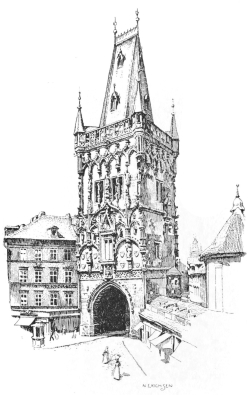
THE POWDER TOWER
{170}
{171}

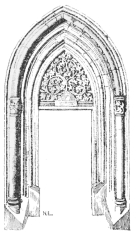 DOOR OF OLD SYNAGOGUE
DOOR OF OLD SYNAGOGUE
are the tower and the Chapel of St. Lawrence, which date from the year
1381. To the left of the tower is the main entrance to the town hall,
and on the first floor we enter the ancient council chamber, which
adjoins the Chapel of St. Lawrence. It was built during the reign of
Vladislav II., and contains a ceiling with very fine carvings. The walls
are adorned with carvings that represent the armorial bearings of the
Prague guilds. One of the halls that the traveller should also visit is
that of the primator or burgomaster. It contains portraits of all the
burgomasters of the old town—afterwards of the whole community of
Prague—since the sixteenth century. Recently a modern large council
chamber has been erected. It contains two paintings by Brozik
representing Hus before the Council of Constance, and the election of
George of Podebrad as King, an event which took place within this
building. The town hall has, however, been so much changed since that
period that it is not exactly known in what part of the building this
momentous event occurred. Of historical interest are the{172} dungeons of
the town hall, which have remained exactly as they were when the
Bohemian patriots were confined here in 1621 on the eve of their
decapitation. Immediately behind the town hall is the Renaissance Church
of St. Nicholas,[50] which, by permission of the city, is now used for
the services of the Russian community.
Turning to the right we reach the Joseph Street, which marks the
boundary of the Jewish town, now called Joseph’s town, the ancient
ghetto of Prague, that still preserves its mediæval character. Entering
the Rabbi Street, we see at our left the Jewish town hall, perhaps one
of the most picturesque buildings in Prague. Immediately opposite is the
far-famed old synagogue, built in the early Gothic style about the
beginning of the thirteenth century. Over the vaulting is a large flag
given to the Jews by the Emperor Ferdinand III. for their bravery during
the siege of 1648. It was ‘the highest honour that could then be
conferred on a Jew,’ as the guide rather pathetically states. Adjoining
the synagogue is the Jewish cemetery, one of the best-known spots in
Prague. It is very extensive, and contains countless monuments, on many
of which we see the emblems of the tribes of Israel, and the quaint
devices—such as a hare, stag or fish—which with the Jews did duty as
armes parlantes. The somewhat gloomy outlook is enlivened in spring by
the gleam of the numerous elder trees that have been planted here.
Immediately outside the precincts of the Jewish town, on the banks of
the Vltava, stands the Rudolphinum, a modern institution named after the
late Crown Prince. It contains a concert room and a small picture
gallery, which is worthy of notice as containing{173} paintings by
little-known Bohemian artists. Perhaps one of the most interesting
pictures is a holy family by Master Detrich of Prague, a votive offering
of Archbishop Ocko of Vlasim, who is represented as kneeling before his
patron saint. In one of the rooms is an interesting collection of
engravings by Wenceslas Hollar, a native of Prague, who principally
worked in England. Turning to the left, and following the course of the
Vltava, we reach the famed Charles Bridge (Karluv Most). At the eastern
end is the monument of King Charles, erected in 1848 in commemoration of
the 500th anniversary of the foundation of the University by that
Sovereign. Quite close to the bridge—which I shall mention later—is
the vast agglomeration of buildings known as the Clementinum, a Jesuit
college founded in 1556 by Ferdinand I. The building was constantly
enlarged up to 1715, and became one of the most important centres of the
Jesuit order. The former Utraquist University of the Carolinum was in
1654 joined to the Jesuit college. The building is still used for the
lectures of the philosophic faculty of the University, the valuable
library of which is also housed here. It contains over 170,000 printed
works, and many interesting MSS. of the period of the Hussite War. Of
special interest is the ‘Malostransky Kancional’ (liturgy), dating from
1572. It contains on the page dealing with the martyrdom of Hus (July 6)
three miniatures, in which we see superposed Wycliffe striking the fire,
Hus lighting the coals, and Luther holding the already flaming torch.
The Clementinum also contains two churches, an observatory, the
archbishop’s printing office, and a seminary.
In one of the courtyards we see a statue (by J. Max) representing a
student. It was erected in 1848 in commemoration of the second centenary
of the siege of Prague. The students, then all Catholics, greatly{174}
distinguished themselves in the defence of the bridge against the
Swedes.
Continuing to follow the Vltava, we soon reach the equestrian statue of
the Emperor Francis I., which stands in the middle of a small garden.
Near here, in the Karolina Svetla Street, is the interesting Romanesque
Chapel of the Holy Cross, one of the three earliest ecclesiastical
edifices of Prague. It is one of the three Romanesque chapels which
still exist at Prague. Its date can only be conjectured, as though it is
first mentioned in the fourteenth century as a parish church, it is
undoubtedly of much greater antiquity. In the seventeenth century it
ceased to be an ecclesiastical building, and might have continued
unknown if the ‘Umelecká Beseda’ (artistic society) had not acquired the
building and (1863-1865) caused it to be very skilfully restored. It was
re-consecrated by Archbishop Prince Schwarzenberg in 1879.
Continuing from the Karolina Svetla Street to the Bethlehem Street we
soon reach the square of the same name. It is on this spot, for ever
connected with the memory of Hus, that it is proposed to erect a
monument to the great Church-reformer. Here once stood the Bethlehem
Chapel, the cradle of Church reform, and the modest dwelling of Hus. A
tablet on the door still reminds the traveller of the spot. On the
Bethlehem Square also is the very ancient house known as ‘U Halanku,’ a
fine specimen of the ancient civic architecture of Prague. It belonged
for a considerable time to the family of Krocin Z Drahobejlu, whose arms
can still be seen in the courtyard. Wenceslas Krocin was for some time
‘primator’ (i.e., burgomaster) of the old town of Prague. This house
now contains an Industrial Museum, with reading-rooms erected by the
late Mr. Naprstek. Mr. Naprstek resided for a considerable time in
America,{175}

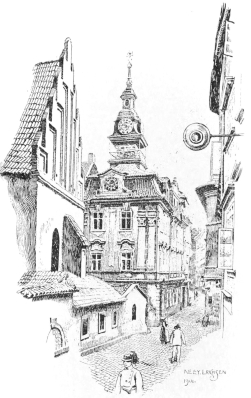
JEWISH TOWN HALL AND OLD SYNAGOGUE
{176}
{177}
and his library—access to which is liberally granted to visitors—is
very rich in English books. Mrs. Naprstek still resides here, and is
well-known for her charity, patriotism and kindness to foreign visitors
to Prague. Returning to the quay, on the border of the river, we soon
reach the Ferdinand Street, and see at its left angle the Bohemian
National Theatre, an important memorial of the national revival. The
building was begun in 1868 and completed in 1881. Almost immediately
afterwards it was greatly injured by a fire that broke out, and it was
only in 1883 that it was opened amidst great rejoicings of the Bohemian
people. Travellers in Prague are strongly recommended to pay a visit,
even if but a short one, to this fine building, particularly should a
translation of an English play be given. I have seen the School for
Scandal admirably given in Bohemian at the National Theatre.
Immediately opposite is the new Francis Bridge, opened by the Emperor in
the present year (1901). It connects one of the islands of the Vltava,
and its left bank with the old and new towns. Near here too is the
‘Sophia’s Island.’ It contains a park and restaurant where concerts are
frequently given. It is historically interesting as having been the
meeting-place of the Slavic Congress of 1848 that ended so disastrously.
The Ferdinand Street with its continuations, the Ovocná Ulice (Fruit
Street), and the Prikopy or Graben constitute the main thoroughfare of
the modern town of Prague. At the angle of the Ferdinand Street and the
Ovocná Ulice—in the Jungmann Square—stands the monument of Joseph
Jungmann, one of the great leaders of the national movement, who lived
in the Jungmann Street close by. Continuing on the left side of the
Prikopy, we reach the Havirska Ulice (Miners Street). Turning to the
left here, and{178} passing the German Theatre, we arrive in a few minutes
at the Carolinum, which bears the name of Charles IV., the founder of
the University of Prague. Though the building has been modernised, and
only the Chapel of SS. Cosmas and Damianus and the Gothic projection
retain the ancient character, it is one of the most historically
interesting buildings at Prague, as—next to Bethlehem Chapel—it is the
one most intimately connected with the career of Hus. It was here that
he and his friends defended the teaching of Wycliffe (July 1410), and
here, too, that the great disputatio took place (June 1412), in which
he eloquently denounced the abuse of indulgences. In later days, too,
the Carolinum was a stronghold of Utraquism. Many of the stormy meetings
of the Bohemian nobles that preceded the defenestration of 1618 were
held here. The place, indeed, became so noted as a meeting-place of
heretics, that after the Battle of the White Mountain some Catholic
generals suggested that it should be destroyed. The Carolinum now
contains the lecture rooms of the juridical and medical faculties of
both the Bohemian and the German Universities of Prague. From the
Carolinum we can either take the Zelezna Ulice (Iron Street), which
leads us back to the town hall, or through the Ovocni Trh (fruit
market), reach the Celetná Ulice, or return to the Graben, at the end of
which we reach the powder tower.
The new town and the Vysehrad are not equal in interest to the old town
and its sub-division, the Jewish quarter, yet here, too, there are more
objects of interest than limited space will allow me to mention.
Starting again from the powder tower, we arrive, through the Josefské
Námesti, at the angle of the Poric Street, the site of one of the oldest
settlements of Prague. Walking through this street to its{179} end we
find—opposite the North-Western Railway Station—the new civic museum
that is far too little known to visitors. This building is quite a
modern creation, and in its present state has only been opened to the
public since 1898.
The first hall on the ground floor contains prehistoric remains,
numerous objects in glass and majolica that belonged to old Prague. The
second hall contains works in metal; particularly interesting are the
Gothic doors of a house in the Václavské Námesti, with the arms of the
old and the new towns. The third hall, devoted to ecclesiastical art,
contains many objects of great interest from various churches; a Gothic
predella, and a Gothic altar from the Castle Rabi deserve particular
notice. In this hall also are many valuable memorials of Hus; in all
these portraits, as, indeed, in all very ancient ones, he is represented
as beardless. Hall four contains many memorials of old Prague. On the
second floor we find in halls five and six a large collection of
engravings that are of immense value to the student of history. Besides
a large number of views of Prague at different periods, there is a
valuable collection referring to the Thirty Years’ War. We see
representations of the defenestration, the entry of Frederick of the
Palatinate into Prague, the Battle of the White Mountain, and the
executions on the market-place, as well as an almost complete collection
of the portraits of the generals and statesmen of the Thirty Years’ War.
Also on the second floor is the armoury, which well deserves the
attention of the visitor. In hall nine on this floor are flags, shields
and coats of arms that belonged to the ancient guilds of Prague. An
underground part of the museum contains the mucirna or torture-chamber,
which gives a vivid impression of the ways of mediæval justice. The
Gothic vaulting of{180} this chamber is mediæval, and was transported here
from a house on the market-place of the old town.
We are here at the extreme limit of the new town. Eastward lie the
modern suburbs Karlin (or Karolmenthal) and Zizkov. The former contains
a fine Romanesque cathedral, built between 1854 and 1863, which is
dedicated to St. Cyrillus and St. Methodius, the apostles of the Slavs.
Zizkov, which stands on the spot where Zizka won his famous victory, was
entirely built in the nineteenth century. It has increased very rapidly,
and with its population of 50,000 inhabitants is now, next to Prague,
the most populous town in Bohemia.
Returning to the Poric, and then turning to the left, the traveller
passes the State Railway Station, and after crossing the Hybernská Ulice
and pursuing his way through the Senovazná Ulice (Hay-Balance Street),
finds himself at the Church of St. Henry, at the corner of the street of
that name, and of the Jerusalemská Ulice.
A parish church has existed here since very early times, but a new
building in the Gothic style was erected here in 1348 by Charles IV.
Since that day the church has again been rebuilt several times, so that
it does not retain much of its ancient character. It contains pictures
by Skreta, the Bohemian painter, and others. Close to the church is the
Gothic campanile, which dates from the beginning of the reign of
Vladislav II.
Following the Jerusalemská Ulice, we reach the extensive town park,
which is built on the site of the old fortifications of the Nové Mesto,
and divides it from the suburb of Vinohrady (vineyards). At its eastern
extremity is the Bohemian Museum that has already been mentioned. From
here the wide Václavské Námesti leads to the Graben. Turning{181} from the
Václavské Námesti to the left by the Stephens Street we reach the church
of that name, which was built by Charles IV., but has, like so many
others at Prague, been greatly altered by restoration. It contains,
however, some works of very ancient Bohemian painters that are very
worthy of notice. Close to St. Stephen’s Church is the very ancient
Romanesque Chapel of St. Longinus. Similar to the Chapel of the Holy
Cross and that of St. Martin on the Vysehrad—which will be mentioned
presently—it is, as Monsignor Lehner writes, ‘smaller and plainer and,
therefore, probably even more ancient than the sister chapels.’
Retracing our steps as far as the angle of the Zitná Ulice, and
proceeding down that street, we soon reach the extensive Karlovo
Námesti, which has been laid out as a park, in which a monument to the
Bohemian poet Halek has been erected. Opposite this monument, at the
north-eastern extremity of this square, is a building, now the site of
the law courts, which was once the town hall of the Nové Mesto. From the
windows of this building the town councillors were thrown in 1419, an
event to which reference has been already made.
This town hall, built under Charles IV., and a subsequent building in
the Renaissance style that was afterwards erected here have long
disappeared. The last-named building was demolished in 1806 by order of
the Emperor Francis I., and the present uninteresting structure was
erected. Of the old building a tower, formerly, probably, a campanile
similar to that of the town hall of the old town, remains. It contains a
chapel dedicated to St. Wenceslas, which is still in the same condition
as it was in the fifteenth century.
From the Karlovo Námesti, following the Vysehrad{182}

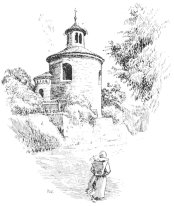 CHAPEL OF ST. MARTIN
CHAPEL OF ST. MARTIN
Street, and passing near the Emaus Monastery, that has already been
mentioned, we arrive at the Vysehrad. The Vysehrad, formerly an
independent community, but now one of the districts of Prague, has at
the present day little interest for the mere sightseer. But its mythical
and historical associations render it very precious to those who have
some knowledge of Bohemia’s past. The traditions connected with the spot
have been the subject of many Bohemian poems. Recently Zeyer published
his Vysehrad, which will interest those who wish to penetrate somewhat
deeper into the past of Prague.[51] Of the old semi-mythical residence
of Libussa no trace remains, and the mediæval citadel that played so
important a part in the Hussite Wars has also disappeared. The existent
fortifications are of modern date. Of the many former churches on the
Vysehrad two only now require notice. One is the Romanesque Chapel of
St. Martin,{183} said to have been founded by St. Adalbert on the site of a
Pagan temple. It is one of the three round chapels that are the oldest
religious edifices in Prague. It is, as Monsignor Lehner writes, ‘the
only remaining relic of the splendour of the Vysehrad during the period
of Romanesque architecture.’
Another interesting church is that of St. Peter and St. Paul, built
originally as a Romanesque basilica, but altered considerably after the
Hussite Wars. An interesting legend connected with the church is, or
rather was, related to the visitors of St. Peter’s Church. Mr. Kohl, who
visited Prague in 1841, writes:[52] ‘A memorable tale was told me by my
conductress. “Once upon a time a poor man went into the forest. There he
met a smart, jovial-looking huntsman, at least so he supposed, but in
truth it was no huntsman, but the devil in disguise. Now the huntsman
spoke to the sorrowful man and said, ‘Art poor, old boy?’ ‘Ay, miserably
poor, sir, and full of care,’ replied the other. ‘How many children hast
thou?’ ‘Six, noble sir,’ answered the poor man. ‘Give me for ever that
child of thine that thou hast never seen and I’ll give thee thy fill of
money.’ ‘Willingly, sir,’ was the silly father’s reply. ‘Then come, and
we’ll sign and seal the bargain.’ The old man did so, and received
countless heaps of money. When he got home, however, to his own house,
to his surprise he found that he had seven children, for his wife had in
the meantime brought the seventh into the world. Thereupon the father
began to feel very uncomfortable, and to suspect that the devil had
talked him out of his child. In his anxiety he called his new-born son
Peter, and dedicated him to the Apostle, praying St. Peter to take the
boy under his protection{184} and shield him against the devil’s arts.
Peter, who appeared to the old man in a dream, promised to do what he
was asked provided the boy was brought up to the Church; so, of course,
the lad was given to God’s service, that he might be a priest when he
grew up. Peter turned out a good, pious and learned young man. When he
was twenty-four years old and had been installed as a priest at the
Church of the Vysehrad, the devil came one day to put in his claim to
his reverence, but the holy Apostle St. Peter interfered and declared
that the deed which the devil produced was a forgery. The devil and the
saint came to high words at this, while the poor priest, frightened out
of his wits, ran into the church and betook himself to reading Mass.
Now, as they could in no way come to an understanding, St. Peter, by way
of a compromise, proposed a new bargain. ‘Do you fly to Rome!’ said he
to the devil, ‘and bring me one of the columns of St. Peter’s Church,
and if you’re back with it before my priest has read to the end of the
Mass, he shall be yours; but else mine.’ The devil, who thought he
should have plenty of time, accepted the proposal with pleasure, and in
a few seconds Peter saw him flying up full speed with one of the
columns. The devil would have won, there’s no doubt, if St. Peter had
not quickly gone to meet him and begun to belabour him with a horsewhip.
The devil in his fright dropped the huge pillar, which fell plump to the
bottom of the Mediterranean Sea. He lost but little time in diving for
it and bringing it up again; but he lost quite enough, for when he
arrived at the church the priest had just said his ‘Ite missa est,’ and
so his Mass was at an end. St. Peter laughed heartily; and the devil was
so vexed that in his rage he flung down the big column, which went
through the roof of the church and fell upon the floor, where it was
broken{185} into three pieces. Many attempts were made to repair the hole in
the roof, but they could never make the work hold, for it always fell
in, and so at last they gave it up; and there the hole remained for many
hundred years, leaving a free way for rain and wind. The Emperor Joseph,
however, insisted upon having the roof repaired, so they carved the two
keys of St. Peter in the centre stone of the vault, and since then the
work has held.” Besides some paintings by Skreta, it contains a curious
Madonna of the thirteenth century, said to have been once the property
of Charles IV. The church is surrounded by a cemetery, in which many of
Bohemia’s patriots are buried. We find here the tombs of the writers
Halek, Neruda, Benes Trebizky, Hanka, Mrs. Nemcova, those of the
Ministers Iirecek and Kaizl, and many others. Quite recently a fine
monument has been placed over the grave of Zeyer, the poet of the
Vysehrad. When leaving the Vysehrad the traveller can either descend to
the banks of the Vltava, follow the Podskal Street, and then the Palacky
Quay—from which a bridge, also named after the great historian, leads
to the suburb of Smichov—and finally reach the Bohemian theatre; or
passing through the ‘Na Slupi’ Street he may, turning to the right into
the Horská Ulice, reach the Karlov Church, which is at the corner of the
Horská and Karlova Streets. This very fine Gothic edifice, one of the
most interesting churches in Prague, was built by Charles IV. in 1350,
and its octagon dome is said to be an imitation of the burial place of
Charles the Great at Aachen. The church has some very fine stained-glass
windows, which date from the time of Vladislav II., and some good
pictures.
The Karlov or Church of the Ascension of the Virgin Mary—to give it its
correct designation—has,{186} however, like so many others, suffered
severely from the restorer. Following the Karlova Ulice, and then
turning to the left, at the corner of the St. Apolinar Street, we reach
the interesting Gothic church of that name. From here we retrace our
steps to the Na Slupi and then the Vysehrad Street, and soon arrive
again at the Karlovo Námesti. Thence we soon reach through the Jungmann
Street the Jungmann monument, in the Ovocná Ulice, and the limits of the
new town.

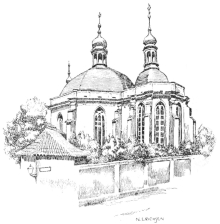
KARLOV
For his wanderings through the parts of Prague that are on the left bank
of the river the traveller will start{187} from the far-famed Bridge of
Prague, for so it is still called, though its official designation is
the Charles Bridge, and there are now many other bridges at Prague.
As already mentioned, there has been a bridge on or near the spot where
the present edifice stands from very early times. Ancient chroniclers
write that when, in 932, the body of St. Wenceslas was conveyed from
Stará Boleslav, where he was murdered, to St. Vitus’s Church at Prague,
those who carried the body, ‘hurrying to the river Vltava, found the
bridge partly destroyed by the floods. They gave themselves up to
prayer, and having raised the body on their arms they passed, as if they
were carrying no burden, gladly and without hindrance over the
half-ruined bridge.’ The fact that the body of St. Wenceslas was
conveyed across the Vltava on March 4, at a time when the spring flood
often damaged the Bridge of Prague, confirms, as Mr. Svátek writes, the
correctness of this narrative, which contains the earliest mention of
the Bridge of Prague. The account of the state in which the bridge was
found also renders Mr. Svátek’s conjecture that it was then already very
ancient very plausible. As the suburbium Praguese—as I have already
mentioned—extended on both banks of the river, wooden bridges, such as
the earliest ones undoubtedly were, soon became insufficient. When, in
1157, the floods had entirely destroyed the wooden Bridge of Prague,
Queen Judith, consort of King Vladislav I., caused a new stone bridge to
be erected at her own expense. It was said that she undertook this work
because, being a German by birth, and having twice used her influence to
place her German relations on the episcopal throne of Prague, she had
incurred the hostility of the Bohemians. She hoped to regain the love of
the Praguers by thus becoming a{188}

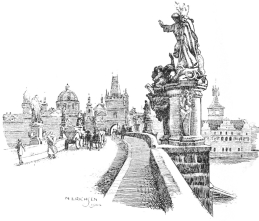
FROM THE BRIDGE LOOKING TOWARDS THE OLD TOWN
benefactress of their city. Judith’s Bridge was begun in 1169 and
finished in three years, an almost inconceivably short space of time.
The completion of the bridge was greeted with great rejoicement by the
Bohemians, who said that, excepting the bridge over the Danube at
Regensburg, no such bridge had been built since the days of the Romans.
In the winter of 1342 the Bridge of Judith was destroyed by the floods,
and for a time a temporary wooden bridge, partly founded on the
remaining pillars of the stone bridge, alone connected the two parts of
Prague. This bridge naturally proved insufficient, particularly after
Charles IV. had founded the new town of Prague.{189} In 1357 that King
undertook the building of the present bridge. The building was erected
under the direction of Matthew of Arras, and afterwards of Peter Parler
and his son John. The work was often interrupted by storms and
inundations, to which the Vltava, the outlet of all the rivers of
Central and Southern Bohemia, is particularly liable. It was, therefore,
only completed in 1503.
We first pass under the bridge tower of the old town, which is decorated
with statues of the Bohemian patron saints and with the coats of arms of
the countries that were formerly connected with Bohemia as well as that
of the old town itself.
The statues that now ornament the bridge formed no part of the original
structure. As can be seen in ancient engravings, a crucifix only stood
on the bridge at first. Rudolph erected statues of the Madonna and of
St. John, and the others were gradually added, principally during the
period of Catholic re-action in the seventeenth and eighteenth
centuries. There are now thirty statues of unequal value, fifteen on
each side of the bridge. It may be of interest to give a list of these
statues, beginning with those that are to the right of the visitor who
crosses the bridge from the old town into the Malá Strana:—
1. St. Bernard (1709), by Jäckel.
2. St. Dominicus and Thomas Aquinas (1708), by Jäckel.
3. A bronze-gilt statue of the Crucifixion, with statues of the Virgin
Mary and St. John.
4. St. John the Baptist (1853), by J. Max.
5. St. Ignacius of Loyola (1711), by Ferdinand Prokov; a foundation of
the Jesuit College of Prague.
6. The Holy Trinity (1706), also by Prokov. Between this group and the
next one, a cross and{190} tablet mark the spot where St. Nepomuk was thrown
into the river.
7. SS. Norbert, Wenceslas and Sigismund (1853), by J. Max.
8. St. John of Nepomuk, cast in bronze at Nüremberg in 1683, after a
model of J. Prokov.
9. St. Anthony of Padua (1707), by Ulrich Mayer.
10. St. Judas Taddæus (1708), also by Ulrich Mayer.
11. St Augustine (1708), by Jerome Kohl.
12. St. Gactanus (1709), by Ferdinand Prokov.
13. St. Philip Binitius (1711), by Mendel of Salzburg.
14. St. Vitus (1714), by Ferdinand Prokov.
15. SS. Cosmas and Damianus (1707), by Ulrich Mayer.
On the left side of the bridge are the following statues:—
16. St. Ivo (1711), by Matthew Braun.
17. SS. Barbara, Margaret and Elizabeth (1702), by the brothers Prokov.
18. The Mater Dolorosa (1859), by Em. Max.
19. St. Joseph (1854), by Jos. Max; a gift of the Countess Prîchovská.
20. St. Francis Haverius (1711), by Ferdinand Prokov; a gift of the
theological and philosophical ‘faculties’ of the University of Prague.
21. St. Christopher (1857), by Em. Max.
22. St. Francis Borgia (1710), by the brothers Prokov.
23. St. Ludmilla (1785), by an unknown artist.
24. St. Francis Seraphicus (1855), by Em. Max.
25. SS. Vincent and Prokov (1712), by Ferdinand Prokov.
26. St. Nicholas of Tolentino (1706), by J. Kohl.{191}

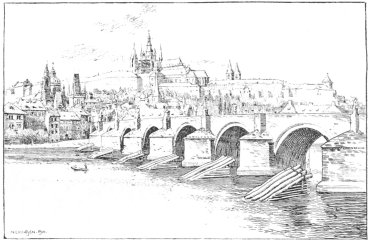
VIEW OF THE BRIDGE FROM THE MILLS OF THE OLD TOWN
{192}
{193}
27. St. Ludgardis (1710), by M. Braun.
28. St. Adalbert (1710), by the brothers Prokov.
29. SS. John of Matha, Ivo and Philipp (1714), by Ferdinand Prokov.
30. St. Wenceslas (1857), by Camillas Böhn, after a sketch by the
painter Führich.
In 1890 inundations again greatly injured the Bridge of Prague. A
portion of the work was entirely destroyed, and the statues of St.
Ignacius of Loyola and of St. Francis sank in the floods. These injuries
have now been entirely repaired. The view of the Hradcany from the
bridge is one of the most striking ones in Prague.
Passing by the second bridge tower we reach the Malá Strana, near which
once stood the ancient residence of the bishops, and afterwards
archbishops, of Prague, a building often mentioned in the records of the
struggles of the Hussite Wars, or market-place of the ‘small quarter,’
on which is a statue of Radecky, erected in 1858. As materials,
Piedmontese cannon captured in 1848 and 1849 were used.
Here also is the Nicholas Church that has already been mentioned, and
near here are the palace of the Governor of Bohemia and the palace where
the Bohemian Diet assembles, since it no longer meets on the Hradcany. A
steep path leads to the summit of the Hradcany Hill. The two most
important buildings on this height, the Royal Palace and St. Vitus’s
Cathedral, have already been mentioned. Between these buildings stands
the very fine equestrian statue of St. George, cast in 1373 by order of
Charles IV. This fine statue, a work of the brothers George and Martin
of Clussenburk, is excessively interesting as giving a faithful
representation of the armour worn by the knights of the fourteenth
century.{194}
Behind the cathedral is the Church of St. George, occupying the spot
where one of the earliest Christian churches in Bohemia, built by Prince
Vratislav I. about the year 915, once stood. Princess Mlada, sister of
Boleslav II., in 915 here built a Benedictine convent, of which she
became abbess, and which became very famous in Bohemia. Charles IV.
granted to the abbess of this convent the right of crowning the Queens
of Bohemia. They retained this right up to the suppression of the
convent by the Emperor Joseph II. It was then transferred to the
superior of the Chapter of Noble Ladies, which the Empress Maria Theresa
had founded.
The first Church of St. George was destroyed in 1142, during the
troubles that followed the death of Sobeslav.[53] A Romanesque building
was then erected, which is the finest building in that style of
architecture in Bohemia. Though here also restorations have taken place,
the church has, on the whole, retained its ancient character, and it is
well worth the attention of the traveller. It contains the graves of
several of the most ancient rulers of Bohemia and of their wives. The
ancient frescoes in this church and the chapels of St. Ludmilla—where
that saint and Princess Mlada, the first abbess of St. George’s convent,
are buried—and of St. Anne require particular notice. During the recent
restorations the stucco ornaments that concealed the old Romanesque
doors and windows have been removed. Of great interest are the four very
ancient towers on the Hradcany Hill, which date from the time of Ottokar
II. and have already been mentioned. They overlook the Jeleni Prikop
(Stag’s Ditch), and are reached by the Jiriska Ulice, passing through
buildings that are used as Government offices. These towers were used as
prisons, and the White Tower in{195} particular, which has been compared to
the Bastille and the Tower of London, was the principal State prison of
Prague. The leaders of the Protestant movement against Ferdinand I.,
Bishop Augusta, the head of the Bohemian brethren, the Bohemian leaders
who were decapitated in 1621, the partisans of Charles of Bavaria
(1743), and many others were imprisoned here.
The Daliborka Tower is very famous in popular legends. It is said to
have received its present name from Dalibor of Kozojed, a knight who was
imprisoned here during the reign of Vladislav II. The serfs of a
neighbouring knight, Adam of Ploskov, had been driven to revolt by the
cruelty of their lord, and Dalibor availed himself of this opportunity
for seizing Ploskov’s estates. He was, therefore, imprisoned in the
tower to which he has given his name, and afterwards decapitated. This
somewhat sordid event became the nucleus of legends created by the
imaginative Bohemian people. It was said that Dalibor, after spending
some years in foreign lands, had returned to Bohemia, and there
witnessed the cruelties from which the Bohemian peasants, formerly free
men, suffered; for bondage, entirely alien to the ancient customs of
Bohemia, was only established there in 1487. Under the influence of
Rozvod, an old man who remembered the days of Zizka, Dalibor incited the
peasants to rise against their lords. The revolt was rapidly suppressed,
and Dalibor imprisoned in the tower on the Hradcany Hill. It was said
that while imprisoned he learnt to play the violin to solace his
solitude, and that his music attracted crowds to the tower. The great
Bohemian musician Smetana has given the name of ‘Dalibor’ to one of his
operas, and Dalibor is also the hero of one of the books of the talented
Bohemian novelist Wenceslas Vlcek. Among the later prisoners in the
Daliborka{196} were several alchemists whom Rudolph II. called to his court,
but who failed to fulfil the promises they had made. The astronomer
Francis Tennagel, an assistant of Tycho Brahe, was also a prisoner in
the Daliborka during Rudolph’s reign.
We obtain the best view of the four towers, and indeed of the Hradcany
generally, if we cross the Stag’s Ditch and proceed to the Royal
gardens, in which is the Belvedere villa. Ferdinand I. caused it to be
built for his wife Anna. It is a fine specimen of the Italian
Renaissance, Ferdinand’s favourite form of architecture, and was built
by the Italian, John de Spatio. In the interior of the building there
are some frescoes of the earlier part of the nineteenth century
representing scenes from Bohemian history. It is characteristic of the
period that the Hussite Wars, the period of Bohemia’s greatness, are
entirely excluded. As a proof that the present Emperor of Austria from
his earliest youth possessed the sagacity and clearness of mind which is
now recognised by the whole world, it may be mentioned that when, as a
young Archduke, he visited these frescoes, he is reported to have said:
‘It is impossible even to conceive a history of Bohemia from which the
Hussite Wars are excluded.’
Close to the Belvedere is a fountain, which has rightly been called ‘one
of the finest Renaissance fountains north of the Alps.’ The design is by
Tertio of Bergamo, and the work was carried out by Jarus, an artist of
Prague.
From the Belvedere we descend the Hradcany Hill, and passing through the
Chotek Park reach the Bruska Street and the suspension bridge. Crossing
this bridge, we reach the old town and the Rudolphinum, and soon find
our way back to the powder tower.{197}
CHAPTER VIII
Walks and Excursions near Prague
TO those visitors to Prague who have acquired some interest in the
history of the country no excursion will appeal more than that to the
White Mountain, ‘the Chacronaea of Bohemia,’ as it has been aptly
called. Leaving the Malá Strana by the now-demolished Strahov gate (near
the monastery of that name), we soon reach the White Mountain. Factories
built in modern times have considerably altered the aspect of the
ground. The plateau, which the Bohemian army occupied on the evening of
November 7, 1620, and where earthworks were hastily thrown up, and the
battle-field of the following day can, however, still be clearly
distinguished. The Bohemian lines extended from the village of Repy to
the ‘Star’ Park and the village of Liboc. The last and fiercest lighting
took place immediately outside the park. Dr. Krebs[54] writes: ‘The
south-eastern angle of the “Star” Park became the grave of the national
independence of Bohemia. Every Bohemian who passes this spot should
remember, “It is holy ground on which I tread.” ’ The Star Park is now a
favourite summer resort of the citizens of Prague, who, perhaps wisely,
appear to be intent rather on present pleasure than on gloomy memories
of the past.
‘Little they think of those stout limbs
That moulder deep below.’
{198}
After the battle the Bohemian troops that still occupied the Royal
hunting lodge at the ‘Star’ capitulated, and the victorious Duke of
Bavaria spent there the night that followed the battle. Somewhat to the
south of the ‘Star’ is the Church of St. Mary, built in 1706 in
commemoration of the great defeat of the Bohemians. It is said that when
the Emperor Joseph II. visited this church he expressed his displeasure,
and he is said to have characteristically remarked ‘that he wished to
reign over men, not over brutes,[55] who celebrated their own defeat.’
It must be added that the pilgrimages to this church on November 8 have
now entirely ceased.
From the village of Liboc the traveller can by rail reach in half an
hour the romantic valley of the Sarka.
Of the many walks in the immediate neighbourhood of Prague we may
mention that to the Petrin Hill, which has already been referred to. An
outlook tower has recently been built here. Favourite summer resorts of
the citizens of Prague are the Crown Prince Rudolph Park and the
adjoining Belvedere Gardens, and the Stromovka or Baumgarten.
Those who wish to visit the village of Sterbohol, where the Battle of
Prague (in 1757) principally raged, should start from the Francis Joseph
Station and leave the train at Hostivár, the second station. The spot
where General Schwerin fell is marked by a monument erected in 1824; a
second monument was erected in 1838 by King Frederick William III. of
Prussia.
From the State Railway Station the traveller can in half an hour reach
the station of Roztok, a place much frequented by the Praguers in summer
because of the beautiful scenery. Close to here is Levy Hradec,
historically interesting as the site of the most ancient{199} Christian
church in Bohemia; it was built by Borivoj in 871. No traces of the
original building now remain.[56]

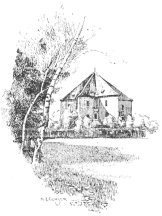 THE ‘STAR’ HUNTING LODGE
THE ‘STAR’ HUNTING LODGE
A somewhat more distant excursion, but perhaps the most interesting, is
that to the Karlstyn Castle. It is reached in little more than an hour
from the Smichov Station of the western railway. The Karlstyn was built
by Charles IV. as a refuge for the Royal Family in time of war, and also
as a safe spot where the crown jewels and the treasury could be
deposited. It was built in a manner that rendered it for the time almost
impregnable, and it successfully resisted the attacks of Sigismund
Korybut during the Hussite Wars. In consequence of the importance of the
treasures the castle contained, the custodian (burgrave) of the Karlstyn
became one of the great dignitaries of Bohemia. Among the last to hold
this office was Count Thurn, afterwards celebrated as{200} the originator of
the defenestration. His immediate successor, Martinic, one of the
victims of the defenestration, was the last to hold the office of
burgrave of the Karlstyn. With the autonomy of Bohemia the title was
naturally in abeyance after the Battle of the White Mountain. The castle
was built with great splendour, but many of the treasures it contained
were either dispersed or transported to Vienna. The present Emperor of
Austria—always a true friend of Bohemia—has lately (1901) given the
order that several of the pictures that formerly were in the Karlstyn
should be sent back there. The most valuable part of the building is the
Chapel of the Cross, that contains some interesting early Bohemian
paintings. Quite recently the Karlstyn has to a great extent been
restored in a manner that has not on the whole pleased the critics.

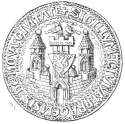
THE OLDEST GREAT SEAL OF THE MALÁ STRANA,
THIRTEENTH
CENTURY
{201}
NOTE
AS the names of the streets, squares, etc., at Prague are now only
written in the national language, I have thought that a short list of
the most necessary Bohemian words would be welcome. It will be very
useful when using the plan of Prague that accompanies this book. It is
scarcely necessary to say that English is spoken in the principal hotels
of Prague. Those who feel inclined to learn the Bohemian language which,
though difficult, is philologically of the highest interest, will find
an able guide in Professor Morfill’s Grammar of the Bohemian or Cech
Language.
- Divadlo = theatre.
- Hora = mountain; thus Bilá Hora, the White Mountain.
- Chram or Kostel = church.
- Na levo = to the left.
- Na pravo = to the right.
- Nábrezi = quay.
- Nádrazi = railway station.
- Námesti = square, market-place (the French ‘place’).
- Nové Mesto = the new town.
- Malá Strana = the small ‘side’ or quarter of Prague.
- Most = bridge.
- Ostrov = island; thus Zofinsky Ostrov, Sophia’s Island.
- Radnice—town hall.{202}
- Staré Mesto = the old town.
- Trh = market.
- Trida = street.
- Ulice = street.
It may be useful to the traveller to know that the different districts
of Prague are numbered, and that since Vysehrad in 1883, Holesovic-Bubna
in 1884, and Liben in 1901 have become parts of Prague the numbers run
thus—
I. Staré Mesto. II. Nové Mesto. III. Malá Strana. IV. Hradcany. V.
Josefské Mesto (Joseph’s, formerly the Jews’ town). VI. Vysehrad. VII.
Holesovic-Bubna. VIII. Liben.
The suburbs Karlin, Smichov and Vinohrady (‘the vineyards’) do not as
yet form part of the city of Prague.{203}
APPENDIX
THE history of Prague is to so great an extent that of Bohemia, that if
I attempted to give a full list of my authorities, I should be obliged
to enumerate the works of the principal modern Bohemian historians, as
well as those of many older chroniclers and writers of history. In a
work where compression has been necessary on every page I could attempt
no such bibliographic study. Of historical writings, I mention only Dr.
Tomek’s monumental work. I give the names only of a few books that deal
with the city of Prague and its architectural monuments. I have left
unnoticed the numerous monographs referring to Prague and the
publications of the Bohemian Museum, the Bohemian Scientific Society and
the Bohemian Academy. It is hardly necessary to state that I have also
used my own previous works on Bohemia.
AUTHORITIES
Branis Dejing umeni stredovekcho v Cechách (History of Mediæval
Art in Bohemia). 2 vols. 1892-1893.
Dolensky’s Praha. I have only been able to use the first parts of
this publication, which has just begun to appear.
Herold and Oliva Malebné cesty po Praze (Picturesque Walks
through Prague). 4 vols. 1866-1896.
Lebner, Monsignor. Dejini umeni naroda ceského (History of the
Art of the Bohemian Nation); begun 1900, not yet completed.{204}
Neuwirth, Dr. Geschichte der christlichen Kunst in Böhmen. 1 vol.
1888.
Redel, Dr. Das Sehenswürdige Prag. 1 vol. 1710.
Svátek. Culturhistorische Bilder aus Böhmen. 1 vol. 1879.
Svátek. Ze staré Prahy (of ancient Prague), 1 vol.
Tomek, Dr. Dejepis Mesta Prahy (History of the Town of Prague)
1855-1901. The twelve volumes that have already appeared contain
the history of Prague up to 1608.
PRINCES OF BOHEMIA.
| Krok. | |
| Premysl and Libusa. | |
| Nezamysl. | |
| Mnata. | |
| Vojen. | |
| Unislav. | |
| Kresomysl. | |
| Neklan. | |
| Hostivit. | |
| Borivoj I. | |
| Spitihnev I. | |
| Vratislav I. | |
| Wenceslas I. | 926-935 |
| Boleslav I. | 935-967 |
| Boleslav II. | 967-999 |
| Boleslav III. | 990-1002 |
| Vladivoj | 1002-1003 |
| Jaromir | 1003-1012 |
| Ulrich | 1012-1037 |
| Bretislav I. | 1037-1055 |
| Spytihnev II. | 1055-1061 |
| Vratislav II. (King) | 1061-1092{205} |
| Bretislav II. | 1092-1110 |
| Borivoj II. | 1110-1120 |
| Vladislav I. | 1120-1125 |
| Sobeslav I. | 1125-1140 |
| Vladislav II. (as King I.) | 1140-1173 |
| Sobeslav II. | 1173-1180 |
| Frederick | 1180-1189 |
| Conrad Otho | 1189-1191 |
| Wenceslas II. | 1191-1192 |
| Premysl Ottokar | 1192-1230 |
KINGS OF BOHEMIA
| Wenceslas I. | 1230-1253 |
| Premysl Ottokar II. | 1253-1278 |
| Wenceslas II. | 1278-1305 |
| Wenceslas III. | 1305-1306 |
| Rudolph of Habsburg | 1306-1307 |
| Henry of Carinthia | 1307-1310 |
| John | 1310-1346 |
| Charles I. (IV.) | 1346-1378 |
| Wenceslas IV. | 1378-1419 |
| Sigismund | 1436-1437 |
| Albert of Habsburg | 1437-1439 |
| Ladislas Posthumus | 1439-1457 |
| George of Podebrad | 1458-1471 |
| Vladislav II. | 1471-1516 |
| Louis I. | 1516-1526 |
| Ferdinand I. | 1526-1564 |
| Maximilian | 1564-1576 |
| Rudolph II. | 1576-1612 |
| Matthias | 1612-1619 |
| Frederick of the Palatinate | 1619-1620 |
| Ferdinand II. | 1619-1637 |
| Ferdinand III. | 1637-1657{206} |
| Leopold I. | 1657-1705 |
| Joseph I. | 1705-1711 |
| Charles II. (VI.) | 1711-1740 |
| Maria Theresa | 1740-1780 |
| Charles of Bavaria | 1741-1745 |
| Joseph II. | 1780-1790 |
| Leopold II. | 1790-1792 |
| Francis | 1792-1835 |
| Ferdinand IV. (I.) | 1835-1843 |
| Francis Joseph | 1848 |
I have continued the list of the rulers of Bohemia (many of whom were
Roman, and more recently Austrian Emperors) up to the present day, as
the title of King of Bohemia has always been retained by these
princes.{207}
PRAGUE.

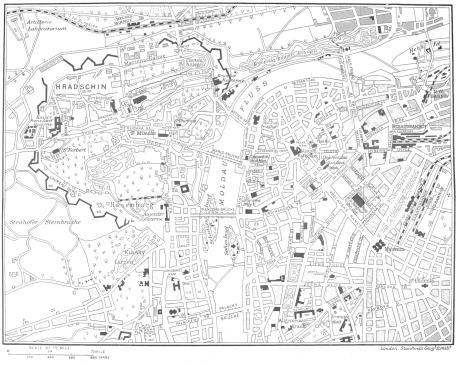
Section I.

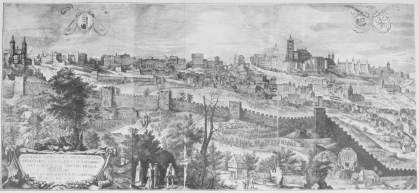 View of Prague during the Reign of Rudolph II. (In 3 Sections).
View of Prague during the Reign of Rudolph II. (In 3 Sections).
After Sadeler’s Famous Engraving,
The Inscription on it states that in 1606, Ag. Sadeler, Engraver to His
Sacred Majesty, dedicated it to the noble, most worthy, and most prudent
Primators, Consuls and Senators of the Metropolitan Threefold Town of
Prague.
Section II.

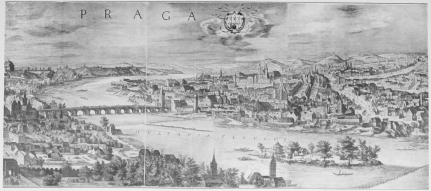
View of Prague.
The Bridge contains as yet only a Crucifix but no Statues.
Section III.

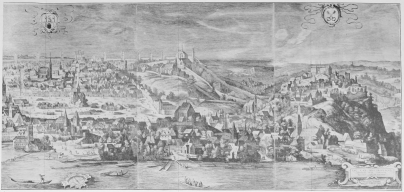
View of Prague.

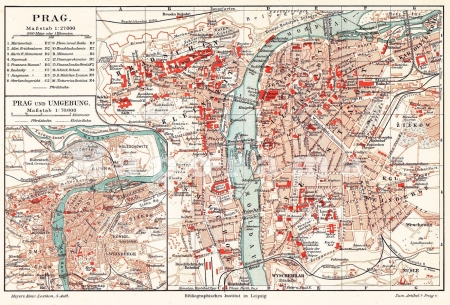
INDEX
A,
B,
C,
D,
E,
F,
G,
H,
J,
K,
L,
M,
N,
O,
P,
R,
S,
T,
U,
V,
W,
Z
A
Albert, Archduke of Austria, crowned king, 77;
short reign and death, 77.
Albik, Archbishop of Prague, 38.
Albrecht Dürer, his ‘Madonna,’ 103, 156-159.
“ ‘Madonna and Child,’ attributed to, 160.
Ales of Riesenburg, Regent of Bohemia, 69.
Archduke Ferdinand of Styria, succession of, to throne opposed by Protestants, 108.
Archduke Leopold, Bishop of Passau, invades Bohemia, 107.
Archiepiscopal Palace destroyed by Praguers, 44.
Articles of Prague, the, 56, 64.
Artists, confraternity or guild of, founded by Charles, 18.
Austrian War of Succession, 132.
B
Bartos, ‘the Writer,’ quoted, 88-89.
Belvedere, erected by Ferdinand I., 90.
Benatky, ill-famed buildings known as, destroyed by Milic, 22.
Benes of Weitmil, old chronicler, quoted, 15-16, 17.
Bethlehem Chapel, 31, 174.
Bezalel, Rabbi Löwi, mysterious interview with Rudolph II., 11.
Bishopric of Prague, foundation of, 5.
“ countries forming part of, 5-6.
Bohemia, national language of, temporary extinction of, 123;
its revival, 135-136.
Bohemia, national songs of, 136, 137.
“ ancient constitution of, negotiations with Austria for restitution of, 138.
“ Queens of, right of crowning, 194.
Bohemian Brethren, 99.
“ Museum, 134, 164-166.
“ nation, permanent supremacy of, at University secured by decree of Wenceslas IV., 35.
Bohemians resent favour shown to Germans, 11-12.
Boleslav I., Prince of Bohemia, 5.
Boleslav II., Prince of Bohemia, 5-6.
Borivoj, first Christian ruler of Bohemia, 5;
dedicates church to Virgin, 5.
Broumov, Protestant church of, closed, 108.
C
Campanile, 180.
Carolinum, becomes centre of University, 18.
“ meeting at, beginning of Hussite struggle, 32.
“ disputatio at, concerning crusade against King of Naples, 37.
“ Synod of Bohemian clergy at, 64.
“ truce meeting at, 67;
its connection with career of Hus, and present condition of, 178.
Chapel of St. Martin, romanesque, 182-183.
Chapel of the Holy Cross, romanesque, 174.{208}
Charles IV. (I. as King), 15 ff.;
founds new city of Prague, 15;
speech concerning the founding of the University, 17;
rebuilds St. Vitus’s Cathedral, 18.
Charles Bridge, or Bridge of Prague, 12, 173, 187-193;
statues on, 189-193.
Christianity, introduction of into Bohemia, 4.
Churches—St. George, 194.
“ St. Nicholas, 156.
“ St. Peter and St. Paul, legend in connection with, 183-185.
“ St. Vitus, 149-155.
“ Tyn Church, the, 155-156.
“ Karlov, or Church of the Ascension, 185-186.
Cities, the three, 22, 70;
united into one municipal corporation, 132-133.
Civic Museum, 179-180.
Clock, ancient, at Town Hall, 168.
Clementinum, Jesuit College, 173.
Compacts, the, 70;
sanction of, brought to Prague, 74;
stolen and recovered, 78.
Confederacy of Strakonic, the, 80.
Confessio Bohemia, 100, 106.
Conrad of Vechta, Archbishop of Prague, joins national Church, 64.
Conrad Waldhauser, forerunner of Hus, effect of preaching of, 19-20.
Cosmas of Prague, quoted, 1, 3.
Council of Basel, 65, 68, 70.
Council of Constance, 41.
Count Thurn, leader of Protestant Estates, 108 ff.
Crusaders, 49, 51, 55, 57.
Crusade, the New, failure of, 66.
D
Dalibor, 195.
Daliborka and Mikulka (white and black towers), 8, 195.
Dalimil, old chronicler, quoted, 11-12.
Dee, Dr. John, at Prague, 104
Defenestration (traditional death for traitors), 43, 110-113.
E
Ebendorf of Haselbach, quoted, 55.
Elizabeth, Queen of Bohemia, 117;
her unpopularity, 117-118.
Ernest of Pardubic, first Archbishop of Prague, and first Chancellor of the University, 16.
Eschenloer, chronicler, quoted, 81.
Estates, meeting of, at Prague, 17, 81, 82, 85, 89,93;
meeting of, summoned without consent of King, 95;
bloody Diet convoked, 99;
Diets under Maximilian, 99, 100;
under Rudolph, 105;
presided over by Budova, 106.
“ accept Archduke Ferdinand of Styria as heir to the throne, 108.
“ Protestant, meeting of, 108, 109.
“ summoned to Hradcany Palace, 109.
“ secret meeting of, at Smiricky Palace, 109.
“ decide to throw Royal councillors from windows of Hradcany Palace, 109-110.
“ carry out resolution, 110-113.
“ institute provisional Government, 113.
“ meeting of general Diet, 113;
crown offered to Count Palatine, 113.
“ assembly of Bohemian Diet, 138.
Excursions round Prague, 197-200.
F
Ferdinand of Austria, Archduke, elected King, 90;
coronation and festivities, 90;
strengthens Royal prerogative, 93;
his Bohemian subjects refuse to arm, 93-95;
his punishment of town, 96-99;
death, 99.{209}
Ferdinand Street, Fruit Street, and Graben, main thoroughfare of Prague, 177.
Foges, Mr., quoted, 8, 11.
Fountain, designed by Tertio of Bergamo, 196.
Francis Joseph, King of Bohemia, his descent from Premysl, 3.
Frederick, Count Palatine, accepts crown of Bohemia, 117;
reception and coronation, 117;
his short-lived popularity, 117;
deserts his army, 118;
his behaviour on receiving news of Battle of White Mountain, 123.
Frederick the Great storms Prague, 133;
encamps on White Mountain, 133;
Battle of Prague, 134.
G
Gallus Cahera, preacher of the Tyn Church, 90.
German character of old town of Prague, 6-7.
German immigrants in Prague favoured by the Sovereigns, 6, 11-12.
German masters and students leave Prague, 35.
Graben, the, origin of name, 7.
H
Hajek of Libocan, chronicler, quoted, 4, 26-27.
Harnack, Dr., quoted, 32.
Henry of Plumlov, Captain of Moravia, 58-59.
Hollar, Wenceslas, engravings by, 173.
Hradcany Castle, held by Royal troops, 44 ff;
truce meeting at, 67;
stormed by Wallenstein, 128;
seized by General Königsmark, 131.
Hradcany Hill, site of old foundation of Prague, 3;
old castle on, 4, 142;
later buildings, 142;
early Christian church built on, 4, 5;
fortifications of, 8.
Hrob, Protestant church at, destroyed, 108.
Hus, John, 30 ff.;
forerunners of, 19;
sermon as a young preacher, 25-26;
begins preaching at Bethlehem Chapel, 31;
his teaching, 32;
protest against his preaching, 32-33;
his letter to the Archbishop, 35;
excommunicated, 36;
attacks the use of indulgences, 37;
flees from Prague, 37;
attempts made during his absence to assuage religious differences, 38;
proceeds to Council of Constance, 41;
imprisonment and death, 41;
indignation among Bohemian nobles caused by, 41-42.
Hus and Hieronymus, bells known as, 155-156.
Hynek Krusina, Utraquist nobleman, 51, 57, 59.
J
Jerusalem, building erected on site of Benatky, 22.
Jewish Colony of Prague, 8-9.
Jewish quarter, Joseph’s Town, 172.
John Augusta, head of Bohemian Brethren, arrest and torture of, 99.
John Kolda of Zampach, rises against Sigismund, 74.
John of Carvajal, Papal envoy, 77-78;
carries off the Compacts, 78.
John of Luxemburg, becomes king, 15;
his campaigns, invitation to knights of Europe, and death at Crecy, 15.
John of Pomuk, or Nepomuk, conflict of, with Wenceslas, 26-29;
death, 29.
John of Sadlo, Utraquist noble, 65.
John Rohác of Duba, cruelty of Sigismund to, 73-74.
Joseph Tyl, composer, 136.
K
Karlov, the, built by Charles, 18.
Kelley, Edward, at Prague, 104.
Keppler, astronomer, guest of King Rudolph, 103.{210}
Konopist, treaty of, 66.
Korybut, Prince Sigismund, chosen as ruler by Utraquist nobles, 66;
his downfall, 67;
returns to his own country, 68.
Kraluv Dvor, King’s Court, 167.
Krok, or Crocus, Sovereign of Bohemia, 1.
Kunstat Hr, war-cry, 79.
Kutna Hora, decrees of, 35.
L
Ladislas, King of Naples, crusade against, 36-37.
Ladislas Posthumus, crowned king, 81;
premature death, 81.
League of the Lords, 24.
Lechler, Dr., quoted, 35.
Letter of Majesty, 106.
Levy Hradec, earliest building devoted to Christian worship, 5.
Libussa, youngest daughter of Krok, description of by Cosmas of Prague, 1;
her powers as a soothsayer, 2, 3;
her choice of husband, 2;
foundation of town ascribed to, 3.
Lipan, great battle of, 69-70.
Louis, succeeds Vladislav as King, 88;
killed in battle, 89.
M
Magister Pribram, leader of moderate party, 67.
Malá Strana, 4, 22;
fortified, 8;
attacked by Hussites, 44;
town hall of, destroyed by Royalists, 44;
stormed by Wallenstein, 128;
seized by General Königsmark, 131.
Manifesto of Praguers after battle of Vysehrad, 60.
Maria Theresa crowned at Prague, 132.
Market-place, 168.
Martini, Royal councillor, thrown from window, 110-113.
Matthias, his perfidy towards King Rudolph, 104-105;
succeeds Rudolph, 107;
death, 113.
Maximilian, succeeds Ferdinand I. as King, 99;
his concessions to the Protestants, 100;
death, 103.
Milic, forerunner of Hus, his preaching, etc., 20-22.
Mlada, Princess, convent built by, 194.
Monasteries—Mount Sion or Strahov, 156-157.
“ Capuchin, 159-160.
“ Emaus, 160-161.
Monstrelet, quoted, 52.
Morley, Mr. John, quoted, 53.
Mühlberg, defeat of Protestants at, 96.
N
Nicholas of Pelhrimov, Bohemian envoy, 68.
O
Orebites, 57.
Ottokar II., King, 7-8;
his departure on last campaign, 11-12;
news of his death, 12.
P
Palaces—Nostic, 140.
“ Kinsky, 140.
“ Count Clam Gallas, 140-141.
“ Royal Castle of Hradcany Hill, history of, 142-144;
description of, as it stands, 144-147.
“ Waldstem, 148.
“ Morzin, 148.
“ Schwarzenberg, 148.
“ Counts Oswald and Francis Thurn, 148.
Palacky, quoted, 5, 6, 18, 23, 26, 55, 70, 87.
Papal Schism, reform movement brought to a crisis by, 36-37.
Pappenheim, General, tomb of, 156.
Pasek and Hlavsa dispute supremacy at Prague, 86-87, 88.
Peter Payne, leader of advanced party, 67-68.
Podebrad, George, head of national party, 75, 76;
takes possession of town, 77;
governor of Prague, 78;
crowned King, 82;
reign and death, 83.{211}
Poric Street, houses formerly on site of, 4.
Prague, origin of name, 3;
ancient record of foundation, 3;
uncertain date of same, 4;
Bishopric of, 5;
becomes an Archbishopric, 6, 16;
elements composing population of, 6, 7;
new town founded, 6;
old town enclosed, 7;
fortifications, 8;
new city founded, 15;
special privileges enjoyed by, 16;
University founded, 16;
division of town in time of Charles I., 22;
besieged, 25;
constitution of after the battle of Vysehrad, 63;
besieged during war of Austrian Succession, 132;
stormed by Frederick the Great, 133;
battle of Prague, 134;
occupied by Prussians, 138.
Praguers, as distinguished from Romanists and Taborites, 63;
civil war with Taborites, 66.
Prasná Brana (Powder Tower), 7, 167.
Premysl, husband of Lubissa, 2, 3.
Premyslide dynasty, extinction of, 12-15.
Prokop the Great, leader of Taborites, 69.
Protestatio Bohemorum, 41-42.
Ptacek, head of national party, 77.
R
Rokycan, afterward Utraquist Archbishop of Prague, preaches at the Tyn Church, 66;
leader of advanced party, 67;
at Council of Basel, 68;
elected Archbishop, 73;
dispute with Bishop Philibert of Constance, 73;
leaves Prague, 74;
returns, 80;
hostility of Ladislas to, 81;
death, 85.
Rubes, composer, 136.
Rudolph, son of Maximilian, coronation of, 100-101;
his embellishment of Prague and collection of art treasures, 103, 131, 143-144;
perfidy of his brother Matthias, 104-105;
signs Letter of Majesty, 106;
forced to abdicate, 107;
death, 107.
Rudolphinum, 172.
Ruppa, head of provisional government, 113.
S
Sadeler, engravings of Prague by, 103.
St. George, statue of, 193.
St. Nicholas, monastery of, destroyed by Royal troops, 44.
St. Vitus, arm of, sent to Wenceslas, 5.
“ cathedral of, first buildings on site of, 5.
“ style of early church, 5.
“ remains of Wenceslas conveyed to, 5;
rebuilt and enlarged, 18;
altar and paintings of, removed by Frederick, 117;
history of, 149-152;
description of, as it stands, 152-155.
Sigismund, King of Hungary, arrives in Bohemia, 47;
his reception of Praguers, 47;
incites Pope to issue bull calling to arms against the heretics, 48;
nation rises against him, 48;
his reception of envoys, 50-51;
marches on Prague, 51-52;
attack on town and defeat, 54-55;
crowned King of Bohemia, 56;
breaks up camp and retires, 57;
returns to Prague, 57;
is defeated and flees, 59;
recognised as King by the Bohemians, 70;
entry into Prague, 70;
dies on return journey to Hungary, 74.
Sixt of Ottersdorf, historian, 96.
Skála ze Zhore, his description of the defenestration, 110-113;
of last moments of prisoners, executed after battle of White Mountain, 125-126.
Slavata, royal councillor, thrown from window, 110-113.
Slavic Congress, 137-138, 177.
Slavic balls at Prague, 136.
Smiricky Palace, 109.
Sophia, Queen, as Regent, 43-44.
Sophia’s Island, 177.
Spitalské Pole (hospital field), meeting at, 66-67.{212}
Staré Mesto (old town), and Nové Mesto (new town), 4, 22;
antagonism between, 69.
Star Palace, arrival of Frederick at, 117.
Star Park, 119.
Suburbium Pragense, 4.
T
Taborites, 47.
Tauss, defeat of Royal troops at, 68.
Thietmas, first Bishop of Prague, 6.
Tomek, Professor, quoted, 4, 11, 18, 24, 41, 64, 73.
Towers, ancient, on Hradcany Hill, 194-196.
Town Hall, 168-172.
Treaty of Westphalia, 131.
Tycho Brahe and Tennagel, King Rudolph’s guests, 103;
latter a prisoner, 196.
Tyn Church, the, rectors of, 21, 22.
U
U Halanko, ancient house known as, 174-175.
University of Prague, founded, 16, 17;
modelled on that of Paris, 17;
lectures at, 17-18;
recognised as supreme authority in matters of doctrine, 42.
Utraquists, 2-43, 49;
truce of, with Praguers, 47.
V
Velica Obec, great assembly of Prague, 63.
Victor of Podebrad, 57.
Vladislav II., elected King, 86;
riots at Prague during his absence, 87;
death, 88.
Vojtech, Bishop of Prague, 6.
Vratislav II., Prince, 6.
Vysehrad, earliest inhabited spot, 1, 3;
church built on, 5;
fortress of, carried by assault by Hussites, 44;
siege of, by citizens, 57-59;
porm of, by Zeyer, 182.
W
Wenceslas I., Prince of Bohemia, 4;
receives tonsure, 5;
churches built by, 5;
murdered, 5.
Wenceslas I., King of Bohemia, 7.
Wenceslas IV., King of Bohemia, successor to Charles I., 23 ff.;
his favour towards Hus, and foreign policy, 23-24;
his popularity with the citizens, 24;
animosity to, of Bohemian nobles, 24;
made prisoner and released, 25;
again imprisoned and escapes, 26;
his conflict with John of Pomuk, 26-27;
his decrees of Kutna Hora, 35;
his support of reform party, 38;
his decree reinstating priests deprived of their livings, 42;
death, 43.
Wenceslas of Budova, 105, 106.
Wenceslas Chapel, 90.
White Mountain, battle of, 31, 42, 43;
leaders on either side, 114;
account of, 118-120;
complete change in condition of Bohemia caused by, 123;
arrest and executions after defeat of Protestants at, 124-126.
Wycliffe, works of, burnt, 36.
Z
Zbynek Zajic of Hasenburg, Archbishop of Prague, 32;
letter of Hus to, 35.
Zelivo, John of, leader of Utraquists, 43;
denounces Sigismund, 48;
suggests meeting of defenders of Utraquist cause, 49;
his popularity and influence, 63;
heads democratic party, 64, 65;
sudden arrest of, and decapitation, 65.
Zeyer, poet, 182; monument to, 185.
Zizka, 43, 47; arrives with his men at Prague, 51;
his heroism, 54.
Zizka’s Hill, victory of, 54, 55.
Zizkov, 180.
Colston & Coy. Limited, Printers, Edinburgh.
| Typographical errors corrected by the etext transcriber: |
|---|
| Vaclavské Namesti=> Vaclavské Námesti {pg xviii} |
| Mala Strana (small quarter)=> Malá Strana (small quarter) {pg 4} |
| Ovocna ulice=> Ovocná ulice {pg 7} |
| Staromestske Námesti=> Staromestské Námesti {pg 24} |
| Celetná ulice=> Celetna ulice {pg 24} |
| the Wyclefites=> the Wycleffites {pg 48} |
| Celetna Ulice=> Celetná Ulice {pg 95} |
| to re-establish Protestanism=> to re-establish Protestantism {pg 128} |
| the Matternich period=> the Metternich period {pg 136} |
| was orginally a chapel=> was originally a chapel {pg 155} |
| the seventeeth century=> the seventeenth century {pg 156} |
| ‘Ehrermietglied’ the name of ‘Von Göthe, Sachsen-Weimar-Eisenachser, |
| Staatsminister and Geheimer Rath. This was not corrected to=> |
| ‘Ehrenmitglied’ the name of ‘Von Göthe, Sachsen-Weimar-Eisenacher, |
| Staatsminister und Geheimer Rath. {pg 164} |
| Jerome Lutzow=> Jerome Lützow {pg 164} |
| Mr. Svatek writes=> Mr. Svátek writes {pg 187} |
| renders Mr. Svatek’s=> renders Mr. Svátek’s {pg 187} |
| Redel, Dr. Das schenswürdige Prag. 1 vol. 1710. This was not corrected |
| to=> Redel, Dr. Das Sehenswürdige Prag. 1 vol. 1710. {pg 204} |
| Skala ze Zhore=> Skála ze Zhore {pg 211} |
*** END OF THE PROJECT GUTENBERG EBOOK 46533 ***
![]() will bring up a larger version of the image.
will bring up a larger version of the image.



















































